Mars Perseverance 2021
Exploration
Mars 2020 Perseverance mission status in the period 2021
• December 15, 2021: The findings by rover scientists highlight the diversity of samples geologists and future scientists associated with the agency's Mars Sample Return program will have to study. 1)
Figure 1: Taken by Perseverance's Mastcam-Z instrument, this video features an enhanced-color composite image that pans across Jezero Crater's delta on Mars. The delta formed billions of years ago from sediment an ancient river carried to the mouth of a lake that once existed in the crater (video credit: NASA/JPL-Caltech/ASU/MSSS)
- Scientists with NASA's Perseverance Mars rover mission have discovered that the bedrock their six-wheeled explorer has been driving on since landing in February likely formed from red-hot magma. The discovery has implications for understanding and accurately dating critical events in the history of Jezero Crater – as well as the rest of the planet.
- The team has also concluded that rocks in the crater have interacted with water multiple times over the eons and that some contain organic molecules.
- These and other findings were presented today during a news briefing at the American Geophysical Union fall science meeting in New Orleans.
- Even before Perseverance touched down on Mars, the mission's science team had wondered about the origin of the rocks in the area. Were they sedimentary – the compressed accumulation of mineral particles possibly carried to the location by an ancient river system? Or where they igneous, possibly born in lava flows rising to the surface from a now long-extinct Martian volcano?

- "I was beginning to despair we would never find the answer," said Perseverance Project Scientist Ken Farley of Caltech in Pasadena. "But then our PIXL instrument got a good look at the abraded patch of a rock from the area nicknamed ‘South Séítah,' and it all became clear: The crystals within the rock provided the smoking gun."
- The drill at the end of Perseverance's robotic arm can abrade, or grind, rock surfaces to allow other instruments, such as PIXL, to study them. Short for Planetary Instrument for X-ray Lithochemistry, PIXL uses X-ray fluorescence to map the elemental composition of rocks. On Nov. 12, PIXL analyzed a South Séítah rock the science team had chosen to take a core sample from using the rover's drill. The PIXL data showed the rock, nicknamed "Brac," to be composed of an unusual abundance of large olivine crystals engulfed in pyroxene crystals.
- "A good geology student will tell you that such a texture indicates the rock formed when crystals grew and settled in a slowly cooling magma – for example a thick lava flow, lava lake, or magma chamber," said Farley. "The rock was then altered by water several times, making it a treasure trove that will allow future scientists to date events in Jezero, better understand the period in which water was more common on its surface, and reveal the early history of the planet. Mars Sample Return is going to have great stuff to choose from!"
- The multi-mission Mars Sample Return campaign began with Perseverance, which is collecting Martian rock samples in search of ancient microscopic life. Of Perseverance's 43 sample tubes, six have been sealed to date – four with rock cores, one with Martian atmosphere, and one that contained "witness" material to observe any contamination the rover might have brought from Earth. Mars Sample Return seeks to bring select tubes back to Earth, where generations of scientists will be able to study them with powerful lab equipment far too large to send to Mars.
- Still to be determined is whether the olivine-rich rock formed in a thick lava lake cooling on the surface or in a subterranean chamber that was later exposed by erosion.
Organic Molecules
- Also great news for Mars Sample Return is the discovery of organic compounds by the SHERLOC (Scanning Habitable Environments with Raman & Luminescence for Organics & Chemicals) instrument. The carbon-containing molecules are not only in the interiors of abraded rocks SHERLOC analyzed, but in the dust on non-abraded rock.
- Confirmation of organics is not a confirmation that life once existed in Jezero and left telltale signs (biosignatures). There are both biological and non-biological mechanisms that create organics.
- "Curiosity also discovered organics at its landing site within Gale Crater," said Luther Beegle, SHERLOC principal investigator at NASA's Jet Propulsion Laboratory in Southern California. "What SHERLOC adds to the story is its capability to map the spatial distribution of organics inside rocks and relate those organics to minerals found there. This helps us understand the environment in which the organics formed. More analysis needs to be done to determine the method of production for the identified organics."
- The preservation of organics inside ancient rocks – regardless of origin – at both Gale and Jezero Craters does mean that potential biosignatures (signs of life, whether past or present) could be preserved, too. "This is a question that may not be solved until the samples are returned to Earth, but the preservation of organics is very exciting. When these samples are returned to Earth, they will be a source of scientific inquiry and discovery for many years," Beegle said.
‘Radargram'
- Along with its rock-core sampling capabilities, Perseverance has brought the first ground-penetrating radar to the surface of Mars. RIMFAX (Radar Imager for Mars' Subsurface Experiment) creates a "radargram" of subsurface features up to about 33 feet (10 meters) deep. Data for this first released radargram was collected as the rover drove across a ridgeline from the "Crater Floor Fractured Rough" geologic unit into the Séítah geologic unit.
- The ridgeline has multiple rock formations with a visible downward tilt. With RIMFAX data, Perseverance scientists now know that these angled rock layers continue at the same angle well below the surface. The radargram also shows the Séítah rock layers project below those of Crater Floor Fractured Rough. The results further confirm the science team's belief that the creation of Séítah preceded Crater Floor Fractured Rough. The ability to observe geologic features even below the surface adds a new dimension to the team's geologic mapping capabilities at Mars.
More About Perseverance
- A key objective for Perseverance's mission on Mars is astrobiology, including the search for signs of ancient microbial life. The rover will characterize the planet's geology and past climate, pave the way for human exploration of the Red Planet, and be the first mission to collect and cache Martian rock and regolith (broken rock and dust).
- Subsequent NASA missions, in cooperation with ESA (European Space Agency), would send spacecraft to Mars to collect these sealed samples from the surface and return them to Earth for in-depth analysis.
- The Mars 2020 Perseverance mission is part of NASA's Moon to Mars exploration approach, which includes Artemis missions to the Moon that will help prepare for human exploration of the Red Planet.
- JPL, which is managed for NASA by Caltech in Pasadena, California, built and manages operations of the Perseverance rover.
• November 13, 2021: The Perseverance rover departed Earth in July 2020 to seek chemical evidence of ancient microbes on Mars and collect samples of rocks and regolith for the eventual return home by a potential mission in the 2030s. After reviewing images taken from orbit that hinted at signs of ancient water-formed features, NASA chose Jezero Crater as the landing site for the mission, known as Mars 2020. The 45-km-wide crater lies on a plain called Isidis Planitia, 18° north of Mars's equator, that is located inside a giant impact basin. In the months since landing at Jezero, the rover has been investigating rocks, measuring the composition and properties of the atmosphere, and snapping photos. 2)
- State-of-the-art instruments aboard the rover are now documenting evidence of a rich history of watery processes and an atmospheric environment that has striking similarities to Earth's. Here are some of the findings presented at last month's annual meetings of the Geological Society of America and the American Astronomical Society's Division for Planetary Sciences.
A Crater's Watery Past
- The discovery: The cliffs along the western side of Jezero Crater are ancient river deltas that fed into a lake. An era of substantial flooding followed the period of river flow.
a) How we know: The prominent Kodiak Butte is the site of sloped sedimentary strata sandwiched between horizontal ones in layers measuring 8 to 10 meters thick. The sloped beds mark the delta's leading edge as it expanded into the lake; the horizontal layers correspond to different water levels that once filled the lake. Conglomerates of rounded boulders and cobbles as large as 1.5 meters in diameter dominate the delta's top layers. Transporting boulders requires high-energy flows, which points to the flooding explanation. "The features are too large to be river bars, and they contain cobbles too large to be moved by wind, so they cannot be wind-formed," says Sanjeev Gupta, a geologist and planetary scientist at Imperial College London and a coinvestigator on the mission.
b) What we'd thought: Orbital imagers had shown fan-shaped landforms at the crater's northern and western edges. Researchers suspected that they were river delta deposits but lacked direct evidence. As for the subsequent flooding, Gupta says there were no previous hints. "It was a total surprise."
c) Key tools: Mastcam-Z, a set of zoom cameras, acquired close-up views of cliff faces from across the basin. "The early-morning images were spectacular," says Gupta. Those photos provided targets for the Remote Microscopic Imager (RMI), a subsystem of the SuperCam optical measurement tools, to obtain detailed views of the layers. The RMI was able to resolve boulders from 2 kilometers away.
d) What's next: The rover will examine and sample fine-grained rocks that likely fell out of suspension at the delta's base and settled in deep water, where organic material might have been preserved. Future missions could return the samples to Earth.

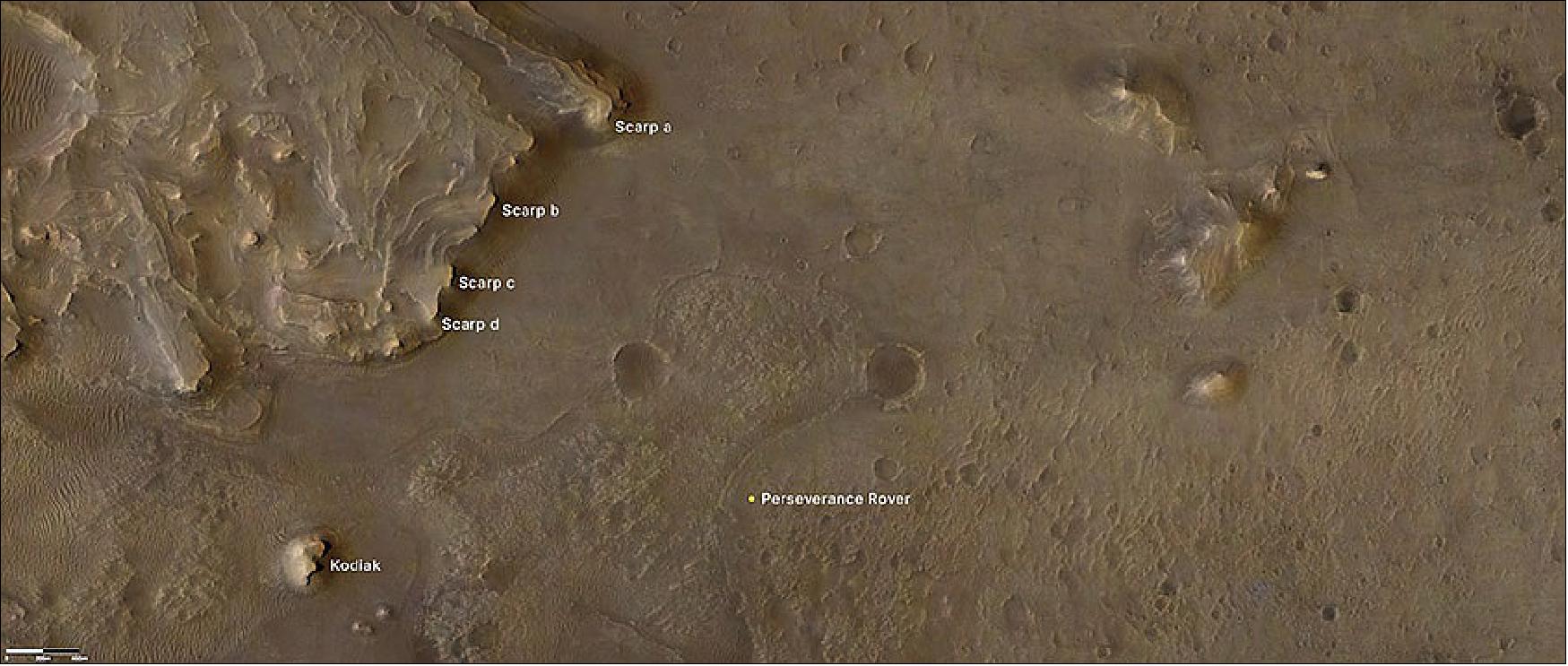
Rock–water Interactions
- The discovery: Along with once hosting surface water, Jezero Crater also sustained groundwater, which over time altered the composition of the rocks it seeped through.
e) How we know: Spectral analyses of rough rocks on the crater floor indicate the presence of iron-rich minerals and salts that were left behind when water evaporated. "The spectacular thing here is rock–water interactions," says Linda Kah, a geologist at the University of Tennessee and a mission coinvestigator. Fluid alters a rock's chemistry until the composition becomes a mixture of the original rock and the original liquid. Discrete mineral layers in a rock's pores provide information about historical episodes of water flow through the rock.
f) What we'd thought: Orbital views had indicated that there was once a lake in Jezero Crater, as well as regional raised ridges—likely part of a large fracture system—that could have provided conduits for subsurface flow. But absent closer inspection of the minerals present, that connection was inconclusive.
g) Key tools: An abrasion tool scraped weathered materials off surfaces to reveal undisturbed rock. The Scanning Habitable Environments with Raman & Luminescence for Organics & Chemicals (SHERLOC) and Wide Angle Topographic Sensor for Operations and Engineering (WATSON) cameras then used Raman scattering to identify mineral composition and image textures with high resolution.
h) What's next: The rover is collecting samples that researchers hope to eventually bring home for geochemical analysis, which could tease out the history of fluid interactions with the crater's original rock.
Dust Devils
- The discovery: Dusty convective vortices, or dust devils, lift a lot of dust into the atmosphere over the crater during spring and early summer.
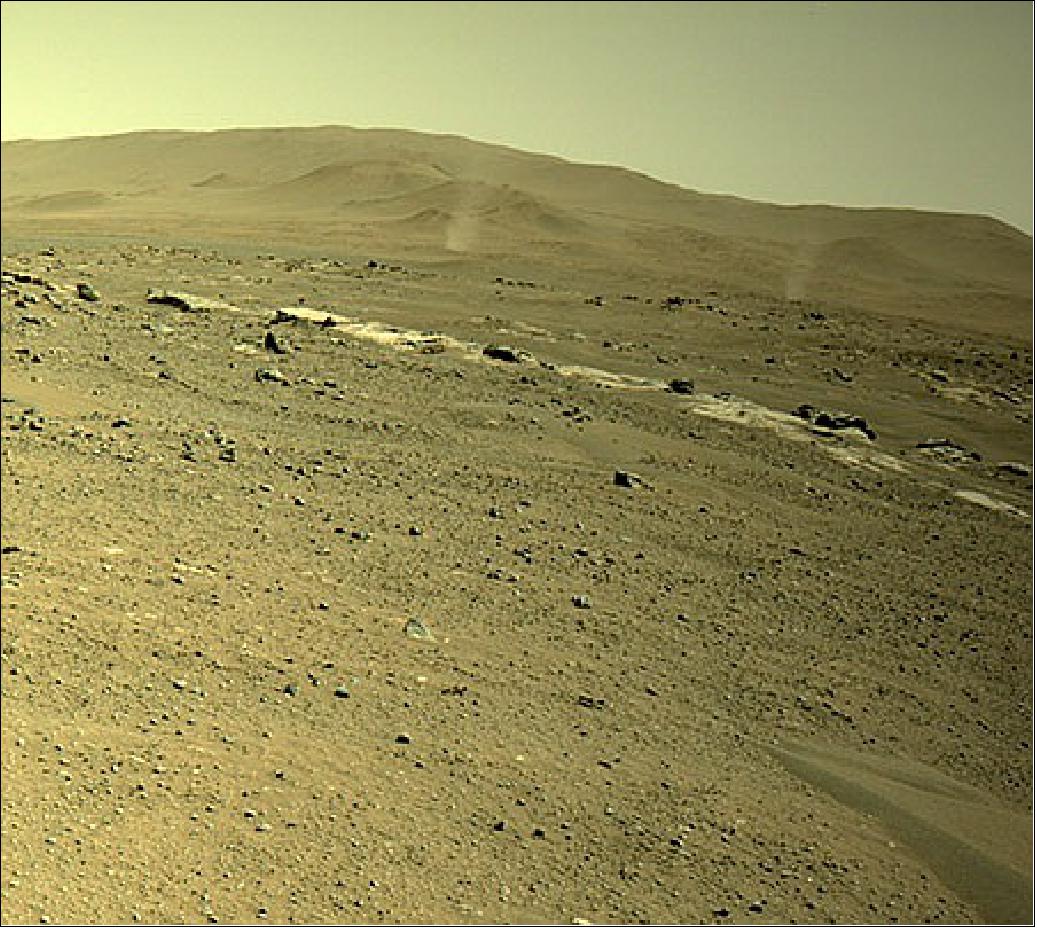
i) How we know: Rapid pressure drops and changes in wind speed and direction indicate convective vortices that can carry material aloft. Many vortices contain significant amounts of dust. "We also see dust lifting by strong wind gusts," says Claire Newman of Aeolis Research, a research organization devoted to planetary science. She is a coinvestigator on the mission who co-leads the Atmospheres Working Group. Understanding how dust is lifted outside of dust storms is important because Mars's atmosphere is always dusty, which affects temperatures and visibility on the planet and the functionality of rovers and landers.
j) What we'd thought: Other Mars missions have observed dust activity, but Perseverance is the first to carry a full toolkit to explain how background dust lifting occurs.
k) Key tools: Measurements of pressure, wind, and radiative flux by a sensor package called the Mars Environmental Dynamics Analyzer (MEDA) tracked the passage of vortices and dust devils, while cameras captured dozens of dust devils.
l) What's next: Measurements as the rover moves to new locations will show how location, season, and sol-to-sol variability influence lofting of atmospheric dust.
Wind Patterns
- The discovery: Regional- and local-scale slope winds dominate Jezero's atmospheric circulation.
m) How we know: Winds propagate from the east and southeast during the daytime and from the west and northwest at night. Those directions are consistent with winds controlled by daytime upslope and nighttime downslope flows on the slopes of the crater and of the basin where Jezero is located.
n) What we'd thought: Observations by the Curiosity rover in Gale Crater suggested that the crater's huge slopes strongly controlled the wind patterns. But the effect of the slopes had never been fully measured due to problems with making observations at night. "The [Jezero] crater's environment and Perseverance's atmospheric sensors are a match made in atmospheric and aeolian heaven," says Newman.
o) Key tools: MEDA's wind sensors revealed strong regional and local slope controls. SuperCam's microphone has provided a first "listen" of high-frequency wind variations.
p) What's next: Piecing together how the prevailing wind directions and strengths may have driven observed erosion patterns on the crater surface will help researchers interpret Martian landscape features and evolution.
Mission Status
- Perseverance is currently traversing a sand-filled region of Jezero called Séítah. The olivine-rich composition of the rocks there suggests that they have an origin different from that of the rocks studied so far. "One big effort that we're still puzzling over is the Séítah region and its relationship with the rough crater floor," says Vivian Sun, a NASA Jet Propulsion Laboratory planetary scientist and Mars 2020 campaign science co-lead. Next year the rover will travel around the crater to examine rocks in the river delta. "We want a solid story about the geology in Séítah before we get to the delta," says Sun.
• October 12, 2021: NASA, along with the European Space Agency, is developing a campaign to return the Martian samples to Earth. 3)
- On Sept. 1, NASA's Perseverance rover unfurled its arm, placed a drill bit at the Martian surface, and drilled about 2 inches (6 cm), down to extract a rock core. The rover later sealed the rock core in its tube. This historic event marked the first time a spacecraft packed up a rock sample from another planet that could be returned to Earth by future spacecraft.
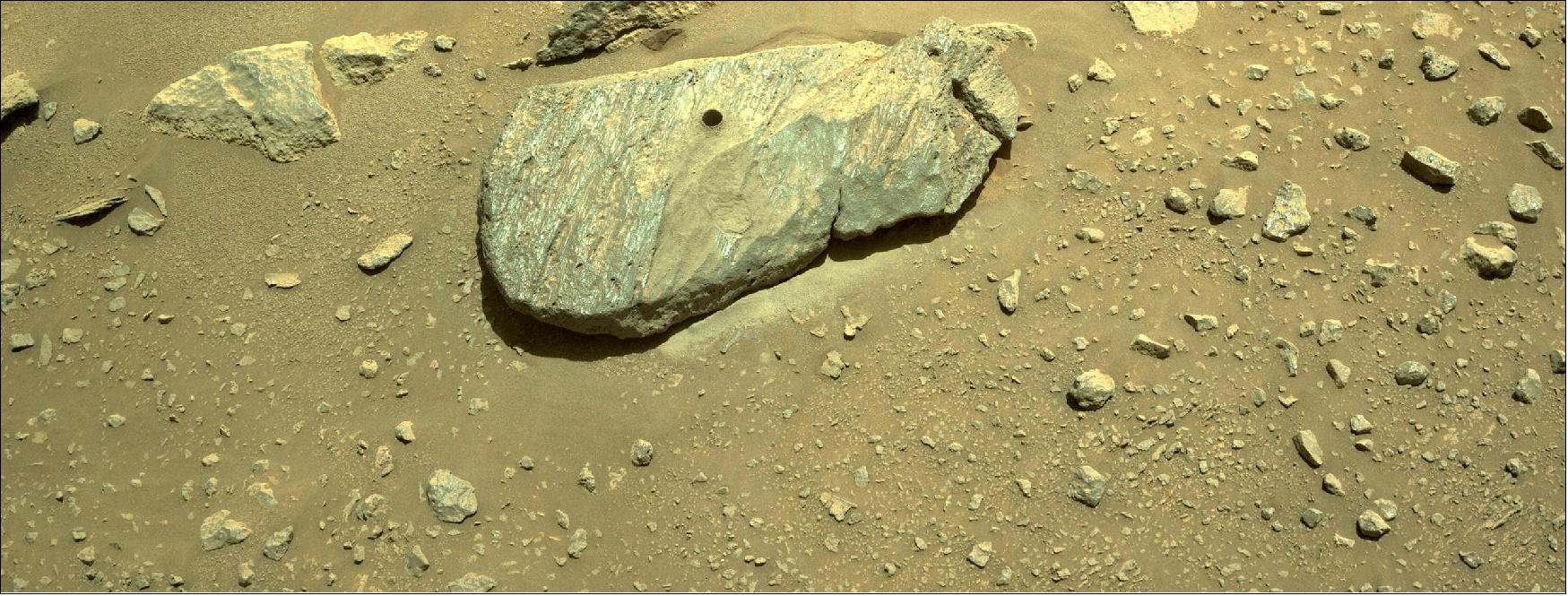
- Mars Sample Return is a multi-mission campaign designed to retrieve the cores Perseverance will collect over the next several years. Currently in the concept design and technology development phase, the campaign is one of the most ambitious endeavors in spaceflight history, involving multiple spacecraft, multiple launches, and dozens of government agencies.
- "Returning a sample from Mars has been a priority for the planetary science community since the 1980s, and the potential opportunity to finally realize this goal has unleashed a torrent of creativity," said Michael Meyer, lead scientist for NASA's Mars Exploration Program based at NASA Headquarters in Washington.

- The benefit of analyzing samples back on Earth — rather than assigning the task to a rover on the Martian surface — is that scientists can use many kinds of cutting-edge lab technologies that are too big and too complex to send to Mars. And they can do analyses much faster in the lab while providing far more information on whether life ever existed on Mars.
- "I have dreamed of having Mars samples to analyze since I was a graduate student," said Meenakshi Wadhwa, principal scientist for the Mars Sample Return program, which is managed by NASA's Jet Propulsion Laboratory in Southern California. "The collection of these well-documented samples will eventually allow us to analyze them in the best laboratories here on Earth once they are returned."
- Mars Sample Return would involve several firsts aimed at settling an open question: Has life taken root anywhere in the solar system besides Earth? "I've been working my whole career for the opportunity to answer this question," said Daniel Glavin, an astrobiologist from NASA's Goddard Space Flight Center in Greenbelt, Maryland. Glavin is helping design systems to protect the Martian samples from contamination throughout their journey from Mars to Earth.
Figure 8: Collecting samples from Mars and bringing them back to Earth will be a historic undertaking that started with the launch of NASA's Perseverance rover on July 30, 2020. Perseverance collected its first rock core samples in September 2021. The rover will leave them on Mars for a future mission to retrieve and return to Earth. NASA and the European Space Agency (ESA) are solidifying concepts for this proposed Mars Sample Return campaign. The current concept includes a lander, a fetch rover, an ascent vehicle to launch the sample container to Martian orbit, and a retrieval spacecraft with a payload for capturing and containing the samples and then sending them back to Earth to land in an unpopulated area (video credits: Animation credit: NASA/JPL-Caltech, ESA, NASA/GSFC and NASA/GRC. Technical assistance: James Tralie, NASA Goddard. Music credit: Axel Coon and Ralf Goebel of Universal Production Music)
- Being developed in collaboration with ESA (European Space Agency), Mars Sample Return would require autonomously launching a rocket full of precious extraterrestrial cargo from the surface of Mars. Engineers would need to ensure that the rocket's trajectory aligns with that of a spacecraft orbiting Mars so the sample capsule could be transferred to the orbiter. The orbiter would then return the sample capsule to Earth, where scientists would be waiting to safely contain it prior to transport to a secure biohazard facility, one that is under development now.
- Before bringing Martian samples to Earth, scientists and engineers must overcome several challenges. Here's a look at one:
Protecting Earth From Mars
- Keeping samples chemically pristine for rigorous study on Earth while subjecting their storage container to extreme sterilization measures to ensure nothing hazardous is delivered to Earth is a task that makes Mars Sample Return truly unprecedented.
- Billions of years ago the Red Planet may have had a cozy environment for life that thrives in warm and wet conditions. However, it's highly unlikely that NASA will bring back samples with living Martian organisms, based on decades of data from orbiters, landers, and rovers at Mars. Instead, scientists are hoping to find fossilized organic matter or other signs of ancient microbial life.
- Despite the low risk of bringing anything alive to Earth, an abundance of caution is driving NASA to take significant measures to ensure the Martian samples remain securely sealed throughout their journey. After collecting rock cores throughout Jezero Crater and placing them inside tubes made mostly of titanium, one of the world's strongest metals, Perseverance tightly seals the tubes to prevent the inadvertent release of even the smallest particle. The tubes are then stored in the rover's belly until NASA decides on the time and place to drop them on the Martian surface.
- A sample return campaign would include an ESA sample fetch rover that would launch from Earth later this decade to pick up these samples collected by Perseverance. Engineers at NASA's Glenn Research Center in Cleveland, Ohio, are designing the wheels for the fetch rover. The rover would transfer samples to a lander, being developed at JPL. A robotic arm on the lander would pack the samples into the tip of a rocket that is being designed by NASA's Marshall Space Flight Center in Huntsville, Alabama.
- The rocket would deliver the sample capsule to Martian orbit, where an ESA orbiter would be waiting to receive it. Inside the orbiter, the capsule would be prepared for delivery to Earth by a payload being developed by a team led by NASA Goddard. This preparation would include sealing the sample capsule inside a clean container to trap any Martian material inside, sterilizing the seal, and using a robotic arm being developed at Goddard to place the sealed container into an Earth-entry capsule before the return trip to Earth.
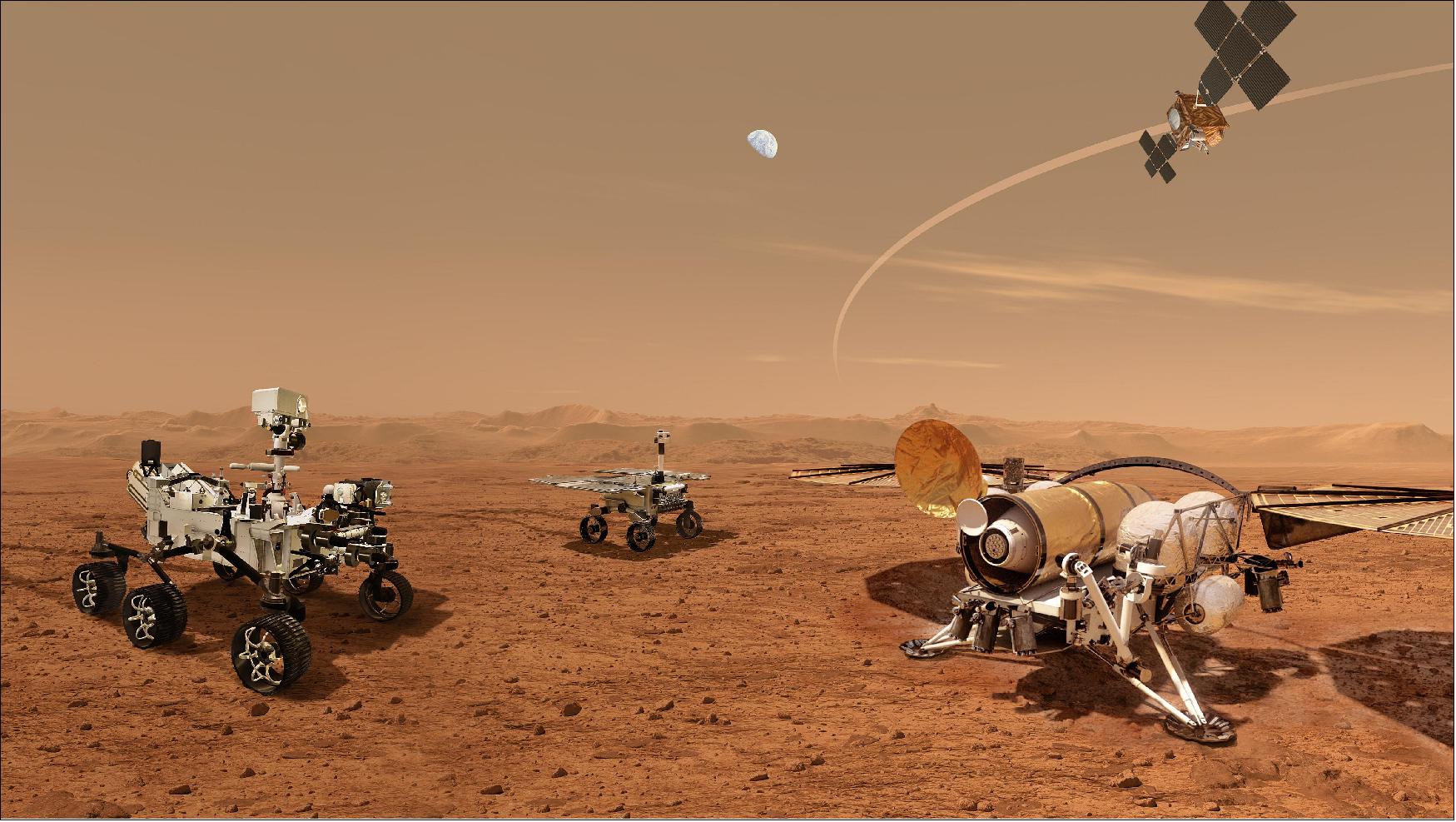
- One of the primary tasks for NASA engineers is figuring out how to seal and sterilize the sample container without obliterating important chemical signatures in the rock cores inside. Among the techniques the team is currently testing is brazing, which involves melting a metal alloy into a liquid that essentially glues metal together. Brazing can seal the sample container at a temperature high enough to sterilize any dust that might remain in the seam.
- "Among our biggest technical challenges right now is that inches away from metal that's melting at about 1,000ºF (or 538º C) we have to keep these extraordinary Mars samples below the hottest temperature they might have experienced on Mars, which is about 86ºF (30ºC )," said Brendan Feehan, the Goddard systems engineer for the system that will capture, contain, and deliver the samples to Earth aboard ESA's orbiter. "Initial results from the testing of our brazing solution have affirmed that we're on the right path."
- Careful design by Feehan and his colleagues would allow heat to be applied only to where it is needed for brazing, limiting heat flow to the samples. Additionally, engineers could insulate the samples in a material that will absorb the heat and then release it very slowly, or they could install conductors that direct the heat away from the samples.
- Whatever technique the team develops will be critical not only for the Martian samples, Glavin said, but for future sample-return missions to Europa or Enceladus, "where we could collect and return fresh ocean plume samples that could contain living extraterrestrial organisms. So we need to figure this out."
- NASA's rigorous efforts to eliminate risk of harmful contamination of Earth date to the international Outer Space Treaty of 1967, which calls on nations to prevent contaminating celestial bodies with organisms from Earth, and to prevent contamination of Earth through returned samples. To safely return a Martian sample to Earth, NASA is partnering not only with ESA, but also with at least 19 U.S. government departments and agencies, including the U.S. Centers for Disease Control and Prevention and the U.S. Department of Homeland Security.
• October 7, 2021: A new paper from the science team of NASA's Perseverance Mars rover details how the hydrological cycle of the now-dry lake at Jezero Crater is more complicated and intriguing than originally thought. The findings are based on detailed imaging the rover provided of long, steep slopes called escarpments, or scarps in the delta, which formed from sediment accumulating at the mouth of an ancient river that long ago fed the crater's lake. 4)
- Pictures from NASA's latest six-wheeler on the Red Planet suggest the area's history experienced significant flooding events.
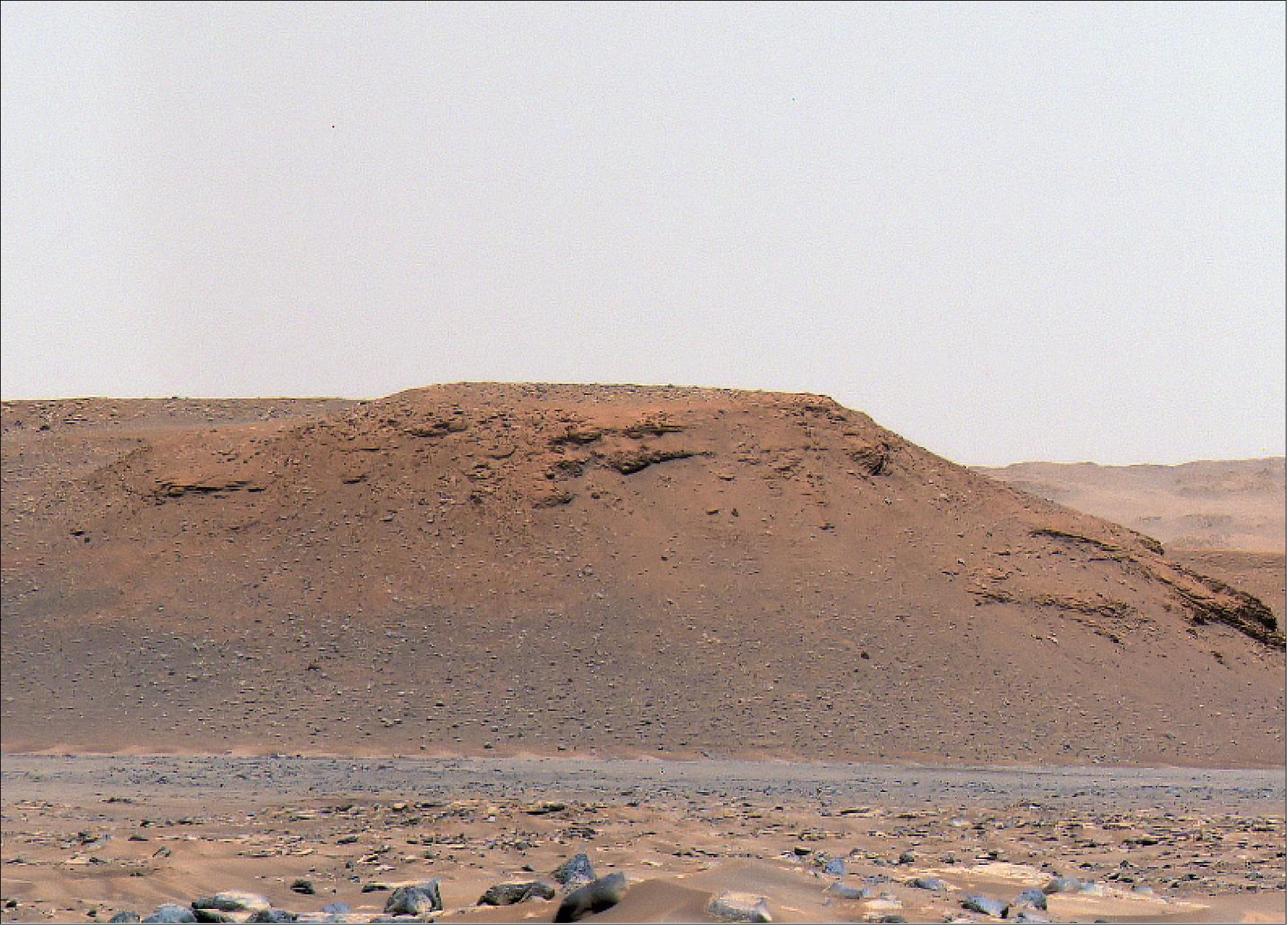
- The images reveal that billions of years ago, when Mars had an atmosphere thick enough to support water flowing across its surface, Jezero's fan-shaped river delta experienced late-stage flooding events that carried rocks and debris into it from the highlands well outside the crater.

- Taken by the rover's left and right Mastcam-Z cameras as well as its Remote Micro-Imager, or RMI (part of the SuperCam instrument), they also provide insight into where the rover could best hunt for rock and sediment samples, including those that may contain organic compounds and other evidence that life once existed there.
- The rover team has long planned to visit the delta because of its potential for harboring signs of ancient microbial life. One of the mission's primary goals is to collect samples that could be brought to Earth by the multi-mission Mars Sample Return effort, enabling scientists to analyze the material with powerful lab equipment too large to bring to Mars.
- The paper on Perseverance's scarp imagery – the first research to be published with data acquired after the rover's Feb. 18 landing – was released online today in the journal Science. 5)
Perseverance's ‘Kodiak' Moment
- At the time the images were taken, the scarps were to the northwest of the rover and about 1.2 miles (2.2 km) away. Southwest of the rover, and at about the same distance, lies another prominent rock outcrop the team calls "Kodiak." In its ancient past, Kodiak was at the southern edge of the delta, which would have been an intact geologic structure at the time.
- Prior to Perseverance's arrival, Kodiak had been imaged only from orbit. From the surface, the rover's Mastcam-Z and RMI images revealed for the first time the stratigraphy – the order and position of rock layers, which provides information about the relative timing of geological deposits – along Kodiak's eastern face. The inclined and horizontal layering there is what a geologist would expect to see in a river delta on Earth.
- "Never before has such well-preserved stratigraphy been visible on Mars," said Nicolas Mangold, a Perseverance scientist from the Laboratoire de Planétologie et Géodynamique in Nantes, France, and lead author of the paper. "This is the key observation that enables us to once and for all confirm the presence of a lake and river delta at Jezero. Getting a better understanding of the hydrology months in advance of our arrival at the delta is going to pay big dividends down the road."
- While the Kodiak results are significant, it is the tale told by the images of the scarps to the northeast that came as the greatest surprise to the rover science team.

Moving Boulders
- Imagery of those scarps showed layering similar to Kodiak's on their lower halves. But farther up each of their steep walls and on top, Mastcam-Z and RMI captured stones and boulders.
- "We saw distinct layers in the scarps containing boulders up to 5 feet [1.5 m] across that we knew had no business being there," said Mangold.
- Those layers mean the slow, meandering waterway that fed the delta must have been transformed by later, fast-moving flash floods. Mangold and the science team estimate that a torrent of water needed to transport the boulders – some for tens of miles – would have to travel at speeds ranging from 4 to 20 mph (6 to 30 km/h).
- "These results also have an impact on the strategy for the selection of rocks for sampling," said Sanjeev Gupta, a Perseverance scientist from Imperial College, London, and a co-author of the paper. "The finest-grained material at the bottom of the delta probably contains our best bet for finding evidence of organics and biosignatures. And the boulders at the top will enable us to sample old pieces of crustal rocks. Both are main objectives for sampling and caching rocks before Mars Sample Return."
A Lake of Changing Depths
- Early in the history of the Jezero Crater's former lake, its levels are thought to have been high enough to crest the crater's eastern rim, where orbital imagery shows the remains of an outflow river channel. The new paper adds to this thinking, describing the size of Jezero's lake fluctuating greatly over time, its water level rising and falling by tens of yards before the body of water eventually disappeared altogether.
- While it's unknown if these swings in the water level resulted from flooding or more gradual environmental changes, the science team has determined that they occurred later in the Jezero delta's history, when lake levels were at least 330 feet (100 meters) below the lake's highest level. And the team is looking forward to making more insights in the future: The delta will be the starting point for the rover team's upcoming second science campaign next year.
- "A better understanding of Jezero's delta is a key to understanding the change in hydrology for the area," said Gupta, "and it could potentially provide valuable insights into why the entire planet dried out."
• September 10, 2021: NASA's Perseverance Mars rover successfully collected its first pair of rock samples, and scientists already are gaining new insights into the region. After collecting its first sample, named "Montdenier," Sept. 6, the team collected a second, "Montagnac," from the same rock Sept. 8. 6)
- Analysis of the rocks from which the Montdenier and Montagnac samples were taken and from the rover's previous sampling attempt may help the science team piece together the timeline of the area's past, which was marked by volcanic activity and periods of persistent water.
- "It looks like our first rocks reveal a potentially habitable sustained environment," said Ken Farley of Caltech, project scientist for the mission, which is led by NASA's Jet Propulsion Laboratory in Southern California. "It's a big deal that the water was there a long time."
- The rock that provided the mission's first core samples is basaltic in composition and may be the product of lava flows. The presence of crystalline minerals in volcanic rocks is especially helpful in radiometric dating. The volcanic origin of the rock could help scientists accurately date when it formed. Each sample can serve as part of a larger chronological puzzle; put them in the right order, and scientists have a timeline of the most important events in the crater's history. Some of those events include the formation of Jezero Crater, the emergence and disappearance of Jezero's lake, and changes to the planet's climate in the ancient past.
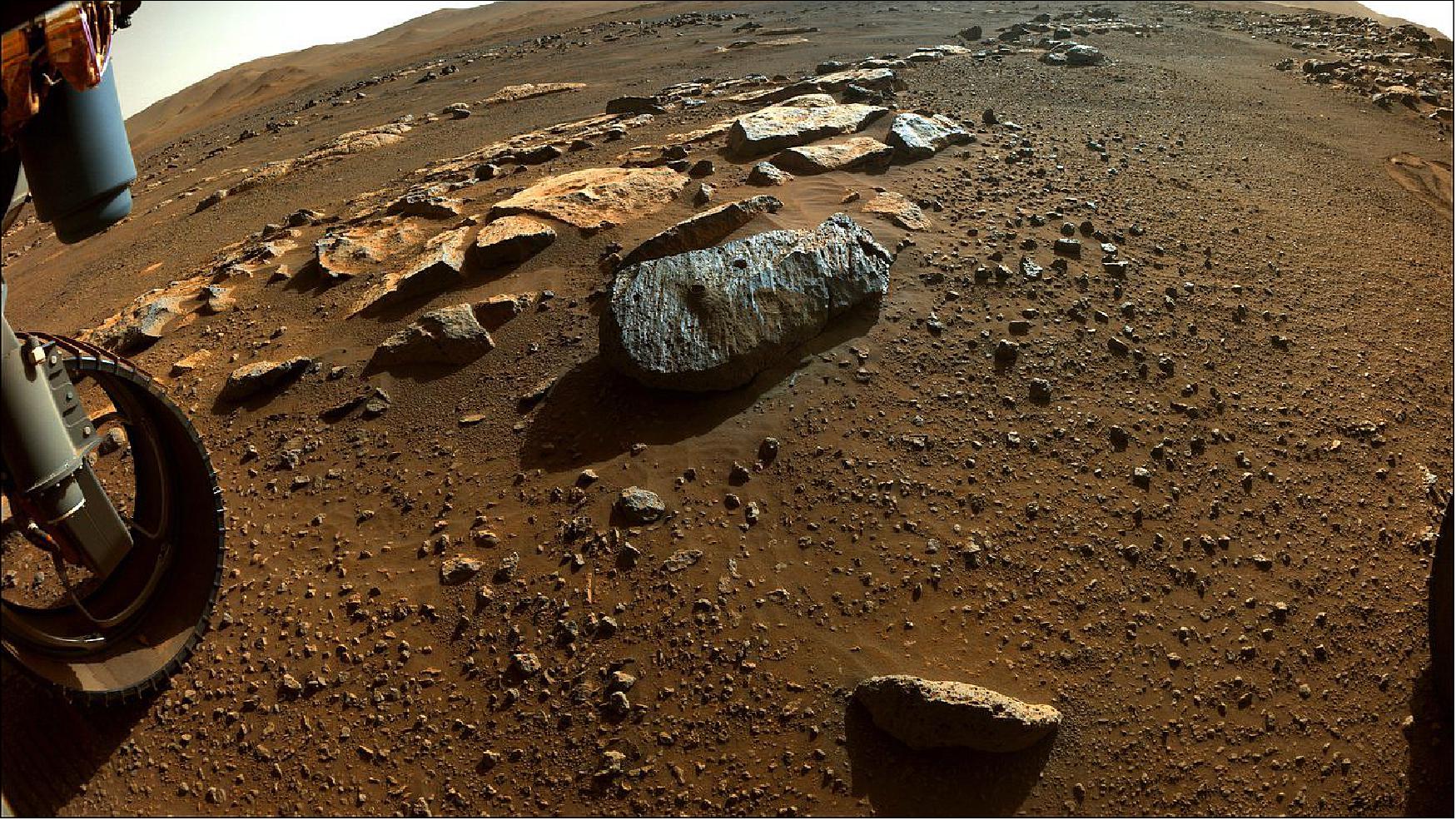

- What's more, salts have been spied within these rocks. These salts may have formed when groundwater flowed through and altered the original minerals in the rock, or more likely when liquid water evaporated, leaving the salts. The salt minerals in these first two rock cores may also have trapped tiny bubbles of ancient Martian water. If present, they could serve as microscopic time capsules, offering clues about the ancient climate and habitability of Mars. Salt minerals are also well-known on Earth for their ability to preserve signs of ancient life.
- The Perseverance science team already knew a lake once filled the crater; for how long has been more uncertain. The scientists couldn't dismiss the possibility that Jezero's lake was a "flash in the pan": Floodwaters could have rapidly filled the impact crater and dried up in the space of 50 years, for example.
- But the level of alteration that scientists see in the rock that provided the core samples – as well as in the rock the team targeted on their first sample-acquisition attempt – suggests that groundwater was present for a long time.
- This groundwater could have been related to the lake that was once in Jezero, or it could have traveled through the rocks long after the lake had dried up. Though scientists still can't say whether any of the water that altered these rocks was present for tens of thousands or for millions of years, they feel more certain that it was there for long enough to make the area more welcoming to microscopic life in the past.
- "These samples have high value for future laboratory analysis back on Earth," said Mitch Schulte of NASA Headquarters, the mission's program scientist. "One day, we may be able to work out the sequence and timing of the environmental conditions that this rock's minerals represent. This will help answer the big-picture science question of the history and stability of liquid water on Mars."
Next Stop, ‘South Séítah'
- Perseverance is currently searching the crater floor for samples that can be brought back to Earth to answer profound questions about Mars' history. Promising samples are sealed in titanium tubes the rover carries in its chassis, where they'll be stored until Perseverance drops them to be retrieved by a future mission. Perseverance will likely create multiple "depots" later in the mission, where it will drop off samples for a future mission to bring to Earth. Having one or more depots increases the likelihood that especially valuable samples will be accessible for retrieval to Earth.
- Perseverance's next likely sample site is just 200 meters away in "South Séítah," a series of ridges covered by sand dunes, boulders, and rock shards that Farley likens to "broken dinner plates."
- The rover's recent drill sample represents what is likely one of the youngest rock layers that can be found on Jezero Crater's floor. South Séítah, on the other hand, is likely older, and will provide the science team a better timeline to understand events that shaped the crater floor, including its lake.
- By the start of October, all Mars missions will be standing down from commanding their spacecraft for several weeks, a protective measure during a period called Mars solar conjunction. Perseverance isn't likely to drill in South Séítah until sometime after that period.
• August 6, 2021: The rover continues to explore Jezero Crater while the team assesses today's activities. Data sent to Earth by NASA's Perseverance rover after its first attempt to collect a rock sample on Mars and seal it in a sample tube indicate that no rock was collected during the initial sampling activity. 7)
- The rover carries 43 titanium sample tubes and is exploring Jezero Crater, where it will be gathering samples of rock and regolith (broken rock and dust) for future analysis on Earth.
- "While this is not the ‘hole-in-one' we hoped for, there is always risk with breaking new ground," said Thomas Zurbuchen, associate administrator of NASA's Science Mission Directorate in Washington. "I'm confident we have the right team working this, and we will persevere toward a solution to ensure future success."
- Perseverance's Sampling and Caching System uses a hollow coring bit and a percussive drill at the end of its 2-meter-long robotic arm to extract samples. Telemetry from the rover indicates that during its first coring attempt, the drill and bit were engaged as planned, and post-coring, the sample tube was processed as intended.
- "The sampling process is autonomous from beginning to end," said Jessica Samuels, the surface mission manager for Perseverance at NASA's Jet Propulsion Laboratory in Southern California. "One of the steps that occurs after placing a probe into the collection tube is to measure the volume of the sample. The probe did not encounter the expected resistance that would be there if a sample were inside the tube."
- The Perseverance mission is assembling a response team to analyze the data. One early step will be to use the WATSON (Wide Angle Topographic Sensor for Operations and eNgineering) imager – located at the end of the robotic arm – to take close-up pictures of the borehole. Once the team has a better understanding of what happened, it will be able to ascertain when to schedule the next sample collection attempt.
- "The initial thinking is that the empty tube is more likely a result of the rock target not reacting the way we expected during coring, and less likely a hardware issue with the Sampling and Caching System," said Jennifer Trosper, project manager for Perseverance at JPL. "Over the next few days, the team will be spending more time analyzing the data we have, and also acquiring some additional diagnostic data to support understanding the root cause for the empty tube."
- Previous NASA missions on Mars have also encountered surprising rock and regolith properties during sample collection and other activities. In 2008, the Phoenix mission sampled soil that was "sticky" and difficult to move into onboard science instruments, resulting in multiple tries before achieving success. Curiosity has drilled into rocks that turned out to be harder and more brittle than expected. Most recently, the heat probe on the InSight lander, known as the "mole," was unable to penetrate the Martian surface as planned.
- "I have been on every Mars rover mission since the beginning, and this planet is always teaching us what we don't know about it," said Trosper. "One thing I've found is, it's not unusual to have complications during complex, first-time activities."

First Science Campaign
- Perseverance is currently exploring two geologic units containing Jezero Crater's deepest and most ancient layers of exposed bedrock and other intriguing geologic features. The first unit, called the "Crater Floor Fractured Rough," is the floor of Jezero. The adjacent unit, named "Séítah" (meaning "amidst the sand" in the Navajo language), has Mars bedrock as well, and is also home to ridges, layered rocks, and sand dunes.
- Recently, the Perseverance science team began using color images from the Ingenuity Mars Helicopter to help scout for areas of potential scientific interest and to look for potential hazards. Ingenuity completed its 11th flight Wednesday, Aug. 4, traveling about 380 meters downrange of its current location so that it could provide the project aerial reconnaissance of the southern Séítah area.
- The rover's initial science foray, which spans hundreds of sols (or Martian days), will be complete when Perseverance returns to its landing site. At that point, Perseverance will have traveled between 2.5 and 5 kilometers and may have filled up to eight of its sample tubes.
- Next, Perseverance will travel north, then west, toward the location of its second science campaign: Jezero Crater's delta region. The delta is the fan-shaped remains of the confluence of an ancient river and a lake within Jezero Crater. The region may be especially rich in carbonate minerals. On Earth, such minerals can preserve fossilized signs of ancient microscopic life and are associated with biological processes.
• July 20, 2021: After testing a bristling array of instruments on its robotic arm, NASA's latest Mars rover gets down to business: probing rocks and dust for evidence of past life. 8)
Figure 16: The robotic arm on NASA's Perseverance rover reached out to examine rocks in an area on Mars nicknamed the "Cratered Floor Fractured Rough" area in this image captured on July 10, 2021 (the 138th sol, or Martian day, of its mission), image credit: NASA/JPL-Caltech
- NASA's Mars 2020 Perseverance rover has begun its search for signs of ancient life on the Red Planet. Flexing its 2-meter mechanical arm, the rover is testing the sensitive detectors it carries, capturing their first science readings. Along with analyzing rocks using X-rays and ultraviolet light, the six-wheeled scientist will zoom in for closeups of tiny segments of rock surfaces that might show evidence of past microbial activity.
- Called PIXL (Planetary Instrument for X-ray Lithochemistry) the rover's X-ray instrument delivered unexpectedly strong science results while it was still being tested, said Abigail Allwood, PIXL's principal investigator at NASA's Jet Propulsion Laboratory in Southern California. Located at the end of the arm, the lunchbox-size instrument fired its X-rays at a small calibration target – used to test instrument settings – aboard Perseverance and was able to determine the composition of Martian dust clinging to the target.
- "We got our best-ever composition analysis of Martian dust before it even looked at rock," Allwood said.
- That's just a small taste of what PIXL, combined with the arm's other instruments, is expected to reveal as it zeroes in on promising geological features over the weeks and months ahead.
- Scientists say Jezero Crater was a crater lake billions of years ago, making it a choice landing site for Perseverance. The crater has long since dried out, and the rover is now picking its way across its red, broken floor.
- "If life was there in Jezero Crater, the evidence of that life could be there," said Allwood, a key member of the Perseverance "arm science" team.
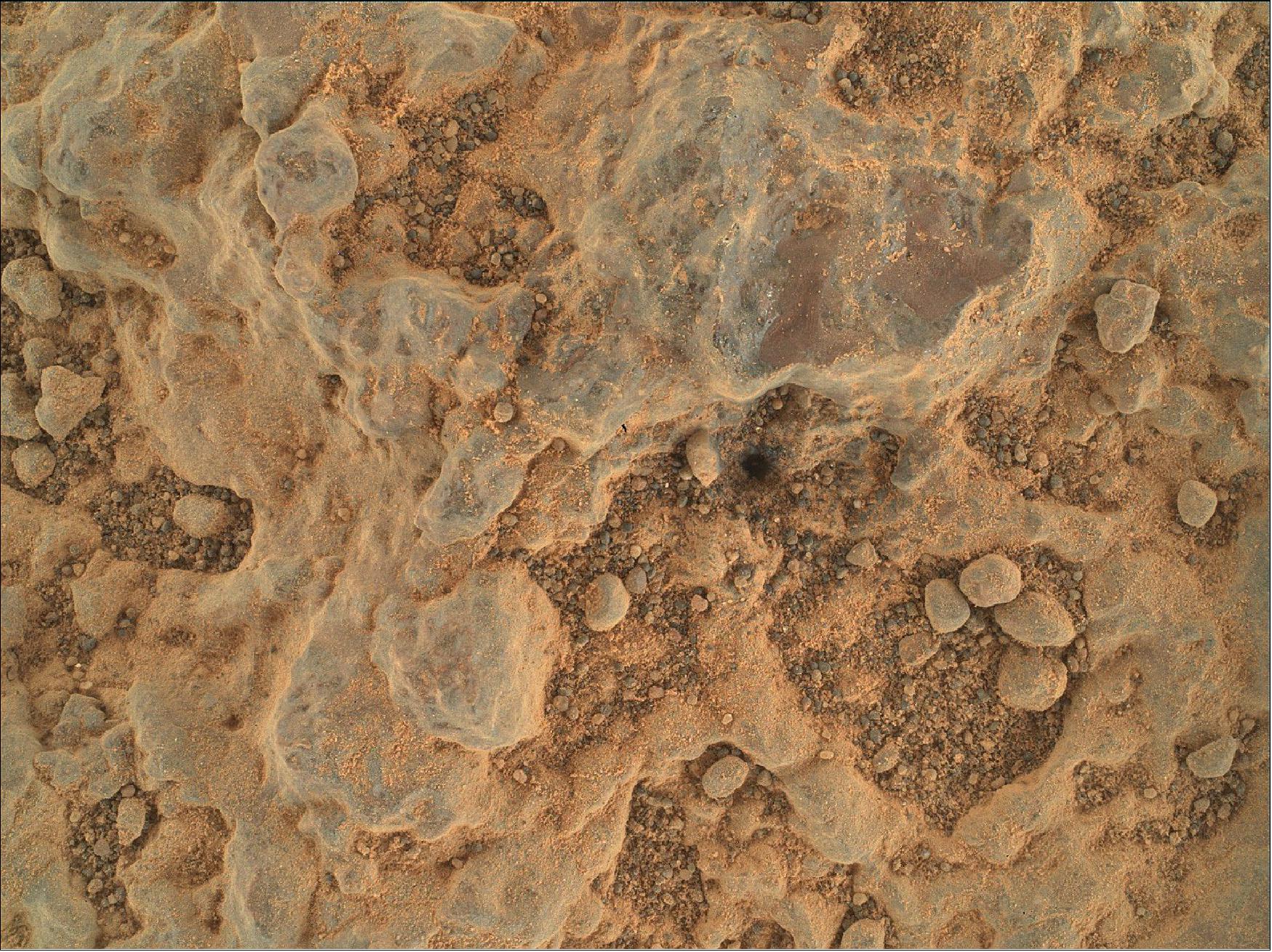
- To get a detailed profile of rock textures, contours, and composition, PIXL's maps of the chemicals throughout a rock can be combined with mineral maps produced by the SHERLOC instrument and its partner, WATSON. SHERLOC – short for Scanning Habitable Environments with Raman & Luminescence for Organics & Chemicals – uses an ultraviolet laser to identify some of the minerals in the rock, while WATSON takes closeup images that scientists can use to determine grain size, roundness, and texture, all of which can help determine how the rock was formed.

- Early WATSON closeups have already yielded a trove of data from Martian rocks, the scientists said, such as a variety of colors, sizes of grains in the sediment, and even the presence of "cement" between the grains. Such details can provide important clues about formation history, water flow, and ancient, potentially habitable Martian environments. And combined with those from PIXL, they can provide a broader environmental and even historical snapshot of Jezero Crater.
- "What is the crater floor made out of? What were the conditions like on the crater floor?" asks Luther Beegle of JPL, SHERLOC's principal investigator. "That does tell us a lot about the early days of Mars, and potentially how Mars formed. If we have an idea of what the history of Mars is like, we'll be able to understand the potential for finding evidence of life."
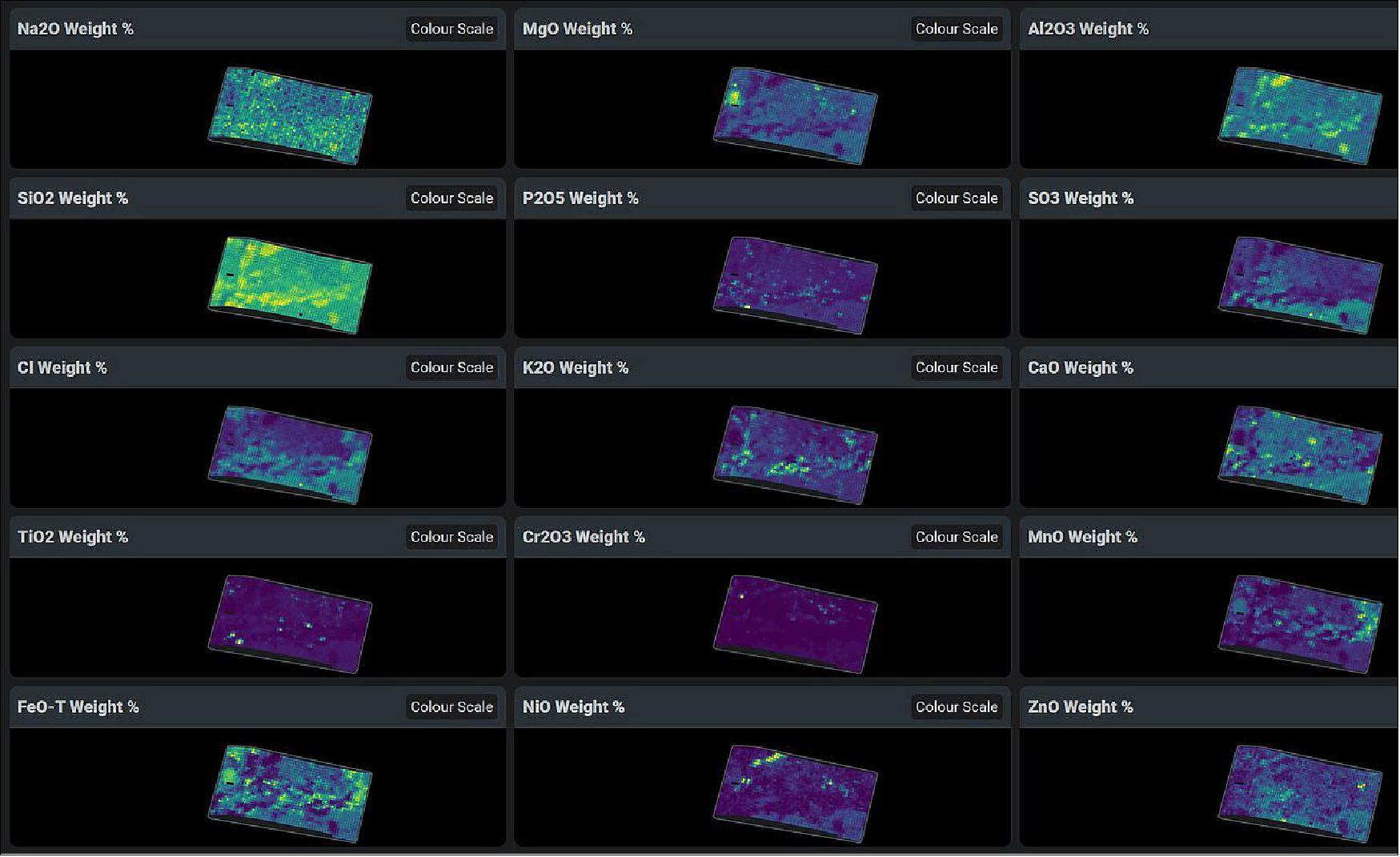
The Science Team
- While the rover has significant autonomous capabilities, such as driving itself across the Martian landscape, hundreds of earthbound scientists are still involved in analyzing results and planning further investigations.
- "There are almost 500 people on the science team," Beegle said. "The number of participants in any given action by the rover is on the order of 100. It's great to see these scientists come to agreement in analyzing the clues, prioritizing each step, and putting together the pieces of the Jezero science puzzle."
- That will be critical when the Mars 2020 Perseverance rover collects its first samples for eventual return to Earth. They'll be sealed in superclean metallic tubes on the Martian surface so that a future mission could collect them and send back to the home planet for further analysis.
- Despite decades of investigation on the question of potential life, the Red Planet has stubbornly kept its secrets.
- "Mars 2020, in my view, is the best opportunity we will have in our lifetime to address that question," said Kenneth Williford, the deputy project scientist for Perseverance.
- The geological details are critical, Allwood said, to place any indication of possible life in context, and to check scientists' ideas about how a second example of life's origin could come about.
- Combined with other instruments on the rover, the detectors on the arm, including SHERLOC and WATSON, could make humanity's first discovery of life beyond Earth.
• July 12, 2021: Ingenuity's ninth flight provided imagery that will help the Perseverance rover team develop its science plan going forward. 9)
- Images snapped on July 5 by NASA's Ingenuity Mars Helicopter on its ambitious ninth flight have offered scientists and engineers working with the agency's Perseverance Mars rover an unprecedented opportunity to scout out the road ahead. Ingenuity provided new insight into where different rock layers begin and end, each layer serving as a time capsule for how conditions in the ancient climate changed at this location. The flight also revealed obstacles the rover may have to drive around as it explores Jezero Crater.
- During the flight – designed to test the helicopter's ability to serve as an aerial scout – Ingenuity soared over a dune field nicknamed "Séítah." Perseverance is making a detour south around those dunes, which would be too risky for the six-wheeled rover to try crossing.
- The color images from Ingenuity, taken from a height of around 33 feet (10 meters), offer the rover team much greater detail than they get from the orbiter images they typically use for route planning. While a camera like HiRISE (High Resolution Imaging Science Experiment) aboard NASA's Mars Reconnaissance Orbiter can resolve rocks about 3 feet (1 meter) in diameter, missions usually rely on rover images to see smaller rocks or terrain features.
- "Once a rover gets close enough to a location, we get ground-scale images that we can compare to orbital images," said Perseverance Deputy Project Scientist Ken Williford of NASA's Jet Propulsion Laboratory in Southern California. "With Ingenuity, we now have this intermediate-scale imagery that nicely fills the gap in resolution."
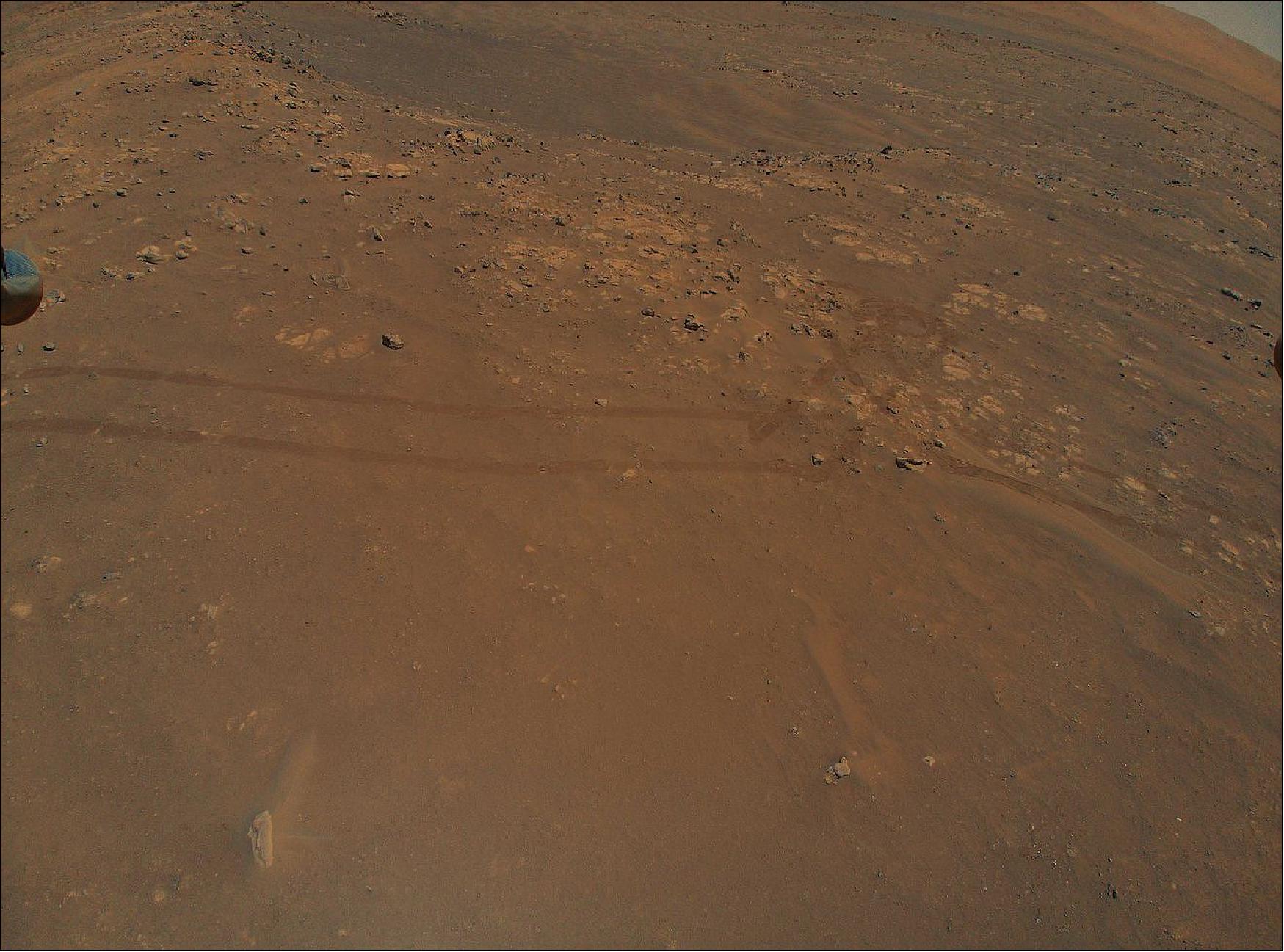
- Below are a few of Ingenuity's images, which completed the long journey back to Earth on July 8.

- Here in Jezero Crater, a lake existed billions of years ago. Spying the ridges in images from Mars orbiters, scientists have wondered whether water might have flowed through these fractures at some point, dissolving minerals that could help feed ancient microbial colonies. That would make them a prime location to look for signs of ancient life – and perhaps to drill a sample.
- The samples Perseverance takes will eventually be deposited on Mars for a future mission that would take them to Earth for in-depth analysis.
- "Our current plan is to visit Raised Ridges and investigate it close up," Williford said. "The helicopter's images are by far better in resolution than the orbital ones we were using. Studying these will allow us to ensure that visiting these ridges is important to the team."

- Sand dunes like the ones in this image keep rover drivers like JPL's Olivier Toupet awake at night: Knee- or waist-high, they could easily cause the two-ton rover to get stuck. After landing in February, Perseverance scientists asked whether it was possible to make a beeline across this terrain; Toupet's answer was a hard no.
- "Sand is a big concern," said Toupet, who leads the team of mobility experts that plans Perseverance's drives. "If we drive downhill into a dune, we could embed ourselves into it and not be able to get back out."
- Toupet is also the lead for Perseverance's newly tested AutoNav feature, which uses artificial intelligence algorithms to drive the rover autonomously over greater distances than could be achieved otherwise. While good at avoiding rocks and other hazards, AutoNav can't detect sand, so human drivers still need to define "keep-out zones" around areas that could entrap the rover.
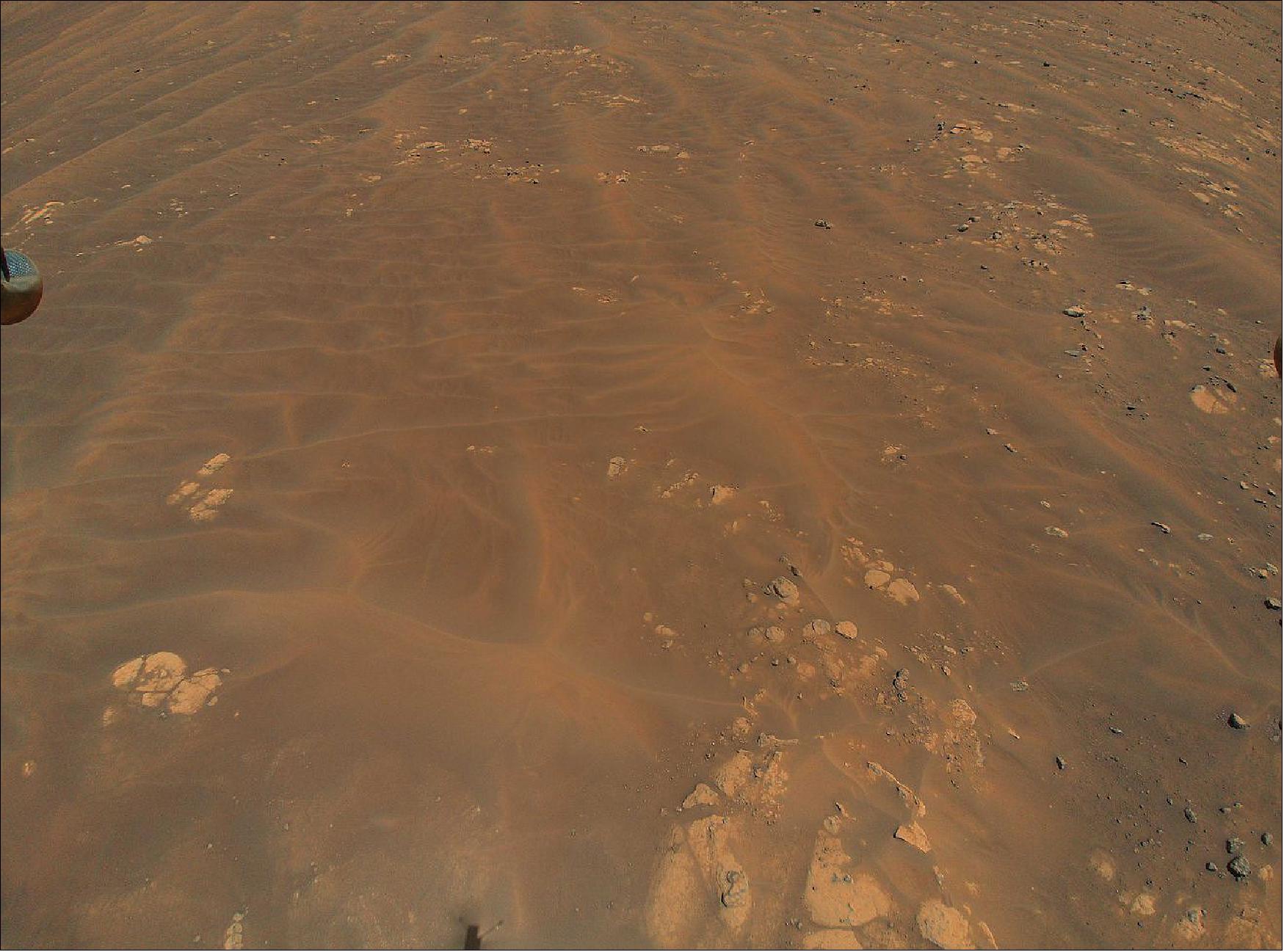
- Without Ingenuity, visible in silhouette at the bottom of this next image, Perseverance's scientists would never get to see this section of Séítah so clearly: It's too sandy for Perseverance to visit. The unique view offers enough detail to inspect these rocks and get a better understanding of this area of Jezero Crater.
- As the rover works its way around the dune field, it may make what the team calls a "toe dip" into some scientifically compelling spots with interesting bedrock. While Toupet and his team wouldn't attempt a toe dip here, the recent images from Ingenuity will allow them to plan potential toe-dip paths in other regions along the route of Perseverance's first science campaign.
- "The helicopter is an extremely valuable asset for rover planning because it provides high-resolution imagery of the terrain we want to drive through," said Toupet. "We can better assess the size of the dunes and where bedrock is poking out. That's great information for us; it helps identify which areas may be traversable by the rover and whether certain high-value science targets are reachable."
• June 9, 2021: The six-wheeled rover is heading south to explore Jezero Crater's lakebed in search of signs of ancient microbial life. 10)
Figure 24: NASA's Perseverance Mars rover used its Mastcam-Z imaging system to capture this 360-degree panorama of "Van Zyl Overlook," where the rover was parked as the Ingenuity helicopter performed its first flights (video credit: NASA/JPL-Caltech/ASU/MSSS)
- On June 1, NASA's Perseverance Mars rover kicked off the science phase of its mission by leaving the "Octavia E. Butler" landing site. Until recently, the rover has been undergoing systems tests, or commissioning, and supporting the Ingenuity Mars Helicopter's month of flight tests.
- During the first few weeks of this first science campaign, the mission team will drive to a low-lying scenic overlook from which the rover can survey some of the oldest geologic features in Jezero Crater, and they'll bring online the final capabilities of the rover's auto-navigation and sampling systems.
- By the time Perseverance completed its commissioning phase on June 1, the rover had already tested its oxygen-generating MOXIE instrument and conducted the technology demonstration flights of the Ingenuity helicopter. Its cameras had taken more than 75,000 images, and its microphones had recorded the first audio soundtracks of Mars.
- "We are putting the rover's commissioning phase as well as the landing site in our rearview mirror and hitting the road," said Jennifer Trosper, Perseverance project manager at NASA's Jet Propulsion Laboratory in Southern California. "Over the next several months, Perseverance will be exploring a 1.5-square-mile [4 km2] patch of crater floor. It is from this location that the first samples from another planet will be collected for return to Earth by a future mission."
- The science goals of the mission are to study the Jezero region in order to understand the geology and past habitability of the environment in the area, and to search for signs of ancient microscopic life. The team will identify and collect the most compelling rock and sediment samples, which a future mission could retrieve and bring back to Earth for more detailed study. Perseverance will also take measurements and test technologies to support future human and robotic exploration of Mars.
Unique Geology
- Spanning hundreds of sols (or Martian days), this first science campaign will pursue all of the mission's science goals as the rover explores two unique geologic units in which Jezero's deepest (and most ancient) layers of exposed bedrock and other intriguing geologic features can be found. The first unit, called "the Crater Floor Fractured Rough," is the crater-filled floor of Jezero. The adjacent unit, named "Séítah" (meaning "amidst the sand" in the Navajo language), has its fair share of Mars bedrock but is also home to ridges, layered rocks, and sand dunes.
- "To do justice to both units in the time allotted, the team came up with the Martian version of an old auto club-style map," said JPL's Kevin Hand, an astrobiologist and co-lead, along with Vivian Sun, of this science campaign. "We have our route planned, complete with optional turnoffs and labeled areas of interest and potential obstructions in our path."
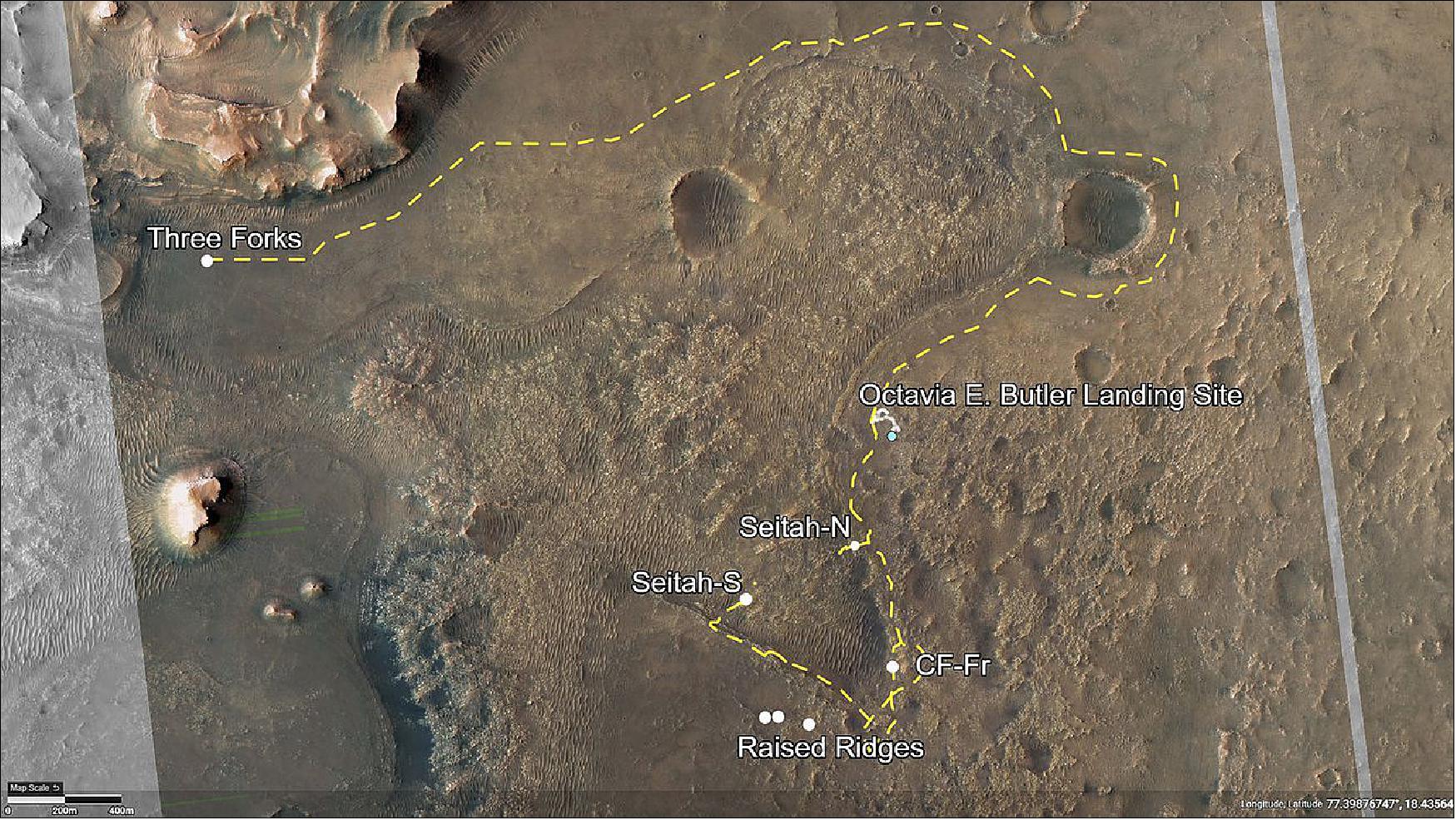
- Most of the challenges along the way are expected to come in the form of sand dunes located within the mitten-shaped Séítah unit. To negotiate them, the rover team decided Perseverance will drive mostly either on the Crater Floor Fractured Rough or along the boundary line between it and Séítah. When the occasion calls for it, Perseverance will perform a "toe dip" into the Séítah unit, making a beeline for a specific area of interest.
- The goal of the campaign is to establish what four locations in these units best tell the story of Jezero Crater's early environment and geologic history. When the science team decides a location is just right, they will collect one or two samples.
- "Starting with the Crater Floor Fractured Rough and Seitah geologic units allows us to start our exploration of Jezero at the very beginning," said Hand. "This area was under at least 100 meters [328 feet] of water 3.8 billion years ago. We don't know what stories the rocks and layered outcrops will tell us, but we're excited to get started."
- The first science campaign will be complete when the rover returns to its landing site. At that point, Perseverance will have traveled between 1.6 and 3.1 miles (2.5 and 5 kilometers) and up to eight of Perseverance's 43 sample tubes could be filled with Mars rock and regolith (broken rock and dust). Next, Perseverance will travel north then west toward the location of its second science campaign: Jezero's delta region. The delta is the fan-shaped remains of the confluence of an ancient river and a lake within Jezero Crater. The location may be especially rich in carbonates – minerals that, on Earth, can preserve fossilized signs of ancient life and can be associated with biological processes.
- The start of Perseverance's first science campaign also marks a transition on the team: On June 7, Jennifer Trosper became the mission's new project manager. She succeeds Matt Wallace, who is moving on to become JPL's Deputy Director for Planetary Science.
- "From Sojourner to Spirit and Opportunity to Curiosity to Perseverance, Matt has played key roles in the design, construction, and operations of every Mars rover NASA has ever built," said Trosper. "And while the project is losing a great leader and trusted friend, we know Matt will continue making great things happen for the planetary science community."
• May 27, 2021: On the 91st Martian day, or sol, of NASA's Mars 2020 Perseverance rover mission, the Ingenuity Mars Helicopter performed its sixth flight. The flight was designed to expand the flight envelope and demonstrate aerial-imaging capabilities by taking stereo images of a region of interest to the west. Ingenuity was commanded to climb to an altitude of 10 m before translating 150 m to the southwest at a ground speed of 4 m/s. At that point, it was to translate 15 m to the south while taking images toward the west, then fly another 50 m northeast and land. 11)
- Telemetry from Flight Six shows that the first 150 meter leg of the flight went off without a hitch. But toward the end of that leg, something happened: Ingenuity began adjusting its velocity and tilting back and forth in an oscillating pattern. This behavior persisted throughout the rest of the flight. Prior to landing safely, onboard sensors indicated the rotorcraft encountered roll and pitch excursions of more than 20 degrees, large control inputs, and spikes in power consumption.
Figure 26: This sequence of images – taken on May 22, 2021, by the navigation camera aboard NASA's Ingenuity Mars Helicopter – depicts the last 29 seconds of the rotorcraft's sixth flight. Frame rate is 3.3 frames per second until Ingenuity began its final descent to the surface, at which point it collected a frame every two seconds (video credit:: NASA/JPL-Caltech)
How Ingenuity Estimates Motion
- While airborne, Ingenuity keeps track of its motion using an onboard inertial measurement unit (IMU). The IMU measures Ingenuity's accelerations and rotational rates. By integrating this information over time, it is possible to estimate the helicopter's position, velocity, and attitude (where it is, how fast it is moving, and how it is oriented in space). The onboard control system reacts to the estimated motions by adjusting control inputs rapidly (at a rate of 500 times per second).
- If the navigation system relied on the IMU alone, it would not be very accurate in the long run: Errors would quickly accumulate, and the helicopter would eventually lose its way. To maintain better accuracy over time, the IMU-based estimates are nominally corrected on a regular basis, and this is where Ingenuity's navigation camera comes in. For the majority of time airborne, the downward-looking navcams takes 30 pictures a second of the Martian surface and immediately feeds them into the helicopter's navigation system. Each time an image arrives, the navigation system's algorithm performs a series of actions: First, it examines the timestamp that it receives together with the image in order to determine when the image was taken. Then, the algorithm makes a prediction about what the camera should have been seeing at that particular point in time, in terms of surface features that it can recognize from previous images taken moments before (typically due to color variations and protuberances like rocks and sand ripples). Finally, the algorithm looks at where those features actually appear in the image. The navigation algorithm uses the difference between the predicted and actual locations of these features to correct its estimates of position, velocity, and attitude.
Flight Six Anomaly
- Approximately 54 seconds into the flight, a glitch occurred in the pipeline of images being delivered by the navigation camera. This glitch caused a single image to be lost, but more importantly, it resulted in all later navigation images being delivered with inaccurate timestamps. From this point on, each time the navigation algorithm performed a correction based on a navigation image, it was operating on the basis of incorrect information about when the image was taken. The resulting inconsistencies significantly degraded the information used to fly the helicopter, leading to estimates being constantly "corrected" to account for phantom errors. Large oscillations ensued.
Surviving the Anomaly
- Despite encountering this anomaly, Ingenuity was able to maintain flight and land safely on the surface within approximately 5 meters of the intended landing location. One reason it was able to do so is the considerable effort that has gone into ensuring that the helicopter's flight control system has ample "stability margin": We designed Ingenuity to tolerate significant errors without becoming unstable, including errors in timing. This built-in margin was not fully needed in Ingenuity's previous flights, because the vehicle's behavior was in-family with our expectations, but this margin came to the rescue in Flight Six.
- Another design decision also played a role in helping Ingenuity land safely. As I've written about before, we stop using navigation camera images during the final phase of the descent to landing to ensure smooth and continuous estimates of the helicopter motion during this critical phase. That design decision also paid off during Flight Six: Ingenuity ignored the camera images in the final moments of flight, stopped oscillating, leveled its attitude, and touched down at the speed as designed.
- Looking at the bigger picture, Flight Six ended with Ingenuity safely on the ground because a number of subsystems – the rotor system, the actuators, and the power system – responded to increased demands to keep the helicopter flying. In a very real sense, Ingenuity muscled through the situation, and while the flight uncovered a timing vulnerability that will now have to be addressed, it also confirmed the robustness of the system in multiple ways.
- While we did not intentionally plan such a stressful flight, NASA now has flight data probing the outer reaches of the helicopter's performance envelope. That data will be carefully analyzed in the time ahead, expanding our reservoir of knowledge about flying helicopters on Mars.
• May 11, 2021: NASA's Perseverance rover has been busy serving as a communications base station for the Ingenuity Mars Helicopter and documenting the rotorcraft's historic flights. But the rover has also been busy focusing its science instruments on rocks that lay on the floor of Jezero Crater. 12)
- What insights they turn up will help scientists create a timeline of when an ancient lake formed there, when it dried, and when sediment began piling up in the delta that formed in the crater long ago. Understanding this timeline should help date rock samples – to be collected later in the mission – that might preserve a record of ancient microbes.
Figure 27: NASA's Perseverance Mars rover used the WATSON camera on the end of its robotic arm to conduct a focus test on May 10, 2021, the 79th Martian day, or sol, of the mission (video credit: NASA/JPL-Caltech/MSSS)
- A camera called WATSON on the end of the rover's robotic arm has taken detailed shots of the rocks. A pair of zoomable cameras that make up the Mastcam-Z imager on the rover's "head" has also surveyed the terrain. And a laser instrument called SuperCam has zapped some of the rocks to detect their chemistry. These instruments and others allow scientists to learn more about Jezero Crater and to home in on areas they might like to study in greater depth.


- One important question scientists want to answer: whether these rocks are sedimentary (like sandstone) or igneous (formed by volcanic activity). Each type of rock tells a different kind of story. Some sedimentary rocks – formed in the presence of water from rock and mineral fragments like sand, silt, and clay – are better suited to preserving biosignatures, or signs of past life. Igneous rocks, on the other hand, are more precise geological clocks that allow scientists to create an accurate timeline of how an area formed.
- One complicating factor is that the rocks around Perseverance have been eroded by wind over time and covered with younger sand and dust. On Earth, a geologist might trudge into the field and break a rock sample open to get a better idea of its origins. "When you look inside a rock, that's where you see the story," said Ken Farley of Caltech, Perseverance's project scientist.
- While Perseverance doesn't have a rock hammer, it does have other ways to peer past millennia's worth of dust. When scientists find a particularly enticing spot, they can reach out with the rover's arm and use an abrader to grind and flatten a rock's surface, revealing its internal structure and composition. Once they've done that, the team gathers more detailed chemical and mineralogical information using arm instruments called PIXL (Planetary Instrument for X-ray Lithochemistry) and SHERLOC (Scanning for Habitable Environments with Raman & Luminescence for Organics & Chemicals).
- "The more rocks you look at, the more you know," Farley said.
- And the more the team knows, the better samples they can ultimately collect with the drill on the rover's arm. The best ones will be stored in special tubes and deposited in collections on the planet's surface for eventual return to Earth.
More About the Mission
- A key objective for Perseverance's mission on Mars is astrobiology, including the search for signs of ancient microbial life. The rover will characterize the planet's geology and past climate, pave the way for human exploration of the Red Planet, and be the first mission to collect and cache Martian rock and regolith (broken rock and dust).
- Subsequent NASA missions, in cooperation with ESA (European Space Agency), would send spacecraft to Mars to collect these sealed samples from the surface and return them to Earth for in-depth analysis.
- The Mars 2020 Perseverance mission is part of NASA's Moon to Mars exploration approach, which includes Artemis missions to the Moon that will help prepare for human exploration of the Red Planet.
- JPL, which is managed for NASA by Caltech in Pasadena, California, built and manages operations of the Perseverance rover.
• April 30, 2021: NASA's Ingenuity Mars Helicopter has a new mission. Having proven that powered, controlled flight is possible on the Red Planet, the Ingenuity experiment will soon embark on a new operations demonstration phase, exploring how aerial scouting and other functions could benefit future exploration of Mars and other worlds. 13)
- This new phase will begin after the helicopter completes its next two flights. The decision to add an operations demonstration is a result of the Perseverance rover being ahead of schedule with the thorough checkout of all vehicle systems since its Feb 18 landing, and its science team choosing a nearby patch of crater bed for its first detailed explorations. With the Mars Helicopter's energy, telecommunications, and in-flight navigation systems performing beyond expectation, an opportunity arose to allow the helicopter to continue exploring its capabilities with an operations demonstration, without significantly impacting rover scheduling.
- "The Ingenuity technology demonstration has been a resounding success," said Thomas Zurbuchen, associate administrator for NASA's Science Mission Directorate. "Since Ingenuity remains in excellent health, we plan to use it to benefit future aerial platforms while prioritizing and moving forward with the Perseverance rover team's near-term science goals."
- The operations demonstration will begin in about two weeks with the helicopter's sixth flight. Until then, Ingenuity will be in a transitional phase that includes its fourth and fifth forays into Mars' crimson skies. Flight four will send the rotorcraft about 436 feet (133 meters) south to collect aerial imagery of a potential new landing zone before returning to land at Wright Brothers Field, the name for the Martian airfield on which Ingenuity's first flight took place. This 873-foot (266-meter) roundtrip effort would surpass the range, speed, and duration marks achieved on the third flight. Ingenuity was programmed to execute a fourth flight Friday, with a takeoff to take place at 10:46 a.m. EDT (7:46 a.m. PDT, 12:30 p.m. local Mars time) and first data to be returned at 1:39 p.m. EDT (10:39 a.m. PDT). The fifth flight would send Ingenuity on a one-way mission, landing at the new site. If Ingenuity remains healthy after those flights, the next phase can begin.
Change of Course
- Ingenuity's transition from conducting a technology demonstration to an operations demonstration brings with it a new flight envelope. Along with those one-way flights, there will be more precision maneuvering, greater use of its aerial-observation capabilities, and more risk overall.
- The change also means Ingenuity will require less support from the Perseverance rover team, which is looking ahead for targets to take rock and sediment samples in search of ancient microscopic life. On April 26 – the mission's 66th sol, or Martian day – Perseverance drove 33 feet (10 meters) with the goal to identify targets.
- "With the short drive, we have already begun our move south toward a location the science team believes is worthy of investigation and our first sampling," said Ken Farley, project scientist for the Perseverance rover from Caltech in Pasadena, California. "We'll spend the next couple of hundred sols executing our first science campaign looking for interesting rock outcrop along this 2-km (1.24-mile) patch of crater floor before likely heading north and then west toward Jezero Crater's fossil river delta."
- With short drives expected for Perseverance in the near term, Ingenuity may execute flights that land near the rover's current location or its next anticipated parking spot. The helicopter can use these opportunities to perform aerial observations of rover science targets, potential rover routes, and inaccessible features while also capturing stereo images for digital elevation maps. The lessons learned from these efforts will provide significant benefit to future mission planners. These scouting flights are a bonus and not a requirement for Perseverance to complete its science mission.

- The cadence of flights during Ingenuity's operations demonstration phase will slow from once every few days to about once every two or three weeks, and the forays will be scheduled to avoid interfering with Perseverance's science operations. The team will assess flight operations after 30 sols and will complete flight operations no later than the end of August. That timing will allow the rover team time to wrap up its planned science activities and prepare for solar conjunction – the period in mid-October when Mars and Earth are on opposite sides of the Sun, blocking communications.
- "We have so appreciated the support provided by the Perseverance rover team during our technology demonstration phase," said MiMi Aung, project manager of Ingenuity at NASA's Jet Propulsion Laboratory (JPL) in Southern California. "Now we have a chance to pay it forward, demonstrating for future robotic and even crewed missions the benefits of having a partner nearby that can provide a different perspective – one from the sky. We are going to take this opportunity and run with it – and fly with it."
• April 25, 2021: The craft's April 25 flight was conducted at speeds and distances beyond what had ever been previously demonstrated, even in testing on Earth. 14)
- NASA's Ingenuity Mars Helicopter continues to set records, flying faster and farther on Sunday, April 25, 2021 than in any tests it went through on Earth. The helicopter took off at 4:31 a.m. EDT (1:31 a.m. PDT) , or 12:33 p.m. local Mars time, rising 16 feet (5 meters) – the same altitude as its second flight. Then it zipped downrange 164 feet (50 meters), just over half the length of a football field, reaching a top speed of 6.6 feet per second (2 m/s).
- After data came back from Mars starting at 10:16 a.m. EDT (7:16 a.m. PDT), Ingenuity's team at NASA's Jet Propulsion Laboratory in Southern California was ecstatic to see the helicopter soaring out of view. They're already digging through a trove of information gathered during this third flight that will inform not just additional Ingenuity flights but possible Mars rotorcraft in the future.

Figure 32: NASA's Ingenuity Mars Helicopter takes off and lands in this video captured on April 25, 2021, by Mastcam-Z, an imager aboard NASA's Perseverance Mars rover. As expected, the helicopter flew out of its field of vision while completing a flight plan that took it 164 feet (50 meters) downrange of the landing spot. Keep watching, the helicopter will return to stick the landing (image credit: NASA/JPL-Caltech/ASU/MSSS)
- "Today's flight was what we planned for, and yet it was nothing short of amazing," said Dave Lavery, the project's program executive for Ingenuity Mars Helicopter at NASA Headquarters in Washington. "With this flight, we are demonstrating critical capabilities that will enable the addition of an aerial dimension to future Mars missions."
- The Mastcam-Z imager aboard NASA's Perseverance Mars rover, which is parked at "Van Zyl Overlook" and serving as a communications base station, captured video of Ingenuity. In the days ahead, segments of that video will be sent back to Earth showing most of the helicopter's 80-second journey across its flight zone.
- The Ingenuity team has been pushing the helicopter's limits by adding instructions to capture more photos of its own – including from the color camera, which captured its first images on Flight Two. As with everything else about these flights, the additional steps are meant to provide insights that could be used by future aerial missions.
- The helicopter's black-and-white navigation camera, meanwhile, tracks surface features below, and this flight put the onboard processing of these images to the test. Ingenuity's flight computer, which autonomously flies the craft based on instructions sent up hours before data is received back on Earth, utilizes the same resources as the cameras. Over greater distances, more images are taken. If Ingenuity flies too fast, the flight algorithm can't track surface features.
- "This is the first time we've seen the algorithm for the camera running over a long distance," said MiMi Aung, the helicopter's project manager at JPL. "You can't do this inside a test chamber."
- Vacuum chambers at JPL are filled with wispy air, primarily carbon dioxide, to simulate the thin Martian atmosphere; they don't have room for even a tiny helicopter to move more than about 1.6 feet (half a meter) in any direction. That posed a challenge: Would the camera track the ground as designed while moving at higher speed on the Red Planet?
- Lots of things have to go just right for the camera to do that, said Gerik Kubiak, a JPL software engineer. Aside from focusing on the algorithm that tracks surface features, the team needs the correct image exposures: Dust can obscure the images and interfere with camera performance. And the software must perform consistently.
- "When you're in the test chamber, you have an emergency land button right there and all these safety features," Kubiak said. "We have done all we can to prepare Ingenuity to fly free without these features."
- With this third flight in the history books, the Ingenuity Mars Helicopter team is looking ahead to planning its fourth flight in a few days' time.
• April 22, 2021: NASA's Ingenuity helicopter successfully completed its second Mars flight on April 22 – the 18th sol, or Martian day, of its experimental flight test window. Lasting 51.9 seconds, the flight added several new challenges to the first, which took place on April 19, including a higher maximum altitude, longer duration, and sideways movement. 15)
- "So far, the engineering telemetry we have received and analyzed tell us that the flight met expectations and our prior computer modeling has been accurate," said Bob Balaram, chief engineer for the Ingenuity Mars Helicopter at NASA's Jet Propulsion Laboratory in Southern California. "We have two flights of Mars under our belts, which means that there is still a lot to learn during this month of Ingenuity."
- For this second flight test at "Wright Brothers Field," Ingenuity took off again at 5:33 a.m. EDT (2:33 a.m. PDT), or 12:33 p.m. local Mars time. But where Flight One topped out at 10 feet (3 meters) above the surface, Ingenuity climbed to 16 feet (5 meters) this time. After the helicopter hovered briefly, its flight control system performed a slight (5-degree) tilt, allowing some of the thrust from the counter-rotating rotors to accelerate the craft sideways for 7 feet (2 meters).
- "The helicopter came to a stop, hovered in place, and made turns to point its camera in different directions," said Håvard Grip, Ingenuity's chief pilot at JPL. "Then it headed back to the center of the airfield to land. It sounds simple, but there are many unknowns regarding how to fly a helicopter on Mars. That's why we're here – to make these unknowns known."
- Operating an aircraft in a controlled manner at Mars is far more difficult than flying one on Earth. Even though gravity on Mars is about one third that of Earth's, the helicopter must fly with the assistance of an atmosphere with only about 1% of the density at Earth's surface. Each second of each flight provides an abundance of Mars in-flight data for comparison to the modeling, simulations, and tests performed back here on Earth. And NASA also gains its first practical experience operating a rotorcraft remotely at Mars. These datasets will prove invaluable for potential future Mars missions that could enlist next-generation helicopters to add an aerial dimension to their explorations.
- The Ingenuity Mars Helicopter project is a high-risk, high-reward technology demonstration. If Ingenuity were to encounter difficulties during its 30-sol mission, the science-gathering of NASA's Perseverance Mars rover mission wouldn't be impacted.
- As with the first test, the Perseverance rover obtained imagery of the flight attempt from 211 feet (64.3 meters) away at "Van Zyl Overlook" using its Navcam and Mastcam-Z imagers. The initial set of data – including imagery – from the flight was received by the Ingenuity team beginning at 9:20 a.m. EDT (6:20 a.m. PDT).
- Because the data and imagery indicate that the Mars Helicopter not only survived the second flight but also flew as anticipated, the Ingenuity team is considering how best to expand the profiles of its next flights to acquire additional aeronautical data from the first successful flight tests on another world.
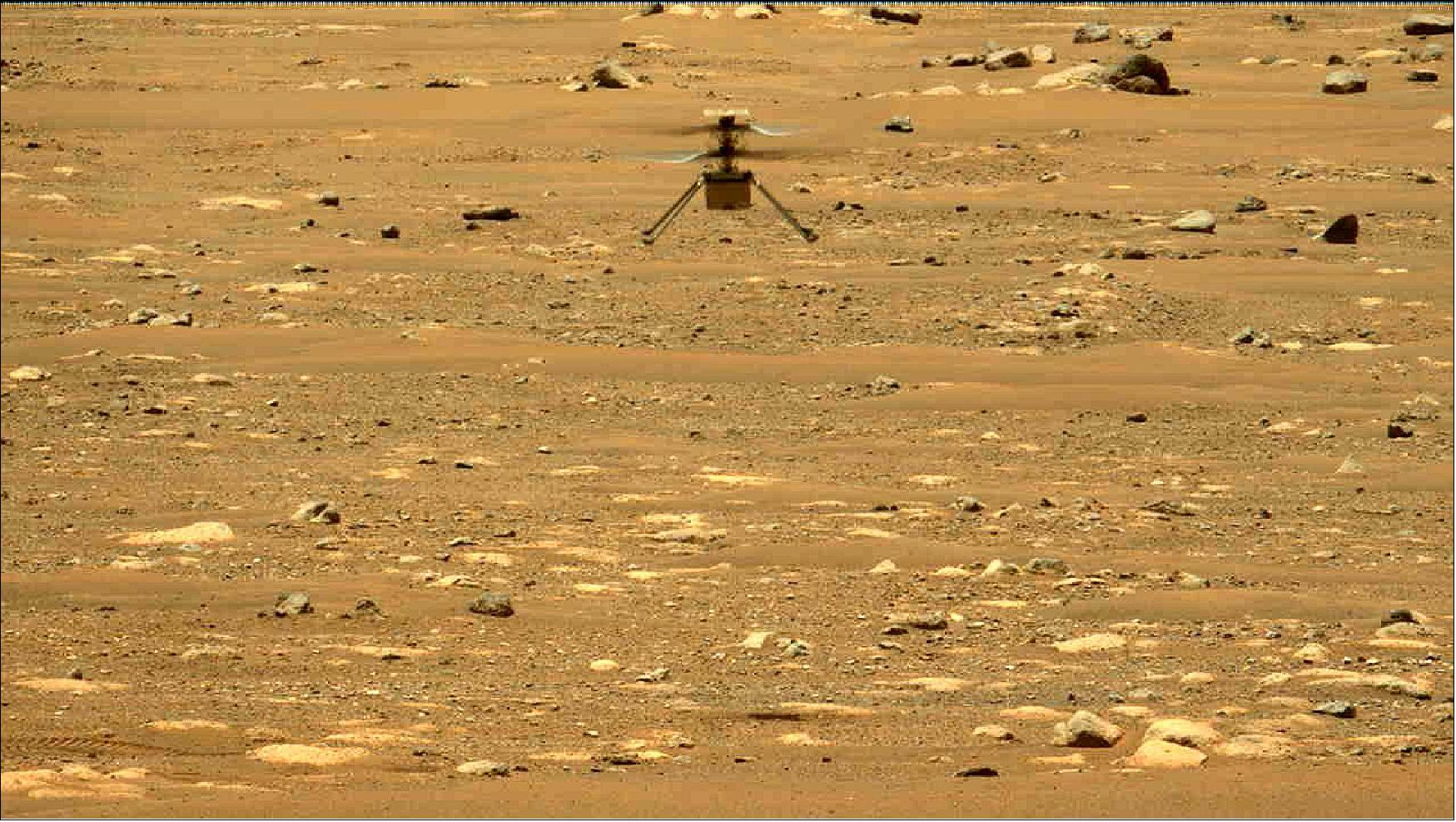
• April 21, 2021: The growing list of "firsts" for Perseverance, NASA's newest six-wheeled robot on the Martian surface, includes converting some of the Red Planet's thin, carbon dioxide-rich atmosphere into oxygen. A toaster-size, experimental instrument aboard Perseverance called the Mars Oxygen In-Situ Resource Utilization Experiment (MOXIE) accomplished the task. The test took place April 20, the 60th Martian day, or sol, since the mission landed Feb. 18. 16)
- While the technology demonstration is just getting started, it could pave the way for science fiction to become science fact – isolating and storing oxygen on Mars to help power rockets that could lift astronauts off the planet's surface. Such devices also might one day provide breathable air for astronauts themselves. MOXIE is an exploration technology investigation – as is the Mars Environmental Dynamics Analyzer (MEDA) weather station – and is sponsored by NASA's Space Technology Mission Directorate (STMD) and Human Exploration and Operations Mission Directorate.
- This is a critical first step at converting carbon dioxide to oxygen on Mars," said Jim Reuter, associate administrator for STMD. "MOXIE has more work to do, but the results from this technology demonstration are full of promise as we move toward our goal of one day seeing humans on Mars. Oxygen isn't just the stuff we breathe. Rocket propellant depends on oxygen, and future explorers will depend on producing propellant on Mars to make the trip home."
- For rockets or astronauts, oxygen is key, said MOXIE's principal investigator, Michael Hecht of the Massachusetts Institute of Technology's Haystack Observatory.
- To burn its fuel, a rocket must have more oxygen by weight. Getting four astronauts off the Martian surface on a future mission would require approximately 15,000 pounds (7 metric tons) of rocket fuel and 55,000 pounds (25 metric tons) of oxygen. In contrast, astronauts living and working on Mars would require far less oxygen to breathe. "The astronauts who spend a year on the surface will maybe use one metric ton between them," Hecht said.
- Hauling 25 metric tons of oxygen from Earth to Mars would be an arduous task. Transporting a one-ton oxygen converter – a larger, more powerful descendant of MOXIE that could produce those 25 tons – would be far more economical and practical.
- Mars' atmosphere is 96% carbon dioxide. MOXIE works by separating oxygen atoms from carbon dioxide molecules, which are made up of one carbon atom and two oxygen atoms. A waste product, carbon monoxide, is emitted into the Martian atmosphere.
- The conversion process requires high levels of heat to reach a temperature of approximately 1,470 degrees Fahrenheit (800 Celsius). To accommodate this, the MOXIE unit is made with heat-tolerant materials. These include 3D-printed nickel alloy parts, which heat and cool the gases flowing through it, and a lightweight aerogel that helps hold in the heat. A thin gold coating on the outside of MOXIE reflects infrared heat, keeping it from radiating outward and potentially damaging other parts of Perseverance.
- In this first operation, MOXIE's oxygen production was quite modest – about 5 grams, equivalent to about 10 minutes worth of breathable oxygen for an astronaut. MOXIE is designed to generate up to 10 grams of oxygen per hour.
- This technology demonstration was designed to ensure the instrument survived the launch from Earth, a nearly seven-month journey through deep space, and touchdown with Perseverance on Feb. 18. MOXIE is expected to extract oxygen at least nine more times over the course of a Martian year (nearly two years on Earth).

- These oxygen-production runs will come in three phases. The first phase will check out and characterize the instrument's function, while the second phase will run the instrument in varying atmospheric conditions, such as different times of day and seasons. In the third phase, Hecht said, "we'll push the envelope" – trying new operating modes, or introducing "new wrinkles, such as a run where we compare operations at three or more different temperatures."
- "MOXIE isn't just the first instrument to produce oxygen on another world," said Trudy Kortes, director of technology demonstrations within STMD. It's the first technology of its kind that will help future missions "live off the land," using elements of another world's environment, also known as in-situ resource utilization.
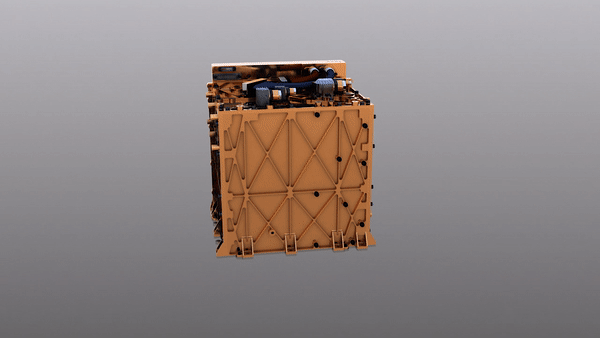
- "It's taking regolith, the substance you find on the ground, and putting it through a processing plant, making it into a large structure, or taking carbon dioxide – the bulk of the atmosphere – and converting it into oxygen," she said. "This process allows us to convert these abundant materials into useable things: propellant, breathable air, or, combined with hydrogen, water."
More About Perseverance
- A key objective of Perseverance's mission on Mars is astrobiology, including the search for signs of ancient microbial life. The rover will characterize the planet's geology and past climate, pave the way for human exploration of the Red Planet, and be the first mission to collect and cache Martian rock and regolith (broken rock and dust).
- Subsequent NASA missions, in cooperation with ESA (European Space Agency), would send spacecraft to Mars to collect these sealed samples from the surface and return them to Earth for in-depth analysis.
- The Mars 2020 Perseverance mission is part of NASA's Moon to Mars exploration approach, which includes Artemis missions to the Moon that will help prepare for human exploration of the Red Planet.
• April 19. 2021: The small rotorcraft made history, hovering above Jezero Crater, demonstrating that powered, controlled flight on another planet is possible. 17)
- NASA's Ingenuity Mars Helicopter became the first aircraft in history to make a powered, controlled flight on another planet. The Ingenuity team at the agency's Jet Propulsion Laboratory in Southern California confirmed the flight succeeded after receiving data from the helicopter via NASA's Perseverance Mars rover at 6:46 a.m. EDT (3:46 a.m. PDT).
- "Ingenuity is the latest in a long and storied tradition of NASA projects achieving a space exploration goal once thought impossible," said acting NASA Administrator Steve Jurczyk. "The X-15 was a pathfinder for the space shuttle. Mars Pathfinder and its Sojourner rover did the same for three generations of Mars rovers. We don't know exactly where Ingenuity will lead us, but today's results indicate the sky – at least on Mars – may not be the limit."
- The solar-powered helicopter first became airborne at 3:34 a.m. EDT (12:34 a.m. PDT) – 12:33 Local Mean Solar Time (Mars time) – a time the Ingenuity team determined would have optimal energy and flight conditions. Altimeter data indicate Ingenuity climbed to its prescribed maximum altitude of 10 feet (3 meters) and maintained a stable hover for 30 seconds. It then descended, touching back down on the surface of Mars after logging a total of 39.1 seconds of flight. Additional details on the test are expected in upcoming downlinks.
- Ingenuity's initial flight demonstration was autonomous – piloted by onboard guidance, navigation, and control systems running algorithms developed by the team at JPL. Because data must be sent to and returned from the Red Planet over hundreds of millions of miles using orbiting satellites and NASA's Deep Space Network, Ingenuity cannot be flown with a joystick, and its flight was not observable from Earth in real time.
- NASA Associate Administrator for Science Thomas Zurbuchen announced the name for the Martian airfield on which the flight took place.
- "Now, 117 years after the Wright brothers succeeded in making the first flight on our planet, NASA's Ingenuity helicopter has succeeded in performing this amazing feat on another world," Zurbuchen said. "While these two iconic moments in aviation history may be separated by time and 173 million miles of space, they now will forever be linked. As an homage to the two innovative bicycle makers from Dayton, this first of many airfields on other worlds will now be known as Wright Brothers Field, in recognition of the ingenuity and innovation that continue to propel exploration."
- Ingenuity's chief pilot, Håvard Grip, announced that the International Civil Aviation Organization (ICAO) – the United Nations' civil aviation agency – presented NASA and the Federal Aviation Administration with official ICAO designator IGY, call-sign INGENUITY.
- These details will be included officially in the next edition of ICAO's publication Designators for Aircraft Operating Agencies, Aeronautical Authorities and Services. The location of the flight has also been given the ceremonial location designation JZRO for Jezero Crater.
- As one of NASA's technology demonstration projects, the 19.3-inch-tall (49-centimeter-tall) Ingenuity Mars Helicopter contains no science instruments inside its tissue-box-size fuselage. Instead, the 4-pound (1.8-kg) rotorcraft is intended to demonstrate whether future exploration of the Red Planet could include an aerial perspective.
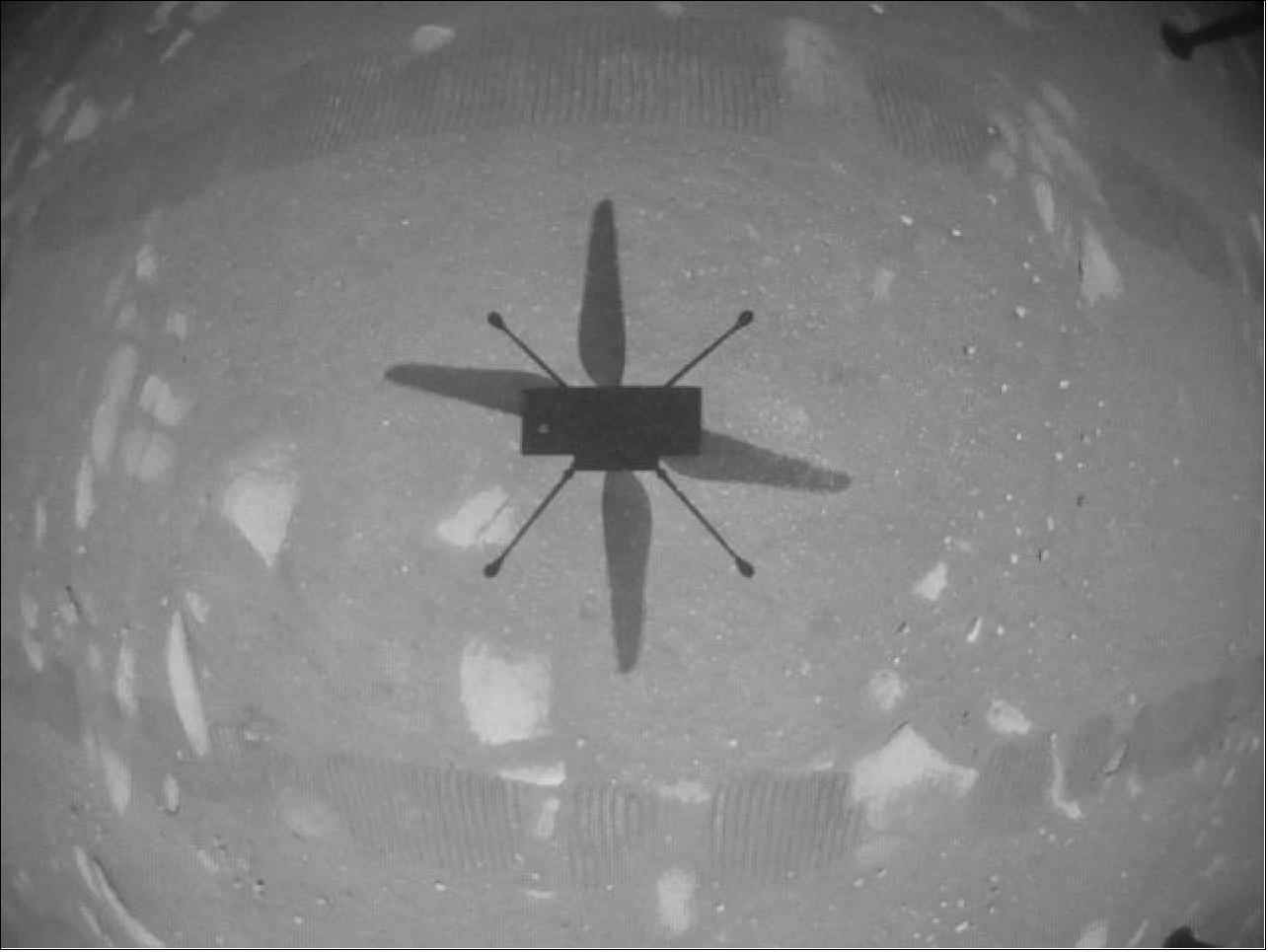
- This first flight was full of unknowns. The Red Planet has a significantly lower gravity – one-third that of Earth's – and an extremely thin atmosphere with only 1% the pressure at the surface compared to our planet. This means there are relatively few air molecules with which Ingenuity's two 4-foot-wide (1.2-meter-wide) rotor blades can interact to achieve flight. The helicopter contains unique components, as well as off-the-shelf-commercial parts – many from the smartphone industry – that were tested in deep space for the first time with this mission.
- "The Mars Helicopter project has gone from ‘blue sky' feasibility study to workable engineering concept to achieving the first flight on another world in a little over six years," said Michael Watkins, director of JPL. "That this project has achieved such a historic first is testimony to the innovation and doggedness of our team here at JPL, as well as at NASA's Langley and Ames Research Centers, and our industry partners. It's a shining example of the kind of technology push that thrives at JPL and fits well with NASA's exploration goals."
- Parked about 211 feet (64.3 meters) away at Van Zyl Overlook during Ingenuity's historic first flight, the Perseverance rover not only acted as a communications relay between the helicopter and Earth, but also chronicled the flight operations with its cameras. The pictures from the rover's Mastcam-Z and Navcam imagers will provide additional data on the helicopter's flight.

- "We have been thinking for so long about having our Wright brothers moment on Mars, and here it is," said MiMi Aung, project manager of the Ingenuity Mars Helicopter at JPL. "We will take a moment to celebrate our success and then take a cue from Orville and Wilbur regarding what to do next. History shows they got back to work – to learn as much as they could about their new aircraft – and so will we."
- Perseverance touched down with Ingenuity attached to its belly on Feb. 18. Deployed to the surface of Jezero Crater on April 3, Ingenuity is currently on the 16th sol, or Martian day, of its 30-sol (31-Earth day) flight test window. Over the next three sols, the helicopter team will receive and analyze all data and imagery from the test and formulate a plan for the second experimental test flight, scheduled for no earlier than April 22. If the helicopter survives the second flight test, the Ingenuity team will consider how best to expand the flight profile.
- JPL, which built Ingenuity, also manages the technology demonstration project for NASA. It is supported by NASA's Science, Aeronautics, and Space Technology mission directorates. The agency's Ames Research Center in California's Silicon Valley and Langley Research Center in Hampton, Virginia, provided significant flight performance analysis and technical assistance during Ingenuity's development.
- Dave Lavery is the program executive for the Ingenuity Mars Helicopter, MiMi Aung is the project manager, and Bob Balaram is chief engineer.
• March 23, 2021: NASA is targeting no earlier than April 8 for the Ingenuity Mars Helicopter to make the first attempt at powered, controlled flight of an aircraft on another planet. Before the 4-pound (1.8 kg) rotorcraft can attempt its first flight, however, both it and its team must meet a series of daunting milestones. 18)
- Ingenuity remains attached to the belly of NASA's Perseverance rover, which touched down on Mars Feb. 18. On March 21, the rover deployed the guitar case-shaped graphite composite debris shield that protected Ingenuity during landing. The rover currently is in transit to the "airfield" where Ingenuity will attempt to fly. Once deployed, Ingenuity will have 30 Martian days, or sols, (31 Earth days) to conduct its test flight campaign.
- "When NASA's Sojourner rover landed on Mars in 1997, it proved that roving the Red Planet was possible and completely redefined our approach to how we explore Mars. Similarly, we want to learn about the potential Ingenuity has for the future of science research," said Lori Glaze, director of the Planetary Science Division at NASA Headquarters. "Aptly named, Ingenuity is a technology demonstration that aims to be the first powered flight on another world and, if successful, could further expand our horizons and broaden the scope of what is possible with Mars exploration."
- Flying in a controlled manner on Mars is far more difficult than flying on Earth. The Red Planet has significant gravity (about one-third that of Earth's) but its atmosphere is just 1% as dense as Earth's at the surface. During Martian daytime, the planet's surface receives only about half the amount of solar energy that reaches Earth during its daytime, and nighttime temperatures can drop as low as minus 130 degrees Fahrenheit (minus 90 degrees Celsius), which can freeze and crack unprotected electrical components.
- To fit within the available accommodations provided by the Perseverance rover, the Ingenuity helicopter must be small. To fly in the Mars environment, it must be lightweight. To survive the frigid Martian nights, it must have enough energy to power internal heaters. The system – from the performance of its rotors in rarified air to its solar panels, electrical heaters, and other components – has been tested and retested in the vacuum chambers and test labs of NASA's Jet Propulsion Laboratory in Southern California.
- "Every step we have taken since this journey began six years ago has been uncharted territory in the history of aircraft," said Bob Balaram, Mars Helicopter chief engineer at JPL. "And while getting deployed to the surface will be a big challenge, surviving that first night on Mars alone, without the rover protecting it and keeping it powered, will be an even bigger one."
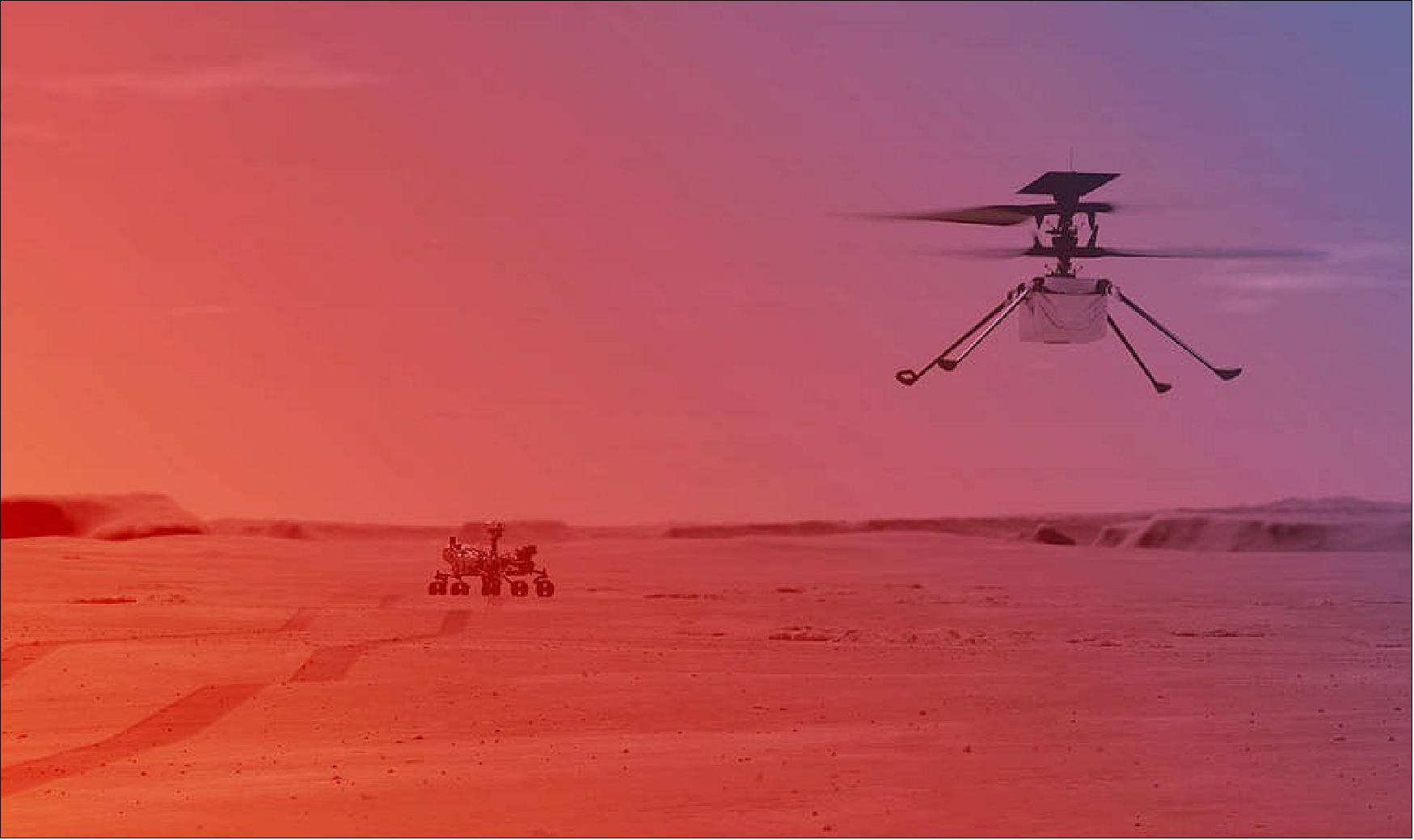
Deploying the Helicopter
- Before Ingenuity takes its first flight on Mars, it must be squarely in the middle of its airfield – a 33-by-33-foot (10-by-10-meter) patch of Martian real estate chosen for its flatness and lack of obstructions. Once the helicopter and rover teams confirm that Perseverance is situated exactly where they want it to be inside the airfield, the elaborate process to deploy the helicopter on the surface of Mars begins.
- "As with everything with the helicopter, this type of deployment has never been done before," said Farah Alibay, Mars Helicopter integration lead for the Perseverance rover. "Once we start the deployment there is no turning back. All activities are closely coordinated, irreversible, and dependent on each other. If there is even a hint that something isn't going as expected, we may decide to hold off for a sol or more until we have a better idea what is going on."
- The helicopter deployment process will take about six sols (six days, four hours on Earth). On the first sol, the team on Earth will activate a bolt-breaking device, releasing a locking mechanism that helped hold the helicopter firmly against the rover's belly during launch and Mars landing. The following sol, they will fire a cable-cutting pyrotechnic device, enabling the mechanized arm that holds Ingenuity to begin rotating the helicopter out of its horizontal position. This is also when the rotorcraft will extend two of its four landing legs.
- During the third sol of the deployment sequence, a small electric motor will finish rotating Ingenuity until it latches, bringing the helicopter completely vertical. During the fourth sol, the final two landing legs will snap into position. On each of those four sols, the Wide Angle Topographic Sensor for Operations and eNgineering (WATSON) imager will take confirmation shots of Ingenuity as it incrementally unfolds into its flight configuration. In its final position, the helicopter will hang suspended at about 5 inches (13 centimeters) over the Martian surface. At that point, only a single bolt and a couple dozen tiny electrical contacts will connect the helicopter to Perseverance. On the fifth sol of deployment, the team will use the final opportunity to utilize Perseverance as a power source and charge Ingenuity's six battery cells.
- "Once we cut the cord with Perseverance and drop those final five inches to the surface, we want to have our big friend drive away as quickly as possible so we can get the Sun's rays on our solar panel and begin recharging our batteries," said Balaram.
- On the sixth and final scheduled sol of this deployment phase, the team will need to confirm three things: that Ingenuity's four legs are firmly on the surface of Jezero Crater, that the rover did, indeed, drive about 16 feet (about 5 meters) away, and that both helicopter and rover are communicating via their onboard radios. This milestone also initiates the 30-sol clock during which time all preflight checks and flight tests must take place.
- "Ingenuity is an experimental engineering flight test – we want to see if we can fly at Mars," said MiMi Aung, project manager for Ingenuity Mars Helicopter at JPL. "There are no science instruments onboard and no goals to obtain scientific information. We are confident that all the engineering data we want to obtain both on the surface of Mars and aloft can be done within this 30-sol window."
- As with deployment, the helicopter and rover teams will approach the upcoming flight test methodically. If the team misses or has questions about an important preflight milestone, they may take one or more sols to better understand the issue. If the helicopter survives the first night of the sequence period on the surface of Mars, however, the team will spend the next several sols doing everything possible to ensure a successful flight, including wiggling the rotor blades and verifying the performance of the inertial measurement unit, as well as testing the entire rotor system during a spin-up to 2,537 rpm (while Ingenuity's landing gear remain firmly on the surface).
The First Flight Test on Mars
- Once the team is ready to attempt the first flight, Perseverance will receive and relay to Ingenuity the final flight instructions from JPL mission controllers. Several factors will determine the precise time for the flight, including modeling of local wind patterns plus measurements taken by the Mars Environmental Dynamics Analyzer (MEDA) aboard Perseverance. Ingenuity will run its rotors to 2,537 rpm and, if all final self-checks look good, lift off. After climbing at a rate of about 3 feet per second (1 meter per second), the helicopter will hover at 10 feet (3 m) above the surface for up to 30 seconds. Then, the Mars Helicopter will descend and touch back down on the Martian surface.
- Several hours after the first flight has occurred, Perseverance will downlink Ingenuity's first set of engineering data and, possibly, images and video from the rover's Navigation Cameras and Mastcam-Z. From the data downlinked that first evening after the flight, the Mars Helicopter team expect to be able to determine if their first attempt to fly at Mars was a success.
- On the following sol, all the remaining engineering data collected during the flight, as well as some low-resolution black-and-white imagery from the helicopter's own Navigation Camera, could be downlinked to JPL. The third sol of this phase, the two images taken by the helicopter's high-resolution color camera should arrive. The Mars Helicopter team will use all information available to determine when and how to move forward with their next test.
- "Mars is hard," said Aung. "Our plan is to work whatever the Red Planet throws at us the very same way we handled every challenge we've faced over the past six years – together, with tenacity and a lot of hard work, and a little Ingenuity."
A Piece of History
- While Ingenuity will attempt the first powered, controlled flight on another planet, the first powered, controlled flight on Earth took place Dec. 17, 1903, on the windswept dunes of Kill Devil Hill, near Kitty Hawk, North Carolina. Orville and Wilbur Wright covered 120 feet in 12 seconds during the first flight. The Wright brothers made four flights that day, each longer than the previous.
- A small amount of the material that covered one of the wings of the Wright brothers' aircraft, known as the Flyer, during the first flight is now aboard Ingenuity. An insulative tape was used to wrap the small swatch of fabric around a cable located underneath the helicopter's solar panel. The Wrights used the same type of material – an unbleached muslin called "Pride of the West" – to cover their glider and aircraft wings beginning in 1901. The Apollo 11 crew flew a different piece of the material, along with a small splinter of wood from the Wright Flyer, to the Moon and back during their iconic mission in July 1969.
More About Ingenuity
- The Ingenuity Mars Helicopter was built by JPL, which also manages the technology demonstration for NASA Headquarters. It is supported by NASA's Science Mission Directorate, the NASA Aeronautics Research Mission Directorate, and the NASA Space Technology Mission Directorate. NASA's Ames Research Center and Langley Research Center provided significant flight performance analysis and technical assistance.
- At NASA Headquarters, Dave Lavery is the program executive for the Ingenuity Mars Helicopter. At JPL, MiMi Aung is the project manager and J. (Bob) Balaram is chief engineer.
- Bring the excitement of Ingenuity into classrooms and homes through NASA's Office of STEM Engagement toolkit. Educators, students, and families can follow along the mission by building a paper helicopter or coding an Ingenuity video game.
• March 15, 2021: New Study Challenges Long-Held Theory of Fate of Mars' Water. The new science results indicate that a large quantity of the Red Planet's water is trapped in its crust rather than having escaped into space. 19)
- Billions of years ago, according to geological evidence, abundant water flowed across Mars and collected into pools, lakes, and deep oceans. New NASA-funded research shows a substantial quantity of its water – between 30 and 99% – is trapped within minerals in the planet's crust, challenging the current theory that due to the Red Planet's low gravity, its water escaped into space.
- Early Mars was thought to have enough water to have covered the whole planet in an ocean roughly 100 to 1,500 meters (330 to 4,920 feet) deep – a volume roughly equivalent to half of Earth's Atlantic Ocean. While some of this water undeniably disappeared from Mars via atmospheric escape, the new findings, published in the latest issue of Science, conclude it does not account for most of its water loss.
- The results were presented at the 52nd Lunar and Planetary Science Conference (LPSC) by lead author and Caltech Ph.D. candidate Eva Scheller along with co-authors Bethany Ehlmann, professor of planetary science at Caltech and associate director for the Keck Institute for Space Studies; Yuk Yung, professor of planetary science at Caltech and senior research scientist at NASA's Jet Propulsion Laboratory; Danica Adams, Caltech graduate student; and Renyu Hu, JPL research scientist.
- "Atmospheric escape doesn't fully explain the data that we have for how much water actually once existed on Mars," said Scheller.
- Using a wealth of cross-mission data archived in NASA's Planetary Data System (PDS), the research team integrated data from multiple NASA Mars Exploration Program missions and meteorite lab work. Specifically, the team studied the quantity of water on the Red Planet over time in all its forms (vapor, liquid, and ice) and the chemical composition of the planet's current atmosphere and crust, looking in particular at the ratio of deuterium to hydrogen (D/H).
- While water is made up of hydrogen and oxygen, not all hydrogen atoms are created equal. The vast majority of hydrogen atoms have just one proton within the atomic nucleus, while a tiny fraction (about 0.02%) exists as deuterium, or so-called "heavy" hydrogen, which has a proton and a neutron. The lighter-weight hydrogen escapes the planet's gravity into space much easier than its denser counterpart. Because of this, the loss of a planet's water via the upper atmosphere would leave a revealing sign on the ratio of deuterium to hydrogen in the planet's atmosphere: There would be a very large amount of deuterium left behind.
- However, the loss of water solely through the atmosphere cannot explain both the observed deuterium-to-hydrogen signal in the Martian atmosphere and large amounts of water in the past. Instead, the study proposes that a combination of two mechanisms – the trapping of water in minerals in the planet's crust and the loss of water to the atmosphere – can explain the observed deuterium-to-hydrogen signal within the Martian atmosphere.
- "The hydrated materials on our own planet are being continually recycled through plate tectonics," said Michael Meyer, lead scientist for NASA's Mars Exploration Program at the agency's headquarters in Washington. "Because we have measurements from multiple spacecraft, we can see that Mars doesn't recycle, and so water is now locked up in the crust or been lost to space."
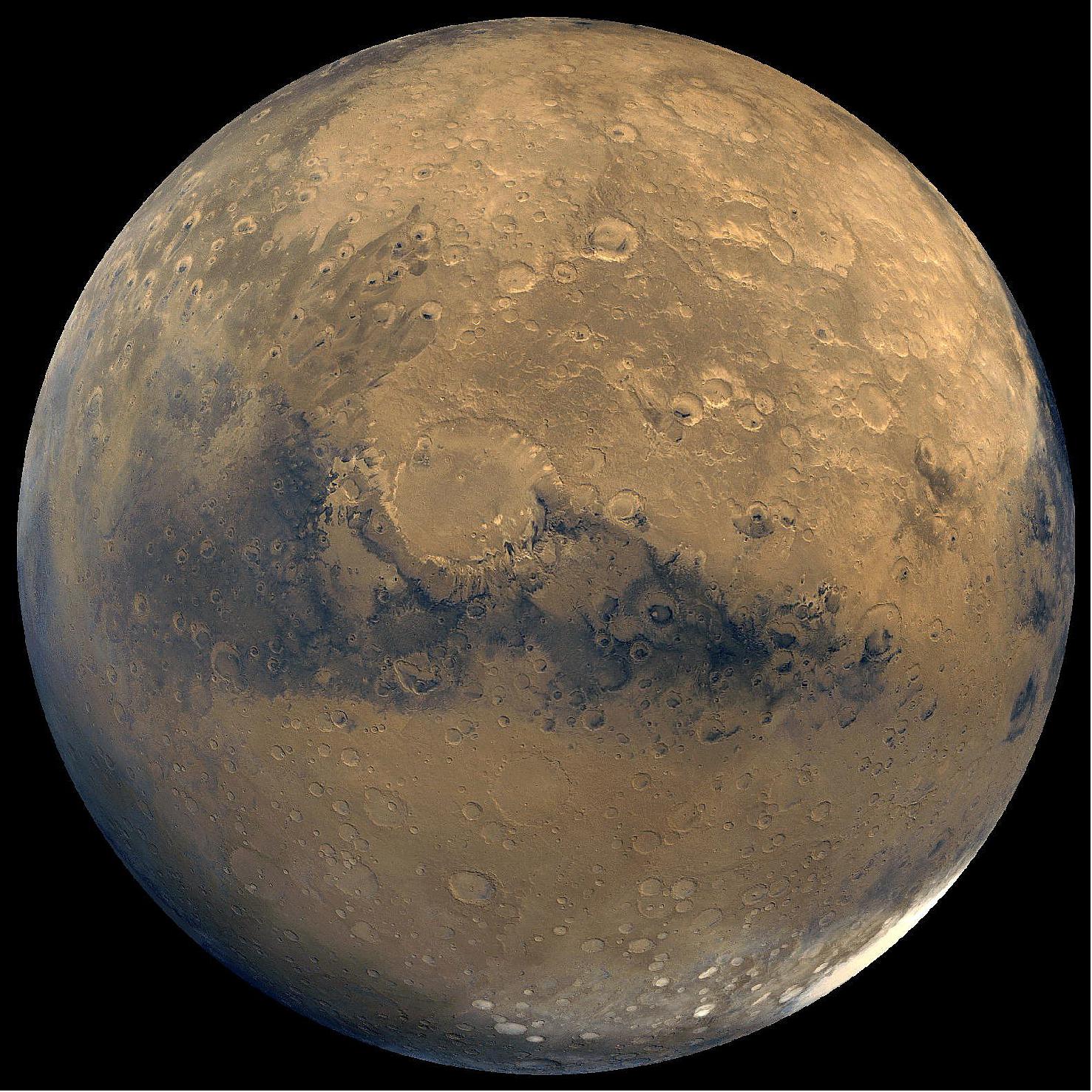
- A key objective of NASA's Mars 2020 Perseverance rover mission on Mars is astrobiology, including the search for signs of ancient microbial life. The rover will characterize the planet's geology and past climate, pave the way for human exploration of the Red Planet, and be the first mission to collect and cache Martian rock and regolith (broken rock and dust). Scheller and Ehlmann will aid in operations by the Perseverance rover to collect these samples that will be returned to Earth through the Mars Sample Return program, which will allow the highly-anticipated further examination of these hypotheses about the drivers of Mars climate change. Understanding the evolution of the Martian environment is important context for understanding results from analyses of the returned samples as well as understanding how habitability changes over time on rocky planets.
- The research and findings outlined in the paper highlight the significant contributions of early career scientists in expanding our understanding of the solar system. Similarly, the research, which relied on data from meteorites, telescopes, satellite observations, and samples analyzed by rovers on Mars, illustrates the importance of having multiple ways of probing the Red Planet.
- This work was supported by a NASA Habitable Worlds award, a NASA Earth and Space Science Fellowship (NESSF) award, and a NASA Future Investigator in NASA Earth and Space Science and Technology (FINESST) award.
• March 5, 2021: The first trek of the agency's largest, most advanced rover yet on the Red Planet marks a major milestone before science operations get under way. 20)
- NASA's Mars 2020 Perseverance rover performed its first drive on Mars March 4, covering 21.3 feet (6.5 meters) across the Martian landscape. The drive served as a mobility test that marks just one of many milestones as team members check out and calibrate every system, subsystem, and instrument on Perseverance. Once the rover begins pursuing its science goals, regular commutes extending 656 feet (200 meters) or more are expected.
- "When it comes to wheeled vehicles on other planets, there are few first-time events that measure up in significance to that of the first drive," said Anais Zarifian, Mars 2020 Perseverance rover mobility test bed engineer at NASA's Jet Propulsion Laboratory in Southern California. "This was our first chance to ‘kick the tires' and take Perseverance out for a spin. The rover's six-wheel drive responded superbly. We are now confident our drive system is good to go, capable of taking us wherever the science leads us over the next two years."
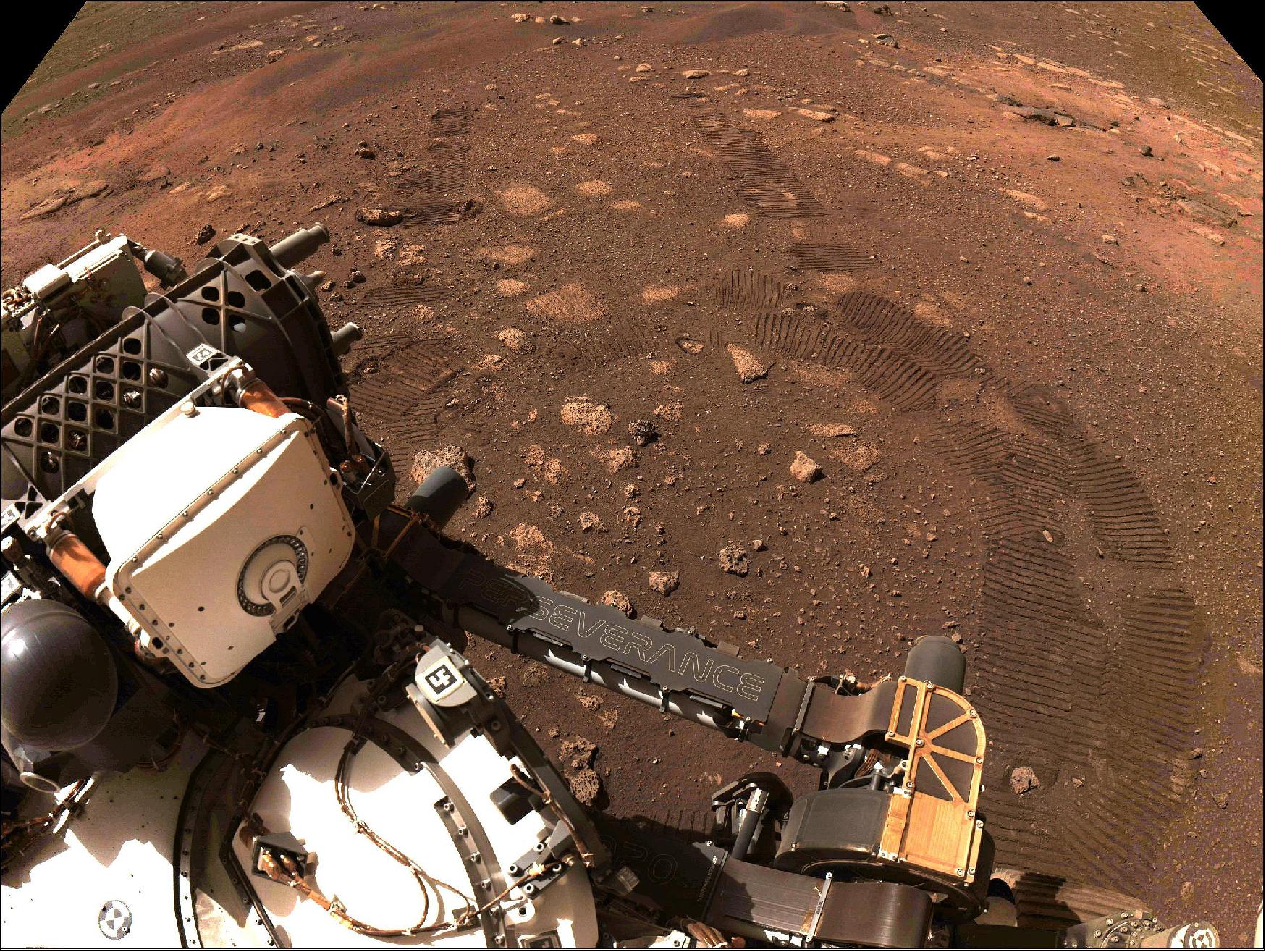
- Upcoming events and evaluations include more detailed testing and calibration of science instruments, sending the rover on longer drives, and jettisoning covers that shield both the adaptive caching assembly (part of the rover's Sample Caching System) and the Ingenuity Mars Helicopter during landing. The experimental flight test program for the Ingenuity Mars Helicopter will also take place during the rover's commissioning.
- Through it all, the rover is sending down images from the most advanced suite of cameras ever to travel to Mars. The mission's cameras have already sent about 7,000 images. On Earth, Perseverance's imagery flows through the powerful Deep Space Network (DSN), managed by NASA's Space Communications and Navigation (SCaN) program. In space, several Mars orbiters play an equally important role.
- "Orbiter support for downlink of data has been a real gamechanger," said Justin Maki, chief engineer for imaging and the imaging scientist for the Mars 2020 Perseverance rover mission at JPL. "When you see a beautiful image from Jezero, consider that it took a whole team of Martians to get it to you. Every picture from Perseverance is relayed by either the European Space Agency's Trace Gas Orbiter, or NASA's MAVEN, Mars Odyssey, or Mars Reconnaissance Orbiter. They are important partners in our explorations and our discoveries."
- The sheer volume of imagery and data already coming down on this mission has been a welcome bounty for Matt Wallace, who recalls waiting anxiously for the first images to trickle in during NASA's first Mars rover mission, Sojourner, which explored Mars in 1997. On March 3, Wallace became the mission's new project manager. He replaced John McNamee, who is stepping down as he intended, after helming the project for nearly a decade.
- "John has provided unwavering support to me and every member of the project for over a decade," said Wallace. "He has left his mark on this mission and team, and it has been my privilege to not only call him boss but also my friend."
Touchdown Site Named
- With Perseverance departing from its touchdown site, mission team scientists have memorialized the spot, informally naming it for the late science fiction author Octavia E. Butler. The groundbreaking author and Pasadena, California, native was the first African American woman to win both the Hugo Award and Nebula Award, and she was the first science fiction writer honored with a MacArthur Fellowship. The location where Perseverance began its mission on Mars now bears the name "Octavia E. Butler Landing."
- Official scientific names for places and objects throughout the solar system – including asteroids, comets, and locations on planets – are designated by the International Astronomical Union. Scientists working with NASA's Mars rovers have traditionally given unofficial nicknames to various geological features, which they can use as references in scientific papers.
- "Butler's protagonists embody determination and inventiveness, making her a perfect fit for the Perseverance rover mission and its theme of overcoming challenges," said Kathryn Stack Morgan, deputy project scientist for Perseverance. "Butler inspired and influenced the planetary science community and many beyond, including those typically under-represented in STEM fields."
- "I can think of no better person to mark this historic landing site than Octavia E. Butler, who not only grew up next door to JPL in Pasadena, but she also inspired millions with her visions of a science-based future," said Thomas Zurbuchen, NASA associate administrator for science. "Her guiding principle, ‘When using science, do so accurately,' is what the science team at NASA is all about. Her work continues to inspire today's scientists and engineers across the globe – all in the name of a bolder, more equitable future for all."
- Butler, who died in 2006, authored such notable works as "Kindred," "Bloodchild," "Speech Sounds," "Parable of the Sower," "Parable of the Talents," and the "Patternist" series. Her writing explores themes of race, gender, equality, and humanity, and her works are as relevant today as they were when originally written and published.
• February 25, 2021: Testing spacecraft components prior to flight is vital for a successful mission. Rarely do you get a do-over with a spacecraft after it launches especially those bound for another planet. You need to do everything possible to get it right the first time. 21)
- Three successful sounding rocket missions from NASA's Wallops Flight Facility in Virginia in 2017 and 2018 to test a supersonic parachute proved their worth with the successful landing of the Perseverance mission on the red plant.
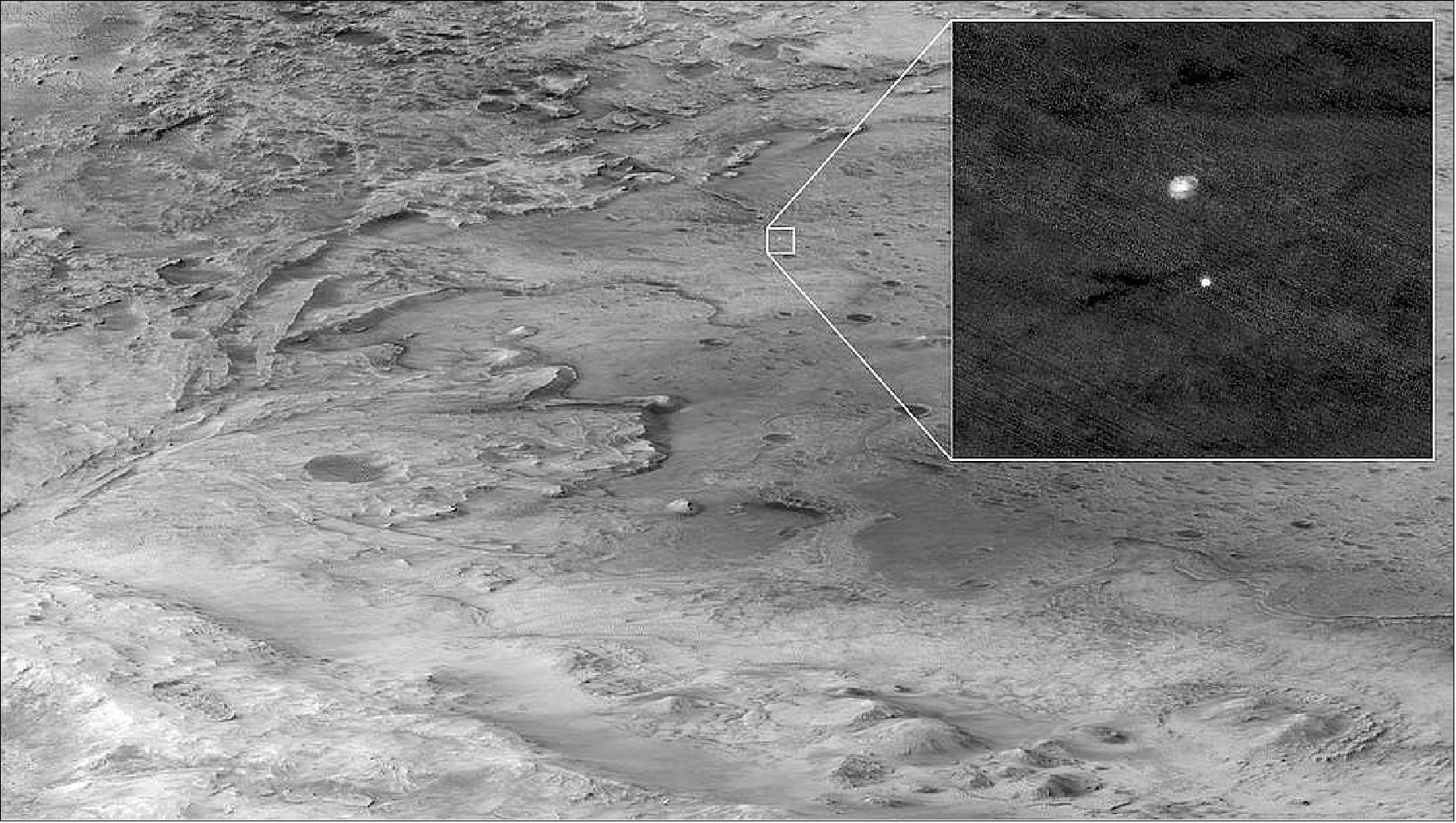

- After a 203-day journey traversing 293 million miles, the supersonic parachutes, designed to slow the rover's descent to the planet's surface, successfully deployed and inflated leading to the smooth touchdown of Perseverance.
- "This mission required us to design and build a 72-ft parachute that could survive inflating in a Mach 2 wind in about half a second. This is an extraordinary engineering challenge, but one that was absolutely necessary for the mission," said Ian Clark, the test's technical lead from NASA's Jet Propulsion Laboratory in Southern California. "To ensure they worked at Mars under those harsh conditions, we had to test our parachute designs here at Earth first. Replicating the Martian environment meant that we needed to get our payload half way to the edge of space and going twice the speed of sound. Sounding rockets were critical to our testing and ultimately our landing on Mars."
- The NASA team tested the parachute three times in Mars-relevant conditions, using Black Brant IX sounding rockets. The final test flight exposed the chute to a 67,000-pound (300,000- Newton) load — the highest ever survived by a supersonic parachute and about 85% higher than what the mission's chute was expected to encounter during deployment in Mars' atmosphere.
- "When the spacecraft successfully touched down last week it was a great feeling of accomplishment for the parachute testing team," said Giovanni Rosanova, chief of the NASA Sounding Rockets Program Office at Wallops. "Placing the test component in the right conditions with a sounding rocket was challenging and the importance of the tests to the success of the Mars landing was an exciting motivating factor for the team. We are proud to have been a part of this mission."
- Rosanova said, "One of the beauties of suborbital vehicles is that an instrument or its components can be flown, improved, and then re-flown. This can be done within a few years, providing the opportunity for scientists to work out the bugs before flying on a spacecraft."
- In the case of the Mars 2020 parachutes, the first flight was a test to see if the right conditions can be achieved during the flight to simulate what the parachutes will encounter descending through the Mars' atmosphere. The second flight, 6 months later in March 2018, was the first full test of the parachute. The final successful test conducted in September 2018 provided the results needed for the Perseverance parachute team to be confident that the design was ready for the Mars 2020 mission.
- NASA is currently developing plans for a Mars Sample Return mission to retrieve the rocks and soil samples collected by Perseverance and return them to Earth. Teams are preparing to test concepts for the Mars Ascent Vehicle that will carry the collected samples from the planet's surface.
• February 22, 2021: The agency's newest rover captured first-of-its-kind footage of its Feb. 18 touchdown and has recorded audio of Martian wind. 22)
- New video from NASA's Mars 2020 Perseverance rover chronicles major milestones during the final minutes of its entry, descent, and landing (EDL) on the Red Planet on Feb. 18 as the spacecraft plummeted, parachuted, and rocketed toward the surface of Mars. A microphone on the rover also has provided the first audio recording of sounds from Mars.
- From the moment of parachute inflation, the camera system covers the entirety of the descent process, showing some of the rover's intense ride to Mars' Jezero Crater. The footage from high-definition cameras aboard the spacecraft starts 7 miles (11 km) above the surface, showing the supersonic deployment of the most massive parachute ever sent to another world, and ends with the rover's touchdown in the crater.
Figure 43: This is a high-resolution version of a video taken by several cameras as NASA's Perseverance rover touched down on Mars. Cameras aboard the rover captured these shots; a microphone captured the first-ever audio of a Mars landing (video credit: NASA/JPL-Caltech)
- A microphone attached to the rover did not collect usable data during the descent, but the commercial off-the-shelf device survived the highly dynamic descent to the surface and obtained sounds from Jezero Crater on Feb. 20. About 10 seconds into the 60-second recording, a Martian breeze is audible for a few seconds, as are mechanical sounds of the rover operating on the surface.
- "For those who wonder how you land on Mars – or why it is so difficult – or how cool it would be to do so – you need look no further," said acting NASA Administrator Steve Jurczyk. "Perseverance is just getting started, and already has provided some of the most iconic visuals in space exploration history. It reinforces the remarkable level of engineering and precision that is required to build and fly a vehicle to the Red Planet."
- Also released Monday was the mission's first panorama of the rover's landing location, taken by the two Navigation Cameras located on its mast. The six-wheeled robotic astrobiologist, the fifth rover the agency has landed on Mars, currently is undergoing an extensive checkout of all its systems and instruments.
- "This video of Perseverance's descent is the closest you can get to landing on Mars without putting on a pressure suit," said Thomas Zurbuchen, NASA associate administrator for science. "It should become mandatory viewing for young women and men who not only want to explore other worlds and build the spacecraft that will take them there, but also want to be part of the diverse teams achieving all the audacious goals in our future."
- The world's most intimate view of a Mars landing begins about 230 seconds after the spacecraft entered the Red Planet's upper atmosphere at 12,500 mph (20,100 km/h). The video opens in black, with the camera lens still covered within the parachute compartment. Within less than a second, the spacecraft's parachute deploys and transforms from a compressed 18-by-26 inch (46-by-66 cm) cylinder of nylon, Technora, and Kevlar into a fully inflated 70.5-foot-wide (21.5-meter-wide) canopy – the largest ever sent to Mars. The tens of thousands of pounds of force that the parachute generates in such a short period stresses both the parachute and the vehicle.
- "Now we finally have a front-row view to what we call ‘the seven minutes of terror' while landing on Mars," said Michael Watkins, director of NASA's Jet Propulsion Laboratory in Southern California, which manages the mission for the agency. "From the explosive opening of the parachute to the landing rockets' plume sending dust and debris flying at touchdown, it's absolutely awe-inspiring."
- The video also captures the heat shield dropping away after protecting Perseverance from scorching temperatures during its entry into the Martian atmosphere. The downward view from the rover sways gently like a pendulum as the descent stage, with Perseverance attached, hangs from the back shell and parachute. The Martian landscape quickly pitches as the descent stage – the rover's free-flying "jetpack," which decelerates using rocket engines and then lowers the rover on cables to the surface – breaks free, its eight thrusters engaging to put distance between it and the now-discarded back shell and the parachute.
- Then, 80 seconds and 7,000 feet (2,130 meters) later, the cameras capture the descent stage performing the sky crane maneuver over the landing site – the plume of its rocket engines kicking up dust and small rocks that have likely been in place for billions of years.
- "We put the EDL camera system onto the spacecraft not only for the opportunity to gain a better understanding of our spacecraft's performance during entry, descent, and landing, but also because we wanted to take the public along for the ride of a lifetime – landing on the surface of Mars," said Dave Gruel, lead engineer for Mars 2020 Perseverance's EDL camera and microphone subsystem at JPL. "We know the public is fascinated with Mars exploration, so we added the EDL Cam microphone to the vehicle because we hoped it could enhance the experience, especially for visually-impaired space fans, and engage and inspire people around the world."
- The footage ends with Perseverance's aluminum wheels making contact with the surface at 1.61 mph (2.6 km/h), and then pyrotechnically fired blades sever the cables connecting it to the still-hovering descent stage. The descent stage then climbs and accelerates away in the preplanned flyaway maneuver.
- "If this were an old Western movie, I'd say the descent stage was our hero riding slowly into the setting Sun, but the heroes are actually back here on Earth," said Matt Wallace, Mars 2020 Perseverance deputy project manager at JPL. "I've been waiting 25 years for the opportunity to see a spacecraft land on Mars. It was worth the wait. Being able to share this with the world is a great moment for our team."
- Five commercial off-the-shelf cameras located on three different spacecraft components collected the imagery. Two cameras on the back shell, which encapsulated the rover on its journey, took pictures of the parachute inflating. A camera on the descent stage provided a downward view – including the top of the rover – while two on the rover chassis offered both upward and downward perspectives.
- The rover team continues its initial inspection of Perseverance's systems and its immediate surroundings. Monday, the team will check out five of the rover's seven instruments and take the first weather observations with the Mars Environmental Dynamics Analyzer instrument. In the coming days, a 360-degree panorama of Jezero by the Mastcam-Z should be transmitted down, providing the highest resolution look at the road ahead.

• February 19, 2021: Perseverance's First Full-Color Look at Mars. The rover will characterize the planet's geology and past climate, pave the way for human exploration of the Red Planet, and be the first mission to collect and cache Martian rock and regolith (broken rock and dust). 23)
- Subsequent NASA missions, in cooperation with ESA (the European Space Agency), would send spacecraft to Mars to collect these cached samples from the surface and return them to Earth for in-depth analysis.
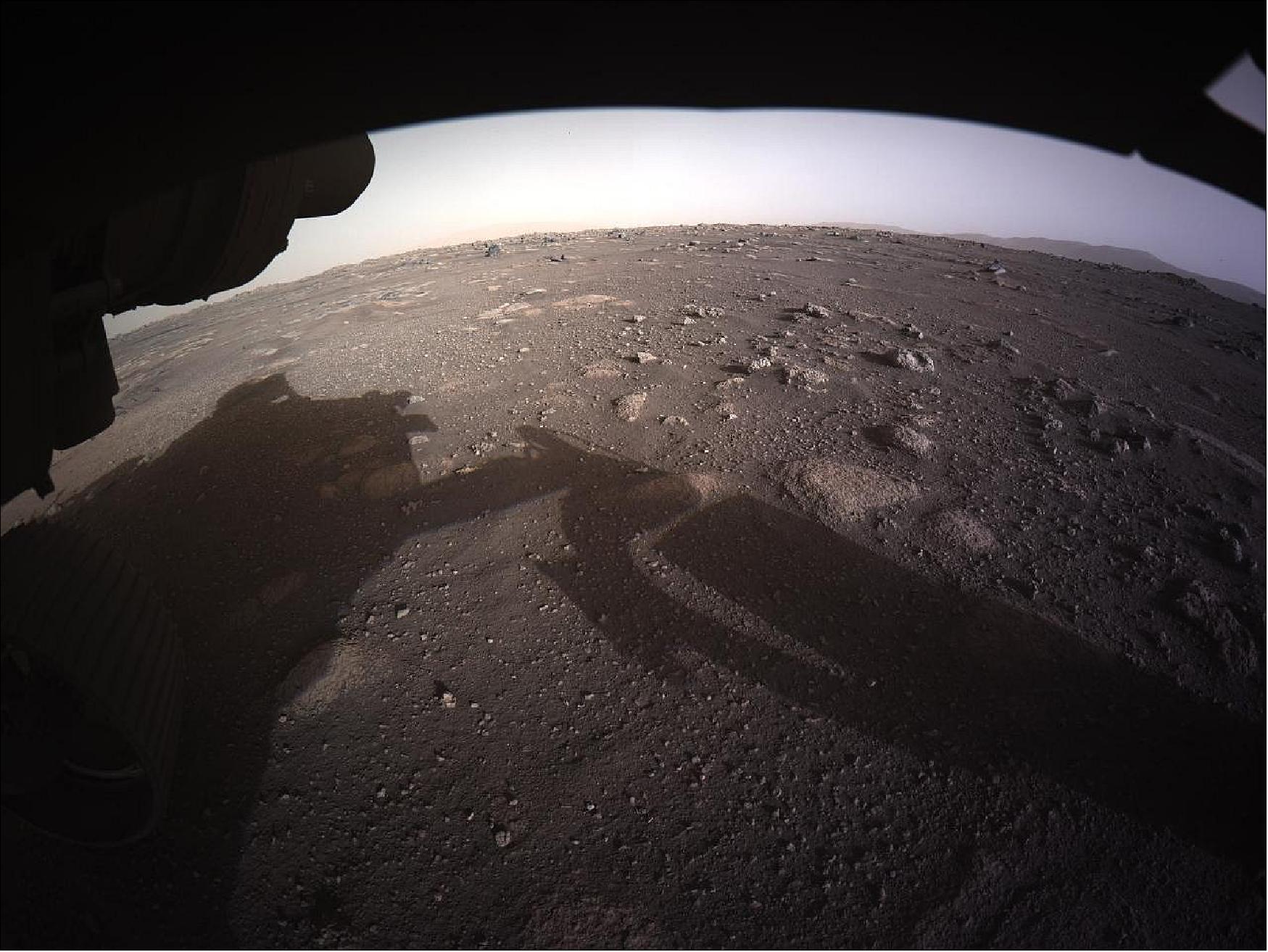
• February 18, 2021: The agency's latest and most complex mission to the Red Planet has touched down at Jezero Crater. Now it's time to begin testing the health of the rover. 24)
- The largest, most advanced rover NASA has sent to another world touched down on Mars Thursday, after a 203-day journey traversing 293 million miles (472 million kilometers). Confirmation of the successful touchdown was announced in mission control at NASA's Jet Propulsion Laboratory in Southern California at 3:55 p.m. EST (12:55 p.m. PST).
- Packed with groundbreaking technology, the Mars 2020 mission launched July 30, 2020, from Cape Canaveral Space Force Station in Florida. The Perseverance rover mission marks an ambitious first step in the effort to collect Mars samples and return them to Earth.
- "This landing is one of those pivotal moments for NASA, the United States, and space exploration globally – when we know we are on the cusp of discovery and sharpening our pencils, so to speak, to rewrite the textbooks," said acting NASA Administrator Steve Jurczyk. "The Mars 2020 Perseverance mission embodies our nation's spirit of persevering even in the most challenging of situations, inspiring, and advancing science and exploration. The mission itself personifies the human ideal of persevering toward the future and will help us prepare for human exploration of the Red Planet."
Figure 46: After a seven-month-long journey, NASA's Perseverance Rover successfully touched down on the Red Planet on Feb. 18, 2021. Mission controllers at NASA's Jet Propulsion Laboratory in Southern California celebrate landing NASA's fifth — and most ambitious — rover on Mars (video credit: NASA/JPL-Caltech)
- About the size of a car, the 2,263-pound (1,026 kg) robotic geologist and astrobiologist will undergo several weeks of testing before it begins its two-year science investigation of Mars' Jezero Crater. While the rover will investigate the rock and sediment of Jezero's ancient lakebed and river delta to characterize the region's geology and past climate, a fundamental part of its mission is astrobiology, including the search for signs of ancient microbial life. To that end, the Mars Sample Return campaign, being planned by NASA and ESA (European Space Agency), will allow scientists on Earth to study samples collected by Perseverance to search for definitive signs of past life using instruments too large and complex to send to the Red Planet.
- "Because of today's exciting events, the first pristine samples from carefully documented locations on another planet are another step closer to being returned to Earth," said Thomas Zurbuchen, associate administrator for science at NASA. "Perseverance is the first step in bringing back rock and regolith from Mars. We don't know what these pristine samples from Mars will tell us. But what they could tell us is monumental – including that life might have once existed beyond Earth."
- Some 28 miles (45 km) wide, Jezero Crater sits on the western edge of Isidis Planitia, a giant impact basin just north of the Martian equator. Scientists have determined that 3.5 billion years ago the crater had its own river delta and was filled with water.
- The power system that provides electricity and heat for Perseverance through its exploration of Jezero Crater is a Multi-Mission Radioisotope Thermoelectric Generator, or MMRTG. The U.S. Department of Energy (DOE) provided it to NASA through an ongoing partnership to develop power systems for civil space applications.
- Equipped with seven primary science instruments, the most cameras ever sent to Mars, and its exquisitely complex sample caching system – the first of its kind sent into space – Perseverance will scour the Jezero region for fossilized remains of ancient microscopic Martian life, taking samples along the way.
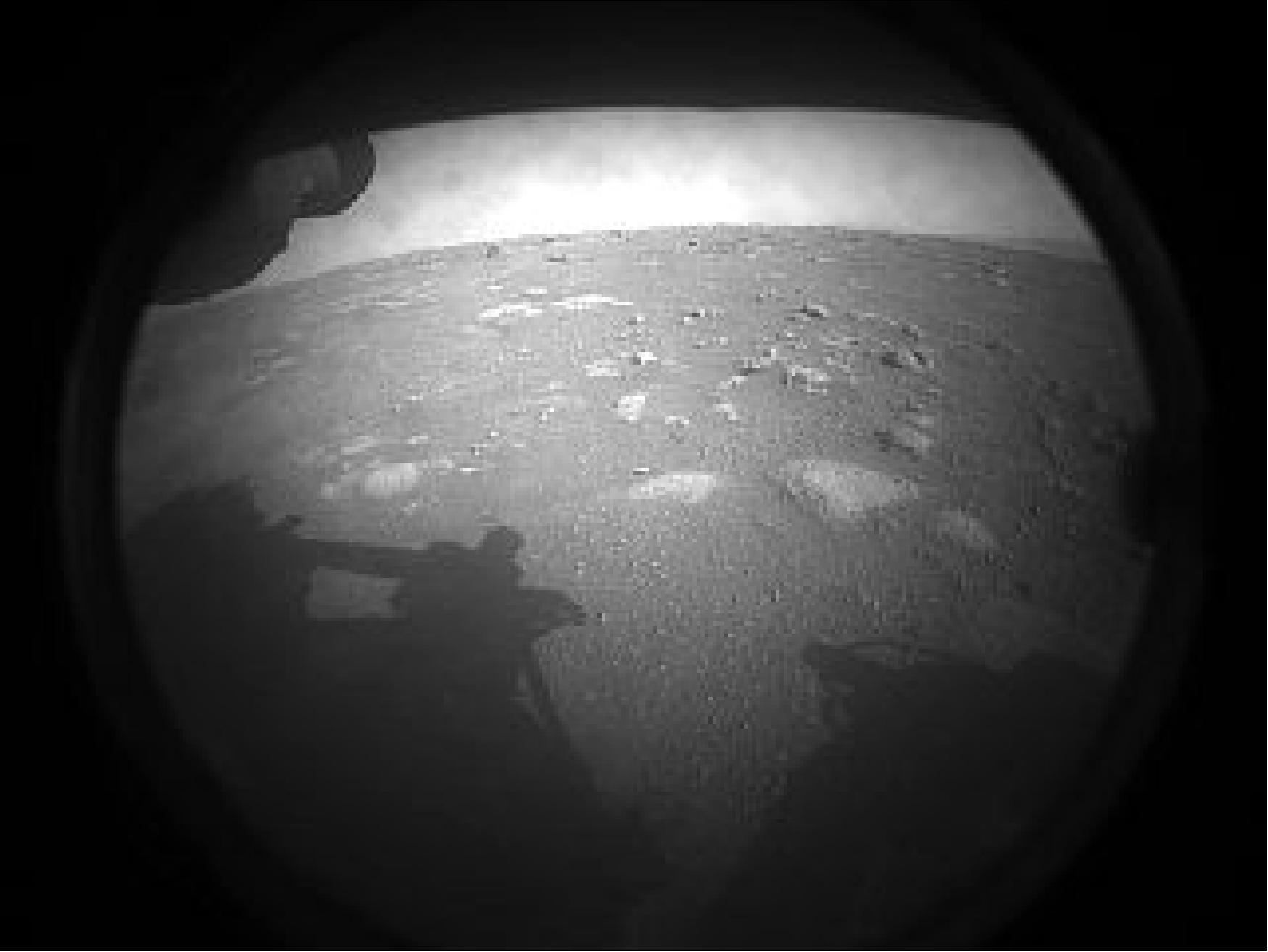
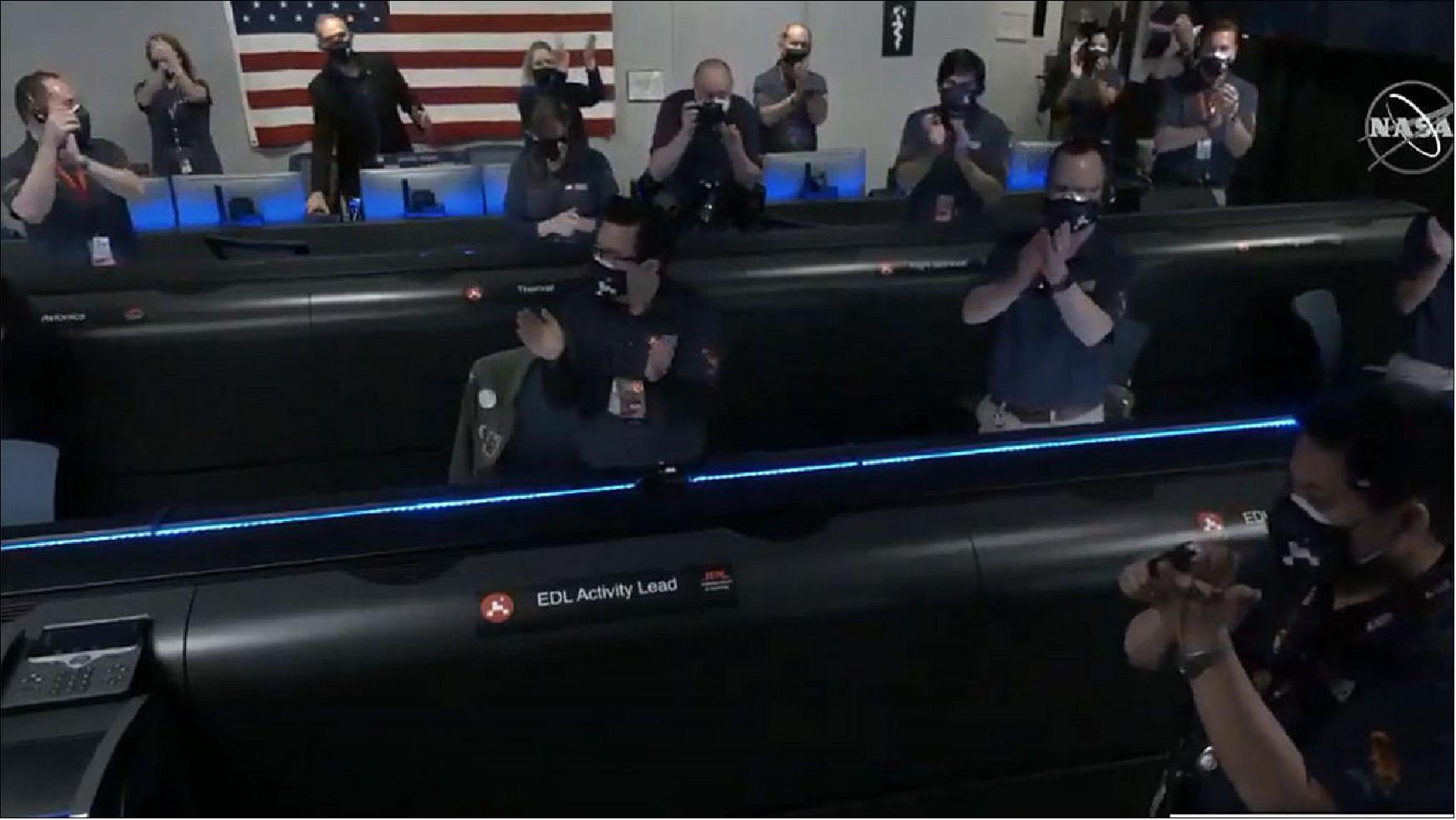
- "Perseverance is the most sophisticated robotic geologist ever made, but verifying that microscopic life once existed carries an enormous burden of proof," said Lori Glaze, director of NASA's Planetary Science Division. "While we'll learn a lot with the great instruments we have aboard the rover, it may very well require the far more capable laboratories and instruments back here on Earth to tell us whether our samples carry evidence that Mars once harbored life."
Paving the Way for Human Missions
- "Landing on Mars is always an incredibly difficult task and we are proud to continue building on our past success," said JPL Director Michael Watkins. "But, while Perseverance advances that success, this rover is also blazing its own path and daring new challenges in the surface mission. We built the rover not just to land but to find and collect the best scientific samples for return to Earth, and its incredibly complex sampling system and autonomy not only enable that mission, they set the stage for future robotic and crewed missions."
- The Mars Entry, Descent, and Landing Instrumentation 2 (MEDLI2) sensor suite collected data about Mars' atmosphere during entry, and the Terrain-Relative Navigation system autonomously guided the spacecraft during final descent. The data from both are expected to help future human missions land on other worlds more safely and with larger payloads.
- On the surface of Mars, Perseverance's science instruments will have an opportunity to scientifically shine. Mastcam-Z is a pair of zoomable science cameras on Perseverance's remote sensing mast, or head, that creates high-resolution, color 3D panoramas of the Martian landscape. Also located on the mast, the SuperCam uses a pulsed laser to study the chemistry of rocks and sediment and has its own microphone to help scientists better understand the property of the rocks, including their hardness.
- Located on a turret at the end of the rover's robotic arm, the Planetary Instrument for X-ray Lithochemistry (PIXL) and the Scanning Habitable Environments with Raman & Luminescence for Organics & Chemicals (SHERLOC) instruments will work together to collect data on Mars' geology close-up. PIXL will use an X-ray beam and suite of sensors to delve into a rock's elemental chemistry. SHERLOC's ultraviolet laser and spectrometer, along with its Wide Angle Topographic Sensor for Operations and eNgineering (WATSON) imager, will study rock surfaces, mapping out the presence of certain minerals and organic molecules, which are the carbon-based building blocks of life on Earth.
- The rover chassis is home to three science instruments, as well. Radar Imager for Mars' Subsurface Experiment (RIMFAX) is the first ground-penetrating radar on the surface of Mars and will be used to determine how different layers of the Martian surface formed over time. The data could help pave the way for future sensors that hunt for subsurface water ice deposits.
- Also with an eye on future Red Planet explorations, the Mars Oxygen In-Situ Resource Utilization Experiment (MOXIE) technology demonstration will attempt to manufacture oxygen out of thin air – the Red Planet's tenuous and mostly carbon dioxide atmosphere. The rover's Mars Environmental Dynamics Analyzer (MEDA) instrument, which has sensors on the mast and chassis, will provide key information about present-day Mars weather, climate, and dust.
- Currently attached to the belly of Perseverance, the diminutive Ingenuity Mars Helicopter is a technology demonstration that will attempt the first powered, controlled flight on another planet.
- Project engineers and scientists will now put Perseverance through its paces, testing every instrument, subsystem, and subroutine over the next month or two. Only then will they deploy the helicopter to the surface for the flight test phase. If successful, Ingenuity could add an aerial dimension to exploration of the Red Planet in which such helicopters serve as a scouts or make deliveries for future astronauts away from their base.
- Once Ingenuity's test flights are complete, the rover's search for evidence of ancient microbial life will begin in earnest.
- "Perseverance is more than a rover, and more than this amazing collection of men and women that built it and got us here," said John McNamee, project manager of the Mars 2020 Perseverance rover mission at JPL. "It is even more than the 10.9 million people who signed up to be part of our mission. This mission is about what humans can achieve when they persevere. We made it this far. Now, watch us go."
More About the Mission
- A primary objective for Perseverance's mission on Mars is astrobiology research, including the search for signs of ancient microbial life. The rover will characterize the planet's geology and past climate and be the first mission to collect and cache Martian rock and regolith, paving the way for human exploration of the Red Planet.
- Subsequent NASA missions, in cooperation with ESA, will send spacecraft to Mars to collect these cached samples from the surface and return them to Earth for in-depth analysis.
- The Mars 2020 Perseverance mission is part of NASA's Moon to Mars approach, which includes Artemis missions to the Moon that will help prepare for human exploration of the Red Planet.
- JPL, a division of Caltech in Pasadena, California, manages the Mars 2020 Perseverance mission and the Ingenuity Mars Helicopter technology demonstration for NASA.
• February 16, 2021: What to expect when the Mars 2020 Perseverance rover arrives at the Red Planet on Feb. 18, 2021. 25)
- With about 2.4 million miles (3.9 million km) left to travel in space, NASA's Mars 2020 Perseverance mission is days away from attempting to land the agency's fifth rover on the Red Planet. Engineers at NASA's Jet Propulsion Laboratory in Southern California, where the mission is managed, have confirmed that the spacecraft is healthy and on target to touch down in Jezero Crater at around 3:55 p.m. EST (12:55 p.m. PST) on Feb. 18, 2021.
- "Perseverance is NASA's most ambitious Mars rover mission yet, focused scientifically on finding out whether there was ever any life on Mars in the past," said Thomas Zurbuchen, associate administrator for the Science Mission Directorate at NASA Headquarters in Washington. "To answer this question, the landing team will have its hands full getting us to Jezero Crater – the most challenging Martian terrain ever targeted for a landing."
- Jezero is a basin where scientists believe an ancient river flowed into a lake and deposited sediments in a fan shape known as a delta. Scientists think the environment here was likely to have preserved signs of any life that gained a foothold billions of years ago – but Jezero also has steep cliffs, sand dunes, and boulder fields. Landing on Mars is difficult – only about 50% of all previous Mars landing attempts have succeeded – and these geological features make it even more so. The Perseverance team is building on lessons from previous touchdowns and employing new technologies that enable the spacecraft to target its landing site more accurately and avoid hazards autonomously.
- "The Perseverance team is putting the final touches on the complex choreography required to land in Jezero Crater," said Jennifer Trosper, deputy project manager for the mission at JPL. "No Mars landing is guaranteed, but we have been preparing a decade to put this rover's wheels down on the surface of Mars and get to work."
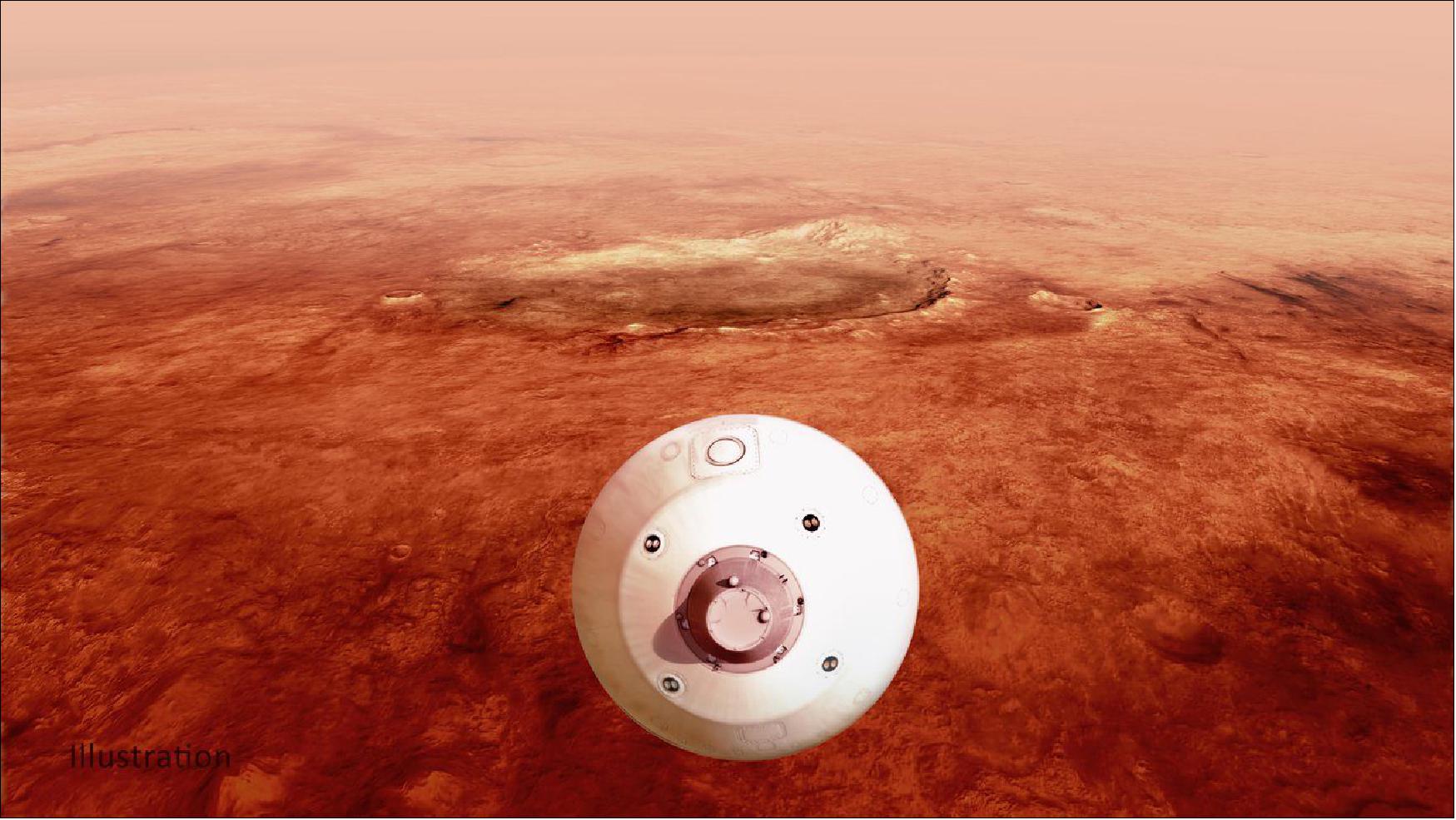
• February 8, 2021: After a nearly seven-month journey to Mars, NASA's Perseverance rover is slated to land at the Red Planet's Jezero Crater Feb. 18, 2021, a rugged expanse chosen for its scientific research and sample collection possibilities. 26)
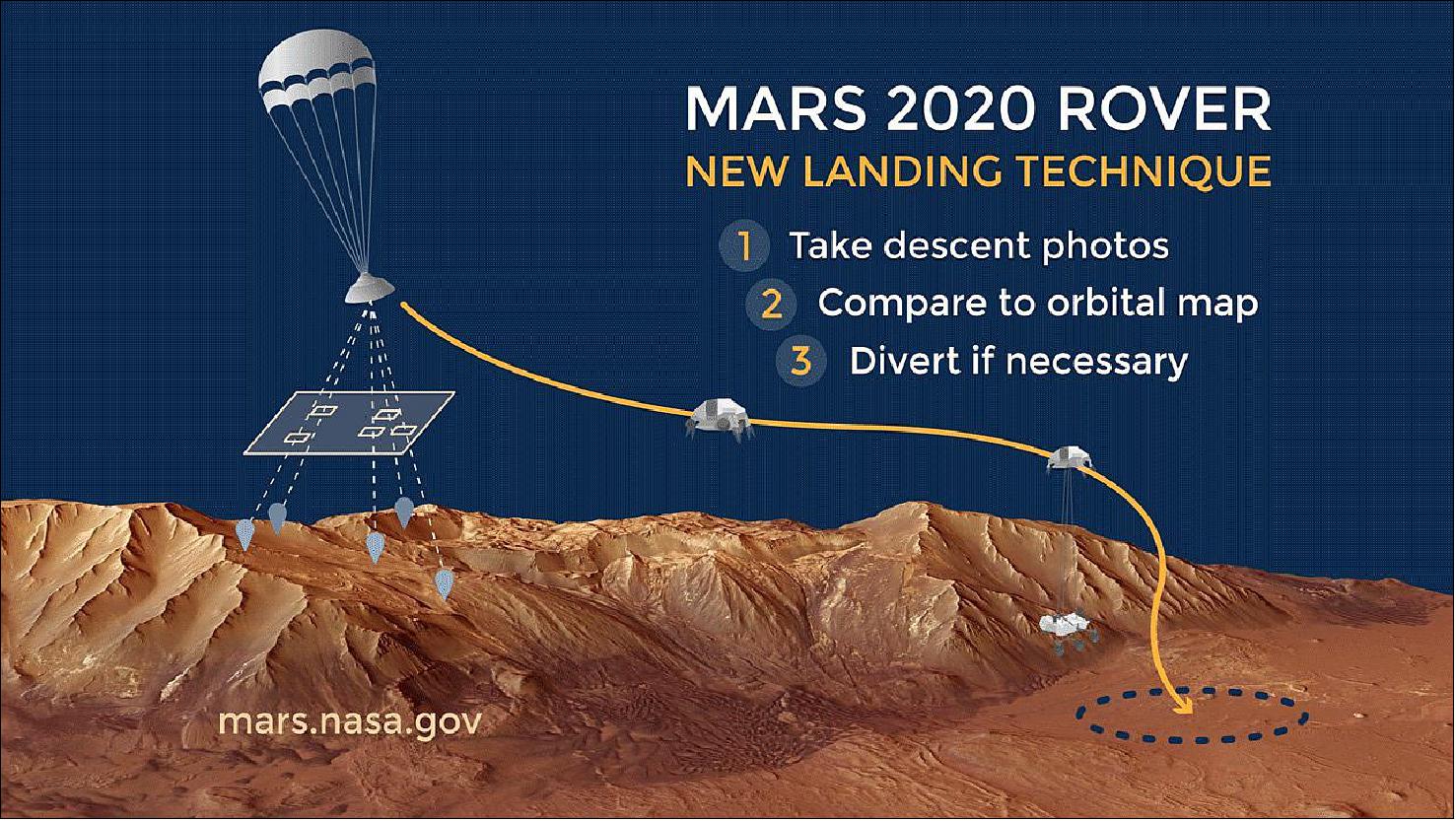
- But the very features that make the site fascinating to scientists also make it a relatively dangerous place to land – a challenge that has motivated rigorous testing here on Earth for the lander vision system (LVS) that the rover will count on to safely touch down.
- "Jezero is 28 miles wide, but within that expanse there are a lot of potential hazards the rover could encounter: hills, rock fields, dunes, the walls of the crater itself, to name just a few," said Andrew Johnson, principal robotics systems engineer at NASA's Jet Propulsion Laboratory in Southern California. "So, if you land on one of those hazards, it could be catastrophic to the whole mission."
- Enter Terrain-Relative Navigation (TRN), the mission-critical technology at the heart of the LVS that captures photos of the Mars terrain in real time and compares them with onboard maps of the landing area, autonomously directing the rover to divert around known hazards and obstacles as needed.
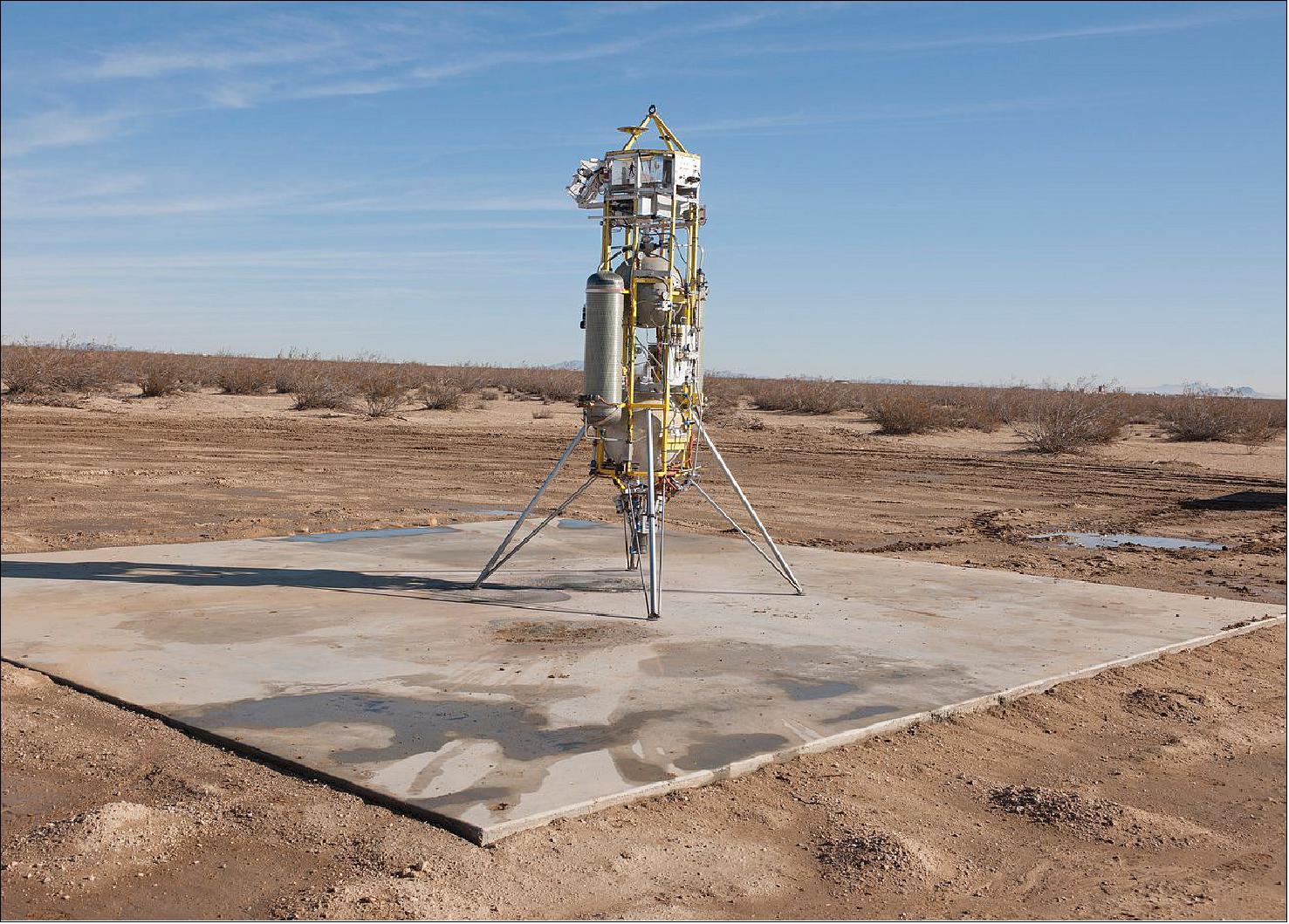
- "For Mars 2020, LVS will use the position information to figure out where the rover is relative to safe spots between those hazards. And in one of those safe spots is where the rover will touch down," explained Johnson.
- If Johnson sounds confident that LVS will work to land Perseverance safely, that's because it allows the rover to determine its position relative to the ground with an an accuracy of about 200 feet or less. That low margin of error and high degree of assurance are by design, and the result of extensive testing both in the lab and in the field.
- "We have what we call the trifecta of testing," explained JPL's Swati Mohan, guidance, navigation, and control operations lead for Mars 2020.
Figure 52: Landing NASA's Mars 2020 Rover with Terrain Relative Navigation. 2014 flight tests on Masten's Xombie VTVL system demonstrated the lander vision system's terrain-relative navigation and fuel-optimal large divert guidance (G-FOLD) capabilities. The flights proved the system's ability to autonomously change course to avoid hazards on descent and adopt a newly calculated path to a safe landing site. The successful field tests enabled the technology to be greenlighted for inclusion on NASA's Mars 2020 mission (video credit: NASA/JPL-Caltech)
- Mohan said that the first two testing areas – hardware and simulation – were done in a lab.
- "That's where we test every condition and variable we can. Vacuum, vibration, temperature, electrical compatibility – we put the hardware through its paces," said Mohan. "Then with simulation, we model various scenarios that the software algorithms may encounter on Mars – a too-sunny day, very dark day, windy day – and we make sure the system behaves as expected regardless of those conditions."
- But the third piece of the trifecta – the field tests – require actual flights to put the lab results through further rigor and provide a high level of technical readiness for NASA missions. For LVS's early flight tests, Johnson and team mounted the LVS to a helicopter and used it to estimate the vehicle's position automatically as it was flying.
- "That got us to a certain level of technical readiness because the system could monitor a wide range of terrain, but it didn't have the same kind of descent that Perseverance will have," said Johnson. "There was also a need to demonstrate LVS on a rocket."
- That need was met by NASA's Flight Opportunities program, which facilitated two 2014 flights in the Mojave Desert on Masten Space Systems' Xombie – a vertical takeoff and vertical landing (VTVL) system that functions similarly to a lander. The flight tests demonstrated LVS's ability to direct Xombie to autonomously change course and avoid hazards on descent by adopting a newly calculated path to a safe landing site. Earlier flights on Masten's VTVL system also helped validate algorithms and software used to calculate fuel-optimal trajectories for planetary landings.
- "Testing on the rocket laid pretty much all remaining doubts to rest and answered a critical question for the LVS operation affirmatively," said JPL's Nikolas Trawny, a payload and pointing control systems engineer who worked closely with Masten on the 2014 field tests. "It was then that we knew LVS would work during the high-speed vertical descent typical of Mars landings."
- Johnson added that the suborbital testing in fact increased the technology readiness level to get the final green light of acceptance into the Mars 2020 mission.
- "The testing that Flight Opportunities is set up to provide was really unprecedented within NASA at the time," said Johnson. "But it's proven so valuable that it's now becoming expected to do these types of flight tests. For LVS, those rocket flights were the capstone of our technology development effort."
- With the technology accepted for Mars 2020, the mission team began to build the final version of LVS that would fly on Perseverance. In 2019, a copy of that system flew on one more helicopter demonstration in Death Valley, California, facilitated by NASA's Technology Demonstration Missions program. The helicopter flight provided a final check on over six-years of multiple field tests.
- But Mohan pointed out that even with these successful demonstrations, there will be more work to do to ensure a safe landing. She'll be at Mission Control for the landing, monitoring the health of the system every step of the way.
- "Real life can always throw you curve balls. So, we'll be monitoring everything during the cruise phase, checking power to the camera, making sure the data is flowing as expected," Mohan said. "And once we get that signal from the rover that says, ‘I've landed and I'm on stable ground,' then we can celebrate."
About Flight Opportunities
- The Flight Opportunities program is funded by NASA's Space Technology Mission Directorate (STMD) and managed at NASA's Armstrong Flight Research Center in Edwards, California. NASA's Ames Research Center in California's Silicon Valley manages the solicitation and evaluation of technologies to be tested and demonstrated on commercial flight vehicles.
About Technology Demonstration Missions
- Also under the umbrella of STMD, the program is based at NASA's Marshall Space Flight Center in Huntsville, Alabama. The program bridges the gap between scientific and engineering challenges and the technological innovations needed to overcome them, enabling robust new space missions.
More About the Mission
- A key objective for Perseverance's mission on Mars is astrobiology, including the search for signs of ancient microbial life. The rover will characterize the planet's geology and past climate, pave the way for human exploration of the Red Planet, and be the first mission to collect and cache Martian rock and regolith (broken rock and dust).
- Subsequent missions, currently under consideration by NASA in cooperation with the European Space Agency, would send spacecraft to Mars to collect these cached samples from the surface and return them to Earth for in-depth analysis.
- The Mars 2020 mission is part of a larger program that includes missions to the Moon as a way to prepare for human exploration of the Red Planet. Charged with returning astronauts to the Moon by 2024, NASA will establish a sustained human presence on and around the Moon by 2028 through NASA's Artemis lunar exploration plans.
- JPL, which is managed for NASA by Caltech in Pasadena, California, built and manages operations of the Perseverance rover.
• January 13, 2021: When the Mars Perseverance rover lands on the Red Planet on Feb. 18, 2021, it will not only collect stunning images and rock samples; the data it returns may also include some recorded sounds from Mars. 27)
- The rover carries a pair of microphones, which – if all goes as planned – will provide interesting and historic audio of the arrival and landing at Mars, along with sounds of the rover at work and of wind and other ambient noise.
- The way many things sound on Earth would be slightly different on the Red Planet. That's because the Martian atmosphere is only 1% as dense as Earth's atmosphere at the surface and has a different makeup than ours, which affects sound emission and propagation. But the discrepancy between sounds on Earth and Mars would be much less dramatic than, for example, someone's voice before and after inhaling helium from a balloon.
- One microphone aboard Perseverance, located on the SuperCam instrument atop the rover's mast, will be used for science and to record audio of Perseverance and natural sounds on Mars. It will capture sounds of the rover's laser turning rock into plasma when it hits a target to gather information on rock properties, including hardness. Since the SuperCam microphone is located on the rover's remote sensing mast, it can be pointed in the direction of a potential sound source.
- "It is stunning all the science we can get with an instrument as simple as a microphone on Mars," said Baptiste Chide, a postdoctoral researcher in planetary science at NASA's Jet Propulsion Laboratory and a contributor to the SuperCam microphone.
- An additional experimental microphone aboard the rover will attempt to record sounds during the mission's super-tricky entry, descent, and landing (EDL). It may capture, for example, sounds of pyrotechnic devices firing to release the parachute, the Martian winds, wheels crunching down on the Martian surface, and the roaring engines of the descent vehicle as it flies safely away from the rover. This mic is off-the-shelf, with one tweak. "We put a little grid at the end of the microphone to protect it from Martian dust," said Dave Gruel, the Mars 2020 assembly, testing, and launch operations manager and lead for the EDL camera and microphone at JPL.
A Sounding Board for Mars Audio
- SuperCam science team members helped with this interactive experience, providing the scientific lowdown on why audio sounds are different on Mars than on Earth. It is based on theoretical models of sound propagation in a Martian atmosphere.
- The scientists provide three main reasons for the sound differences:
a) Temperature: The colder Martian atmosphere lowers the speed at which sound waves reach the destination microphone. If something is close to the microphone, we probably won't notice much difference, but more distant sounds may have more noticeable changes.
b) Density: Because the Martian atmosphere is much less dense than ours here on Earth, it will affect how sound waves travel from the source to the detector. Sounds will likely be quieter on Mars, with less signal and noise detectable. It may be harder to hear quiet noises and even some louder ones.
c) Composition of the atmosphere: Because the Mars atmosphere is mostly carbon dioxide (Earth's atmosphere is mostly nitrogen and oxygen), higher-frequency noises will likely be more attenuated than bass pitches, meaning we probably won't hear them as well as lower-pitched sounds.
- Chide said, "Sounds on Mars are slightly different than they are on Earth because of the atmospheric composition and its properties. All sounds will be lower in volume due to the low pressure. In addition, the higher-frequency tones will be strongly attenuated by the carbon dioxide molecules. All in all, it would be like listening through a wall."
- Because we've never successfully used microphones on Mars before, this experiment may yield some surprises. While scientists are trying to predict as well as they can how things will sound, they won't know for sure until Perseverance is on the Red Planet. Whatever they find out, Gruel said, "I think it's going to be real neat to actually hear sounds from another planet."
- "Recording audible sounds on Mars is a unique experience," added Chide. "With the microphones onboard Perseverance, we will add a fifth sense to Mars exploration. It will open a new area of science investigation for both the atmosphere and the surface."
- The first sounds may be beamed back to Earth and available for the public to hear within days of landing, with a more processed version released about a week after that. The team will process the sounds, with the help of audio experts, to more clearly hear the most interesting sounds.
• November 24, 2020: NASA's Perseverance rover carries a device to convert Martian air into oxygen that, if produced on a larger scale, could be used not just for breathing, but also for fuel. 28)
- One of the hardest things about sending astronauts to Mars will be getting them home. Launching a rocket off the surface of the Red Planet will require industrial quantities of oxygen, a crucial part of propellant: A crew of four would need about 55,000 pounds (25 metric tons) of it to produce thrust from 15,000 pounds (7 metric tons) of rocket fuel.
- That's a lot of propellant. But instead of shipping all that oxygen, what if the crew could make it out of thin (Martian) air? A first-generation oxygen generator aboard NASA's Perseverance rover will test technology for doing exactly that.
- MOXIE (Mars Oxygen In-Situ Resource Utilization Experiment) is an experimental instrument that stands apart from Perseverance's primary science. One of the rover's main purposes is capturing returnable rock samples that could carry signs of ancient microbial life. While Perseverance has a suite of instruments geared toward helping achieve that goal, MOXIE is focused solely on the engineering required for future human exploration efforts.
- Since the dawn of the space age, researchers have talked about in-situ resource utilization, or ISRU. Think of it as living off the land and using what's available in the local environment. That includes things like finding water ice that could be melted for use or sheltering in caves, but also generating oxygen for rocket fuel and, of course, breathing.
- Breathing is just a side benefit of MOXIE's true goal, said Michael Hecht of the Massachusetts Institute of Technology, the instrument's principal investigator. Rocket propellant is the heaviest consumable resource that astronauts will need, so being able to produce oxygen at their destination would make the first crewed trip to Mars easier, safer, and cheaper.
- "What people typically ask me is whether MOXIE is being developed so astronauts have something to breathe," Hecht said. "But rockets breathe hundreds of times as much oxygen as people."
Making Oxygen Requires Heat
- Mars' atmosphere poses a major challenge for human life and rocket propellant production. It's only 1% as thick as Earth's atmosphere and is 95% carbon dioxide.
- MOXIE pulls in that air with a pump, then uses an electrochemical process to separate two oxygen atoms from each molecule of CO2 (Carbon Dioxide). As the gases flow through the system, they are analyzed to check how much oxygen has been produced, how pure it is, and how efficiently the system is working. All the gases are vented back into the atmosphere after each experiment is run.
- Powering this electrochemical conversion requires a lot of heat - about 1,470º Fahrenheit (800º Celsius). Because of those high temperatures, MOXIE, which is a little larger than a toaster, features a variety of heat-tolerant materials. Special 3D-printed nickel alloy parts help distribute the heat within the instrument, while superlight insulation called aerogel minimizes the power needed to keep it at operating temperatures. The outside of MOXIE is coated in a thin layer of gold, which is an excellent reflector of infrared heat and keeps those blistering temperatures from radiating into other parts of Perseverance.
- "MOXIE is designed to make about 6 to 10 grams of oxygen per hour - just about enough for a small dog to breathe," said Asad Aboobaker, a MOXIE systems engineer at NASA's Jet Propulsion Laboratory in Southern California. "A full-scale system geared to make (propellant for the flight home) would need to scale up oxygen production by about 200 times what MOXIE will create."
The Future Martians
- Hecht estimates that a full-scale MOXIE system on Mars might be a bit larger than a household stove with a mass of ~1,000 kg - almost as much as Perseverance itself. Work is ongoing to develop a prototype for one in the near future.
- The team expects to run MOXIE about 10 times over the course of one Mars year (two Earth years), allowing them to watch how well it works in varying seasons. The results will inform the design of future oxygen generators.
- "The commitment to developing MOXIE shows that NASA is serious about this," Hecht said. "MOXIE isn't the complete answer, but it's a critical piece of it. If successful, it will show that future astronauts can rely on this technology to help get them home safely from Mars."
More About the Mission
- A key objective for Perseverance's mission on Mars is astrobiology, including the search for signs of ancient microbial life. The rover will characterize the planet's geology and past climate, pave the way for human exploration of the Red Planet, and be the first mission to collect and cache Martian rock and regolith (broken rock and dust).
- Subsequent missions, currently under consideration by NASA in cooperation with ESA (European Space Agency), would send spacecraft to Mars to collect these cached samples from the surface and return them to Earth for in-depth analysis.
- The Mars 2020 mission is part of a larger program that includes missions to the Moon as a way to prepare for human exploration of the Red Planet. Charged with returning astronauts to the Moon by 2024, NASA will establish a sustained human presence on and around the Moon by 2028 through NASA's Artemis lunar exploration plans.
- JPL, which is managed for NASA by Caltech in Pasadena, California, built and manages operations of the Perseverance rover.
• October 27, 2020: NASA's Mars 2020 Perseverance rover mission has logged a lot of flight miles since being lofted skyward on July 30 - 146.3 million miles (235.4 million km) to be exact. Turns out that is exactly the same distance it has to go before the spacecraft hits the Red Planet's atmosphere like a 11,900 mph (19,000 km/h) freight train on Feb. 18, 2021. 29)
- The Sun's gravitational influence plays a significant role in shaping not just spacecraft trajectories to Mars (as well as to everywhere else in the solar system), but also the relative movement of the two planets. So Perseverance's route to the Red Planet follows a curved trajectory rather than an arrow-straight path.
Work Continues En Route
- The mission team continues to check out spacecraft systems big and small during interplanetary cruise. Perseverance's RIMFAX and MOXIE instruments were tested and determined to be in good shape on Oct. 15. MEDA got a thumbs up on Oct. 19. There was even a line item to check the condition of the X-ray tube in the PIXL instrument on Oct. 16, which also went as planned.
- "If it is part of our spacecraft and electricity runs through it, we want to confirm it is still working properly following launch," said Keith Comeaux, deputy chief engineer for the Mars 2020 Perseverance rover mission. "Between these checkouts - along with charging the rover's and Mars Helicopter's batteries, uploading files and sequences for surface operations, and planning for and executing trajectory correction maneuvers - our plate is full right up to landing."
More About the Mission
- A key objective of Perseverance's mission on Mars is astrobiology, including the search for signs of ancient microbial life. The rover will characterize the planet's geology and past climate, pave the way for human exploration of the Red Planet, and be the first mission to collect and cache Martian rock and regolith (broken rock and dust).
- Subsequent missions, currently under consideration by NASA in cooperation with ESA (European Space Agency), would send spacecraft to Mars to collect these cached samples from the surface and return them to Earth for in-depth analysis.
- The Mars 2020 mission is part of a larger program that includes missions to the Moon as a way to prepare for human exploration of the Red Planet. Charged with returning astronauts to the Moon by 2024, NASA will establish a sustained human presence on and around the Moon by 2028 through NASA's Artemis lunar exploration plans.
• September 28, 2020: Perseverance is one of a few Mars spacecraft carrying laser retroreflectors. The devices could provide new science and safer Mars landings in the future. 30)
- When the Apollo astronauts landed on the Moon, they brought devices with them called retroreflectors, which are essentially small arrays of mirrors. The plan was for scientists on Earth to aim lasers at them and calculate the time it took for the beams to return. This provided exceptionally precise measurements of the Moon's orbit and shape, including how it changed slightly based on Earth's gravitational pull.
- Research with these Apollo-era lunar retroreflectors continues to this day, and scientists want to perform similar experiments on Mars. NASA's Perseverance rover – scheduled to land on the Red Planet on Feb. 18, 2021 – carries the palm-size Laser Retroreflector Array (LaRA). There's also small one aboard the agency's InSight lander, called Laser Retroreflector for InSight (LaRRI). And a retroreflector will be aboard the ESA (European Space Agency) ExoMars rover that launches in 2022.
- While there is currently no laser in the works for this sort of Mars research, the devices are geared toward the future: Reflectors like these could one day enable scientists conducting what is called laser-ranging research to measure the position of a rover on the Martian surface, test Einstein's theory of general relativity, and help make future landings on the Red Planet more precise.
- "Laser retroreflectors are shiny, pointlike position markers," said Simone Dell'Agnello, who led development of all three retroreflectors at Italy's National Institute for Nuclear Physics, which built the devices on behalf of the Italian Space Agency. "Because they're simple and maintenance-free, they can work for decades."
A Box of Mirrors
- The devices work a lot like a bike reflector, bouncing light back in the direction of its source. Perseverance's LaRA, for example, is a 2-inch-wide (5-cm-wide) dome speckled with half-inch holes containing glass cells. In each cell, three mirrored faces are positioned at 90-degree angles from one another so that light entering the holes is directed back out at exactly the same direction it came from.
- LaRA is much smaller than the retroreflectors on the Moon. The earliest ones, delivered by the Apollo 11 and 14 missions, are about the size of typical computer monitor and embedded with 100 reflectors; the ones delivered by Apollo 15 are even larger and embedded with 300 reflectors. That's because the lasers have to travel as much as 478,000 miles (770,000 km) to the Moon and back. By the return trip, the beams are so faint, they can't be detected by the human eye.
- The beams that Perseverance's LaRA and InSight's LaRRI were built to reflect would actually have a far shorter journey, despite Mars being some 249 million miles (401 million km) away at its farthest point from Earth. Rather than traveling back and forth from Earth, which would require enormous retroreflectors, the laser beams would just need to travel back and forth from a future Mars orbiter equipped with an appropriate laser.
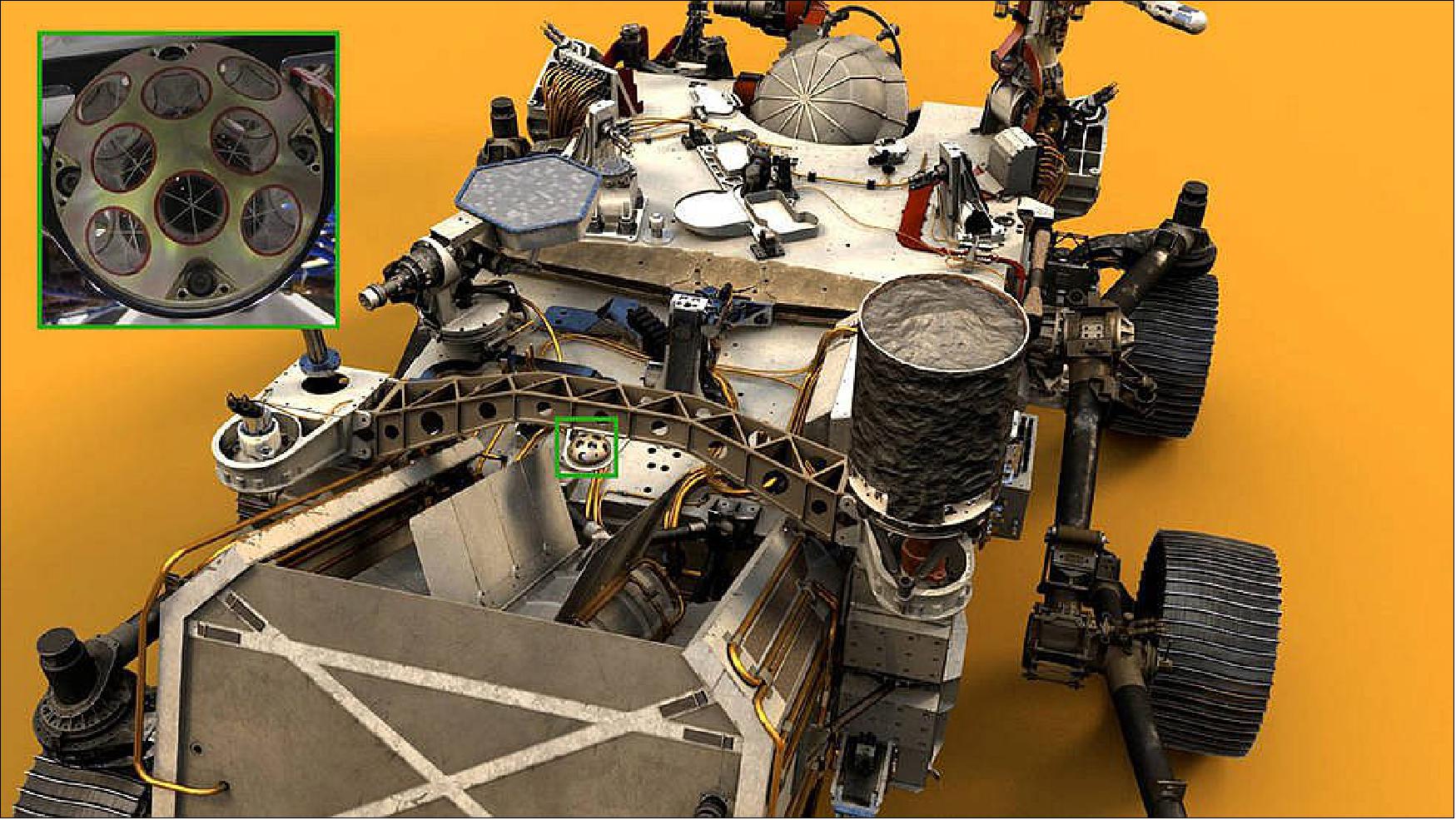
Illuminating Science
- Such an orbiter could determine the precise position of a retroreflector on the Martian surface. And since Perseverance will be mobile, it could provide multiple points of reference. Meanwhile, the orbiter's position would also be tracked from Earth. This would allow scientists to test Einstein's theory of general relativity, as they have with retroreflectors on the Moon. Each planet's orbit is greatly influenced by the bend in space-time created by the Sun's large mass.
- "This kind of science is important for understanding how gravity shapes our solar system, the whole universe, and ultimately the roles of dark matter and dark energy," Dell'Agnello noted.
- In the case of the InSight lander, which touched down on Nov. 26, 2018, laser-ranging science could also aid the spacecraft's core mission of studying Mars' deep interior. InSight relies on a radio instrument to detect subtle differences in the planet's rotation. In learning from the instrument how the planet wobbles over time, scientists may finally determine whether Mars' core is liquid or solid.
- And if the science team were able to use the lander's retroreflector, they could get even more precise positioning data than InSight's radio provides. LaRRI could also detect how the terrain InSight sits on shifts over time and in what direction, revealing how the Martian crust expands or contracts.
Better Landings on Mars
- Mars landings are hard. To help get Perseverance safely to the surface, the mission will rely on Terrain-Relative Navigation, a new technology that compares images taken during descent to an onboard map. If the spacecraft sees itself getting too close to danger (like a cliffside or sand dunes), it can veer away.
- But in such a mission-critical event, you can never have too many backups. Future missions barreling toward the surface of the Red Planet could use the series of reference points from laser retroreflectors as a check on the performance of their Terrain Relative Navigation systems – and perhaps even boost their accuracy down to a few centimeters. When the difference between successfully landing near an enticing geological formation or slipping down the steep slope of a crater wall can be measured in mere feet, retroreflectors might be critical.
- "Laser ranging could open up new kinds of Mars exploration," Dell'Agnello said.
• August 13, 2020: NASA's Ingenuity Mars Helicopter received a checkout and recharge of its power system on Friday, August 7, one week into its near seven-month journey to Mars with the Perseverance rover. This marks the first time the helicopter has been powered up and its batteries have been charged in the space environment. 31)
- During the eight-hour operation, the performance of the rotorcraft's six lithium-ion batteries was analyzed as the team brought their charge level up to 35%. The project has determined a low charge state is optimal for battery health during the cruise to Mars.
- "This was a big milestone, as it was our first opportunity to turn on Ingenuity and give its electronics a 'test drive' since we launched on July 30," said Tim Canham, the operations lead for Mars Helicopter at NASA's Jet Propulsion Laboratory in Southern California. "Since everything went by the book, we'll perform the same activity about every two weeks to maintain an acceptable state of charge."
- The 2 kg helicopter - a combination of specially designed components and off-the-shelf parts - is currently stowed on Perseverance's belly and receives its charge from the rover's power supply. Once Ingenuity is deployed on Mars' surface after Perseverance touches down, its batteries will be charged solely by the helicopter's own solar panel. If Ingenuity survives the cold Martian nights during its preflight checkout, the team will proceed with testing.
- "This charge activity shows we have survived launch and that so far we can handle the harsh environment of interplanetary space," said MiMi Aung, the Ingenuity Mars Helicopter project manager at JPL. "We have a lot more firsts to go before we can attempt the first experimental flight test on another planet, but right now we are all feeling very good about the future."
- The small craft will have a 30-Martian-day (31-Earth-day) experimental flight-test window. If it succeeds, Ingenuity will prove that powered, controlled flight by an aircraft can be achieved at Mars, enabling future Mars missions to potentially add an aerial dimension to their explorations with second-generation rotorcraft.
• July 30, 2020: European scientists will help select rocks and soil from Mars in the search for life on our planetary neighbor. 32)
- Five European researchers are part of NASA's Mars 2020 science team to select the most promising martian samples bound for Earth.
- The mission to Mars launched today for its seven-month journey to the Red Planet. Once there, the team will guide the Perseverance rover as it hunts for evidence of ancient microbial life.
Figure 54: This video shows Jezero crater, the landing site of the NASA Mars 2020 Perseverance rover on the Red Planet, based on images from ESA's Mars Express mission. The planned landing area is marked with an orange ellipse. The animation was created using an image mosaic made from four single orbit observations obtained by the High Resolution Stereo Camera (HRSC) on Mars Express between 2004 and 2008. The mosaic combines data from the HRSC nadir and color channels; the nadir channel is aligned perpendicular to the surface of Mars, as if looking straight down at the surface. The mosaic image was then combined with topography information from the stereo channels of HRSC to generate a three-dimensional landscape, which was then recorded from different perspectives, as with a movie camera, to render the flight shown in the video. (video credit: ESA/DLR/FU Berlin, CC BY-SA 3.0 IGO ; Music: Björn Schreiner ; Soundtrack logo: Alicia Neesemann)
- The group is made up of researchers from Belgium, France, Sweden and the UK. "These top scientists from across Europe are experts on how to collect, analyze and read the history of the rocks under our feet. Now they will also have to anticipate the needs and challenges of working with martian samples returned to laboratories back on Earth," says ESA's Mars Sample Return acting program scientist Gerhard Kminek.
- For the next three years, the team will be at the core of a wider NASA team.
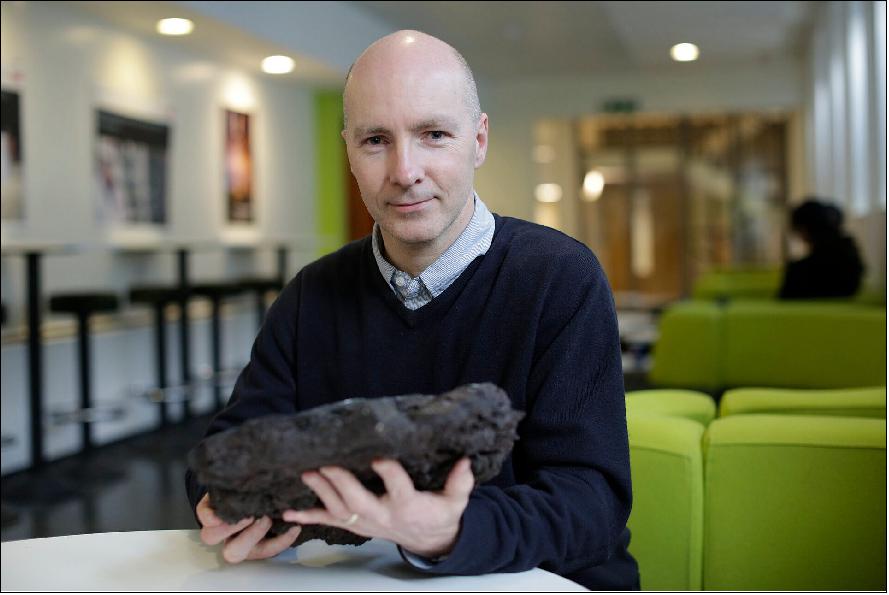
- Sandra Siljeström, from Sweden's research institute RISE, dreams of having the "Bring it to me now!" feeling while remotely analyzing a rock spotted on Mars at the rover landing site – the Jezero crater. Sandra has more than a decade of expertise in organic geochemistry.

- The area of the Jezero crater contains sediments of an ancient river delta, where evidence of past life could be preserved if it ever existed on the planet.
- Once the Perseverance rover retrieves samples of rock and soil from Mars, it will seal them in canisters and drop them on the surface to be collected by a future retrieval mission.
- "The Mars 2020 mission is the first step for the ultimate martian challenge: the Mars Sample Return campaign. NASA and ESA aim to deliver the material from the martian surface to Earth by 2031," adds Gerhard.
- To bring Mars samples to Earth, three carefully timed missions are required.
- NASA will deliver the ESA Sample Fetch Rover to the vicinity of the Mars 2020 landing site. This European rover will autonomously track down and collect up to 36 sample tubes deposited by Perseverance, and take them to NASA's Mars Ascent vehicle.

Figure 57: Overview of the ESA–NASA Mars Sample Return mission. Bringing samples from Mars is the logical next step for robotic exploration and it will require multiple missions that will be more challenging and more advanced than any robotic missions before. Accomplishments in robotic exploration in recent years have increased confidence in success – multiple launches will be necessary to deliver samples from Mars. ESA is working with NASA to explore mission concepts for an international Mars Sample Return campaign between 2020 and 2030. — Three launches will be necessary to accomplish landing, collecting, storing and finding samples and delivering them to Earth. NASA's Mars 2020 mission will explore the surface and rigorously document and store a set of samples in canisters in strategic areas to be retrieved later for flight to Earth. Two subsequent missions are foreseen to achieve this next step (image credit: ESA, K. Oldenburg)
References
1) ”NASA’s Perseverance Mars Rover Makes Surprising Discoveries,” NASA News, 15 December 2021, URL: https://www.jpl.nasa.gov/news/nasas-perseverance-mars-rover-makes-surprising-discoveries?utm_source=iContact&utm_medium=email&utm_campaign=nasajpl&utm_content=perseverance20211215-1
2) Rachel Berkowitz, ”Field notes from Mars’s latest roving explorer,” Physics Today, 11 November 2021, URL: https://physicstoday.scitation.org/do/10.1063/PT.6.1.20211111a/full/
3) ”With First Martian Samples Packed, Perseverance Initiates Remarkable Sample Return Mission,” NASA/JPL News, 12 October 2021, URL: https://www.jpl.nasa.gov/news/with-first-martian-samples-packed-perseverance-initiates-remarkable-sample-return-mission?utm_source=iContact&utm_medium=email&utm_campaign=nasajpl&utm_content=daily20211012-2
4) ”NASA’s Perseverance Sheds More Light on Jezero Crater’s Watery Past,” NASA/JPL, 7 October 2021, URL: https://www.jpl.nasa.gov/news/nasas-perseverance-sheds-more-light-on-jezero-craters-watery-past?utm_source=iContact&utm_medium=email&utm_campaign=nasajpl&utm_content=daily20211007-1
5) ”Touchdown! NASA's Mars Perseverance Rover Safely Lands on Red Planet,” NASA News, 18 February 2021, URL: https://mars.nasa.gov/news/8865/touchdown-nasas-mars-perseverance-rover-safely-lands-on-red-planet/
6) ”NASA’s Perseverance Rover Collects Puzzle Pieces of Mars’ History,” NASA/JPL, 10 September 2021, URL: https://www.jpl.nasa.gov/news/nasas-perseverance-rover-collects-puzzle-pieces-of-mars-history?utm_source=iContact&utm_medium=email&utm_campaign=nasajpl&utm_content=weekly20210910-4
7) ”NASA’s Perseverance Team Assessing First Mars Sampling Attempt,” NASA/JPL News, 6 August 2021, URL: https://www.jpl.nasa.gov/news/nasas-perseverance-team-assessing-first-mars-sampling-attempt?utm_source=iContact&utm_medium=email&utm_campaign=nasajpl&utm_content=weekly20210806-8
8) ”Signs of Life on Mars? NASA’s Perseverance Rover Begins the Hunt,” NASA Feature 2021-150, 20 July 2021, URL: https://www.jpl.nasa.gov/news/signs-of-life-on-mars-nasas-perseverance-rover-begins-the-hunt
9) Andrew Good, Karen Fox, Alana Johnson, ”NASA’s Mars Helicopter Reveals Intriguing Terrain for Rover Team,” NASA News, 12 July 2021, URL: https://www.jpl.nasa.gov/news/nasas-mars-helicopter-reveals-intriguing-terrain-for-rover-team?utm_source=iContact&utm_medium=email&utm_campaign=nasajpl&utm_content=mars20210712-1
10) NASA’s Perseverance Rover Begins Its First Science Campaign on Mars,” NASA/JPL, 09 June 2021, URL: https://www.jpl.nasa.gov/news/nasas-perseverance-rover-begins-its-first-science-campaign-on-mars?utm_source=iContact&utm_medium=email&utm_campaign=nasajpl&utm_content=perseverance20210609-1
11) Håvard Grip, ”Surviving an In-Flight Anomaly: What Happened on Ingenuity’s Sixth Flight,” NASA Mars Helicopter Tech Demo, 27 May 2021, URL: https://mars.nasa.gov/technology/helicopter/status/305/surviving-an-in-flight-anomaly-what-happened-on-ingenuitys-sixth-flight/
12) ”Perseverance’s Robotic Arm Starts Conducting Science,” NASA/JPL News, 11 May 2021, URL: https://www.jpl.nasa.gov/news/perseverances-robotic-arm-starts-conducting-science?utm_source=iContact&utm_medium=email&utm_campaign=nasajpl&utm_content=perseverance20210511-1
13) Alana Johnson, Karen Fox, DC Agle, ”NASA’s Ingenuity Mars Helicopter to Begin New Demonstration Phase,” NASA/JPL Press Release 21-051, 30 April 2021, URL: https://www.nasa.gov/press-release/nasa-s-ingenuity-mars-helicopter-to-begin-new-demonstration-phase
14) NASA’s Ingenuity Mars Helicopter Flies Faster, Farther on Third Flight,” NASA/JPL, 25 April 2021, URL: https://www.jpl.nasa.gov/news/nasas-ingenuity-mars-helicopter-flies-faster-farther-on-third-flight?utm_source=iContact&utm_medium=email&utm_campaign=nasajpl&utm_content=ingenuity20210425-1
15) ”NASA’s Ingenuity Mars Helicopter Logs Second Successful Flight,” NASA/JPL News Release 2021-089, 22 April 2021, URL: https://www.jpl.nasa.gov/news/nasas-ingenuity-mars-helicopter-logs-second-successful-flight
16) Karen Fox, Alana Johnson, Clare Skelly, Andrew Good, ”NASA’s Perseverance Mars Rover Extracts First Oxygen from Red Planet,” NASA Press Release 21-044, 21 April 2021, URL: https://www.nasa.gov/press-release/nasa-s-perseverance-mars-rover-extracts-first-oxygen-from-red-planet
17) ”NASA’s Ingenuity Mars Helicopter Succeeds in Historic First Flight,” NASA News Release: 2021-085, 19 April 2021, URL: https://Joplin's/news/nasas-ingenuity-mars-helicopter-succeeds-in-historic-first-flight
18) Alana Johnson, Grey Hautaluoma, DC Agle, ”NASA Ingenuity Mars Helicopter Prepares for First Flight,” NASA Press Release 21-033, 23 March 2021, URL: https://www.nasa.gov/press-release/nasa-ingenuity-mars-helicopter-prepares-for-first-flight
19) ”New Study Challenges Long-Held Theory of Fate of Mars’ Water,” NASA/JPL, 15 March, 2021, URL: https://www.jpl.nasa.gov/news/new-study-challenges-long-held-theory-of-fate-of-mars-water
20) ”NASA’s Perseverance Drives on Mars’ Terrain for First Time,” NASA/JPL, 5 March 2021: https://www.jpl.nasa.gov/news/nasas-perseverance-drives-on-mars-terrain-for-first-time?utm_source=iContact&utm_medium=email&utm_campaign=nasajpl&utm_content=perseverance20210305-1
21) Keith Koehler, ”Testing Proves Its Worth with Successful Mars Parachute Deployment,” NASA Feature, 25 February, 2021, URL: https://www.nasa.gov/wallops/2021/image-feature/testing-proves-its-worth-with-successful-mars-parachute-deployment
22) ”NASA's Mars Perseverance Rover Provides Front-Row Seat to Landing, First Audio Recording of Red Planet,” NASA/JPL, 22 February 2021, URL: https://www.jpl.nasa.gov/news/nasas-mars-perseverance-rover-provides-front-row-seat-to-landing-first-audio-recording-of-red-planet?utm_source=iContact&utm_medium=email&utm_campaign=nasajpl&utm_content=daily20210222.2-1
23) ”Perseverance's First Full-Color Look at Mars,” NASA/JPL, 19 February 2021, URL: https://www.jpl.nasa.gov/images/perseverances-first-full-color-look-at-mars
24) ”Touchdown! NASA's Mars Perseverance Rover Safely Lands on Red Planet,” NASA/JPL Press Release 21-018, 18 February 2021, URL: https://www.jpl.nasa.gov/news/touchdown-nasas-mars-perseverance-rover-safely-lands-on-red-planet?utm_source=iContact&utm_medium=email&utm_campaign=nasajpl&utm_content=perseverance20210218-1
25) ”NASA’s Next Mars Rover Is Ready for the Most Precise Landing Yet,” NASA/JPL, 16 February 2021, URL: https://www.jpl.nasa.gov/news/nasas-next-mars-rover-is-ready-for-the-most-precise-landing-yet?utm_source=iContact&utm_medium=email&utm_campaign=nasajpl&utm_content=perseverance20210216-1
26) DC Agle, ”Tricky Terrain: Helping to Assure a Safe Rover Landing,” NASA/JPL, 08 February 2021, URL: https://www.jpl.nasa.gov/news/tricky-terrain-helping-to-assure-a-safe-rover-landing?utm_source=iContact&utm_medium=email&utm_campaign=nasajpl&utm_content=perseverance20210208-1
27) ”Mars 2020 Perseverance Rover to Capture Sounds From the Red Planet,” NASA/JPL News, 13 January 2021, URL: https://www.jpl.nasa.gov/news/mars-2020-perseverance-rover-to-capture-sounds-from-the-red-planet/?utm_source=iContact&utm_medium=email&utm_campaign=nasajpl&utm_content=perseverance20210113-1
28) ”MOXIE Could Help Future Rockets Launch Off Mars,” NASA/JPL News, 24 November 2020, URL: https://www.jpl.nasa.gov/news/news.php?feature=7792&utm_source=iContact&utm_medium=email&utm_campaign=nasajpl&utm_content=perseverance20201124-1
29) ”NASA's Perseverance Rover Is Midway to Mars,” NASA/JPL News, 27 October 2020, URL: https://www.jpl.nasa.gov/news/news.php?feature=7770&utm_source=iContact&utm_medium=email&utm_campaign=nasajpl&utm_content=perseverance20201027-1
30) ”NASA's New Mars Rover Is Ready for Space Lasers,” NASA Mars Perseverance Rover, 28 September 2020, URL: https://www.nasa.gov/feature/jpl/nasas-new-mars-rover-is-ready-for-space-lasers
31) ”NASA's Ingenuity Mars Helicopter Recharges Its Batteries in Flight,” NASA/JPL, 13 August 2020, URL: https://www.jpl.nasa.gov/news/news.php?release=2020-157
32) ”A European dream team for Mars,” ESA Science & Exploration, 30 July 2020, URL: https://www.esa.int/Science_Exploration/Human_and_Robotic_Exploration/Exploration/A_European_dream_team_for_Mars
The information compiled and edited in this article was provided by Herbert J. Kramer from his documentation of: ”Observation of the Earth and Its Environment: Survey of Missions and Sensors” (Springer Verlag) as well as many other sources after the publication of the 4th edition in 2002. Comments and corrections to this article are always welcome for further updates (eoportal@symbios.space).